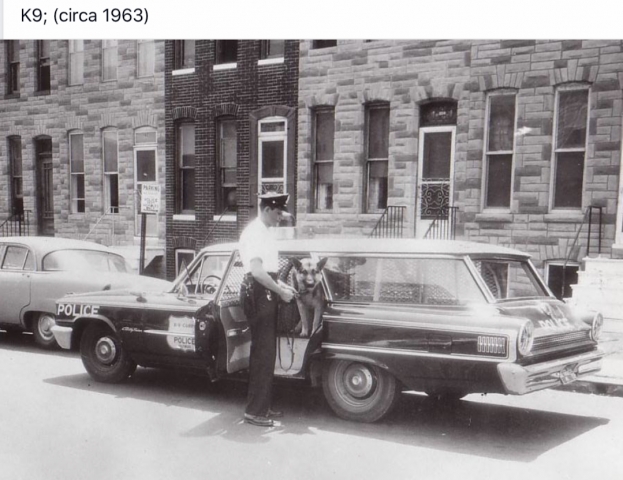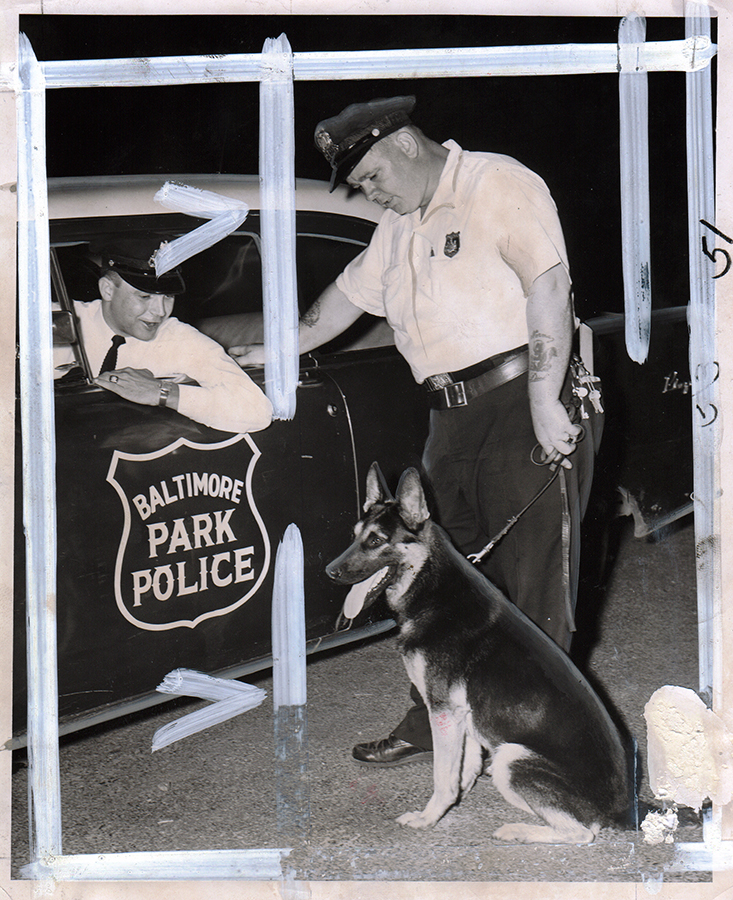K-9 Unit
On 11 December 1956, an article was published in one of our local newspapers written by Martin Millspaugh pertaining to Scotland Yard. This article, the last of a series was devoted to the use of police dogs in London. As a result of the letters and inquiries received by Commissioner James M. Hepbron, an article appeared in the Morning Sun on 17 December 1956, which briefly stated that Commissioner Hepbron was interested, and saw the possibilities of using dogs in the Baltimore City Police Department. A day later on the 18th of December two dogs that had had been previous trained were offered to the department and, with two officers also with previous dog experience, the program was put into effect on an experimental basis. By the middle of January 1957, fourteen dogs had been acquired as potential candidates and fourteen men were selected and assigned to the K~9 Corps. These men were chosen as a result of a questionnaire which was sent to all members of the department asking for volunteers. These men and dogs were trained daily until March 1, 1957. At that time, they were put on the street on Friday and Saturday nights, working the areas where the crime was most prevalent. Shortly after this, actually on April 17, 1957, ~ Commissioner Hepbron, considering the experiment a success, went before the Mayor and City Council and appropriations were made through the Board of Estimates which resulted in the K-9 Corps becoming a permanent part of the Baltimore City Police.
Baltimore City Police K-9 Unit
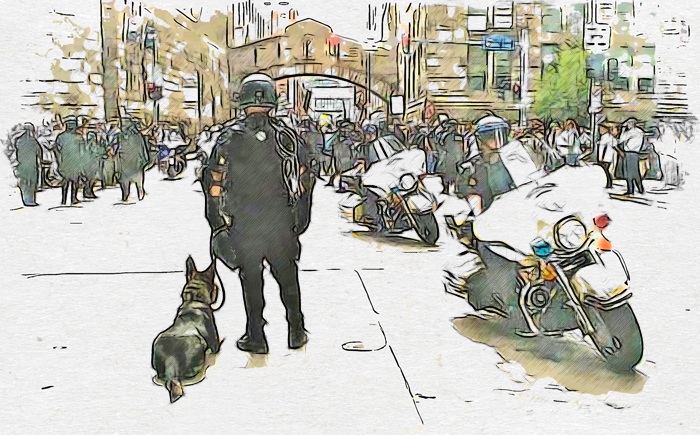
Baltimore Police K9 Training
America's Best K9 Training has for many years been known as the Baltimore System
BALTIMORE CITY POLICE DEPARTMENT
1. Inception
On Tuesday, December 11, 1956, an article was published in one of our local newspapers which was one of a series of articles written by one Martin Millspaugh pertaining to Scotland Yard. This article, the last of a series was devoted to the use of police dogs in London. As a result of the letters and inquiries received by Commissioner James M. Hepbron, an article appeared in the Morning Sun on December 17, 1956, which briefly stated that Commissioner Hepbron was interested and saw the possibilities of using dogs in the Baltimore City Police Department. On December 18, 1956, two dogs that had had previous training were offered to the Baltimore City Police Department and, with two officers also with previous dog experience, the program was put into effect on an experimental basis. By the middle of January 1957, fourteen dogs had been acquired as potential candidates and fourteen men were selected and assigned to the K~9 Corps. These men were chosen as a result of a questionnaire which was sent to all members of the department asking for volunteers. These men and dogs were trained daily until March 1, 1957. At that time, they were put on the street on Friday and Saturday nights, working the areas where the crime was most prevalent. Shortly after this, actually on April 17, 1957, ~ Commissioner Hepbron, considering the experiment a success, went before the Mayor and City Council and appropriations were made through the Board of Estimates which resulted in the K-9 Corps becoming a permanent part of the Baltimore City Police.
II. Administration
The administration of the Canine CK-9) Corps is under the direction of an Inspector of Police. A Lieutenant has been placed in command of the unit, and he has a civilian trainer assigned to him whose sole responsibility is the training of the officers and the dogs. There are also 2 sergeants assigned to the K-9 Corps who assist in the training program. These sergeants also monitor the activity of the K9 patrol force in the field under the direction of their commanding officer. These sergeants were selected on the basis of their qualifications, and previous knowledge and experience in training and handling dogs. The balance of the organization at present consists of 30 officers (patrolmen), a clerk and 40 dogs.
III. Method of Selection Officers
It must be kept in mind that an officer to work with a dog must want to do so - he cannot be forced into the job as his reactions to his work reflects in the animal. All officers, therefore, must volunteer, From this list, they are carefully screened and selected. First, they must meet certain requirements;
(a) They must live in their own home. This home must have adequate ground or a yard to house and care for a dog,
(b) The Officers wife and family must be investigated from a standpoint of willingness and approval.
(c) They must have available an automobile to use at all times.
(d) Their personnel record with the department must be good.
(e) Sufficient practical police experience or knowledge before being assigned to the unit.
IV. Cost
The cost of the K-9 Corps consists of the salary of the personnel assigned to the unit plus an estimated figure of $200 per year per dog. (This latter figure is based on the cost of food, equipment, and veterinary charges).
V. Procurement or Dogs
All dogs have been donated outright to the department for use in police work. They must be German Shepherd Dogs (male) sound of body, physically fit and of good even temperament • neither vicious nor shy, and preferably under 3 years of age.
VI. Kennel
No kennel facilities are provided. Each dog is assigned to an officer and from that point on lives with him at his home. The fact that the dog is with the officer constantly not only provides a closer bond of relationship between man and dog, but it also eliminates the necessity of the erection of expensive kennels and the personnel to staff same.
VII. Food
Food is purchased by the department and distributed to the individual officer as required. This food consists of a kennel biscuit and canned horse meat or beef.
VIII. Training
Bach officer is taught to train his own dog. The dog is first trained in basic obedience and tested for gun shyness. Next, attack work and then trailing (location of lost persons or criminals.)· Finally, the dog is trained to locate articles or materials that could be used as evidence, (It is extremely important in the attack training that the dog attacks only on command of his handler and releases immediately when told).
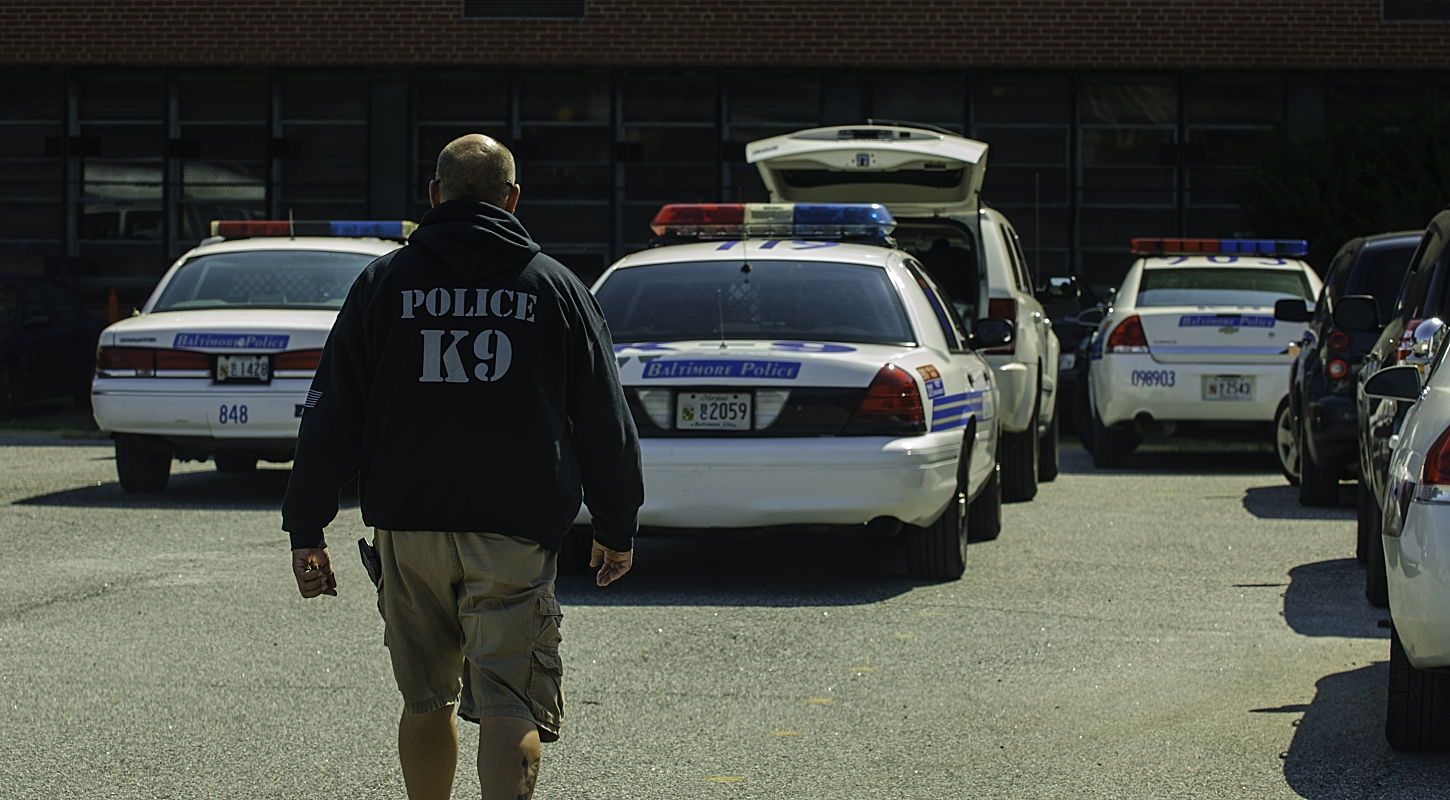
IX. Operation
Members of the K-9 Corps are assigned to the Headquarters Roster and they are available for use anywhere in the City. This unit operates on a three-shift basis Shifts #1 and #3 work concurrently between the hours of 6 PM and 2 AM Shift #2 works the hours of 8 AM to 4 PM. This results in an officer working two weeks of night work followed by one week of day work. There is also a small force operating on the streets in radio cars between the hours of 1 AM and 9 AM During the day shift the training of the men and dogs is intensified and developed. All men on the7 day shift are on a standby basis for emergencies, but, by the rotation method, a small force operates in radio-equipped vehicles and occasionally on foot, on the street during the daylight hours. (It is important that both officers and dogs continue in their training to keep up their effectiveness and to increase their ability). Officers of the Corps ·and their dogs are assigned to sections of the City where crime is most prevalent. They replace manpower due to the fact that additional officers need not be assigned to these areas. The actual area in which the dog is to operate is given to each District Commander via teletype on Monday of each week so that he can utilize the assignment of extra men to areas other than those covered by dogs. Primarily, a dog and officer work on foot and are assigned two posts instead of one. These dogs are always worked on a leash and only released when actually necessary to apprehend a criminal. However, 4 radio patrol cars are utilized - one being the Monitor Sergeant. The dogs ride in the cars with these officers and, being mobile, are very effective in taking calls anywhere in the City.
X. Types of Calls Handled by the K-9 Corps
Possibly the greatest value of police dogs lies in their mere presence on the street. The psychological effect has been tremendous and their deterrent effect on crime cannot be measured. Primarily they are assigned to areas where assaults; purse snatchings and yokings (muggings) are most prevalent. However, the dogs are very effective in dispersing and controlling crowds, in searching buildings, in assisting with arrests and the actual apprehension of criminals. They are also detailed (during visiting hours) in the vicinity of our hospitals as a preventive measure against purse snatchings and assaults, etc. Their function is not to replace the Post Officer, but to work in conjunction with him, keeping in mind that their effectiveness is greatest on the public streets and in the city parks.
XI. Public Exhibitions
Upon requests, the members of the Corps demonstrate the use of their trained dogs at both private and public functions throughout the city, and the adjacent counties. These exhibitions are most interesting and the requests have become so numerous that we find it impossible to comply with all of them. We have established excellent public relations through these.
XII. Summary
As of this date, the Baltimore City Police Department is utilizing the services of 40 trained dogs. At the present time, we have 18 officers and dogs patrolling the streets of Baltimore on foot each night, in addition, there are 4 radio patrol cars each with officer and dog. The Canine (K-9) Corps occupies a building formerly used as a Police Station. The detention cells in this building are occasionally used for housing our dogs. The building is spacious and contains ample space for expansion. Much of the training during inclement weather takes place in the basement of this building. There is also an out-of-doors fenced-in training area which is situated in one of our city parks within close proximity to our present quarters. The general public has accepted this program wholeheartedly and the press has been most cooperative. The entire program has had the desired effect, and that possibly can be summed up in this brief statement - "You can argue with a Police Officer, but you cannot argue with his dog."
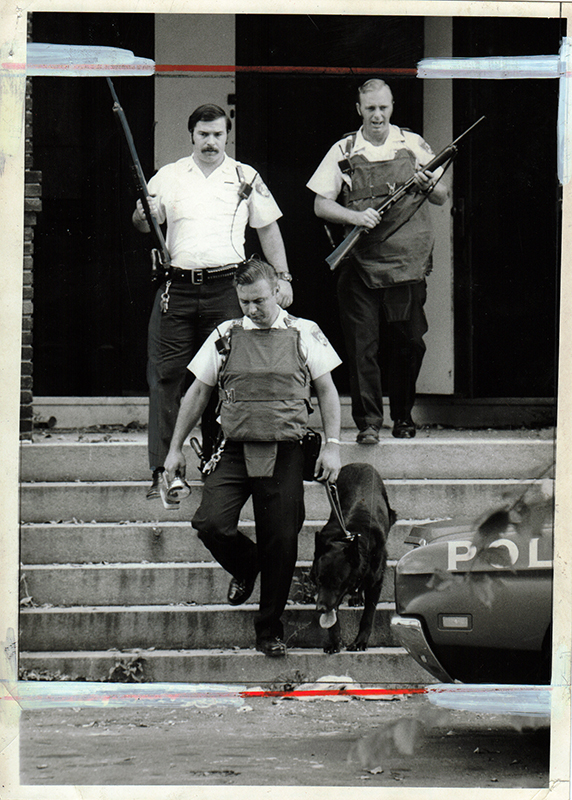
Courtesy of Mitch-Mike Paris
Officer Mitch-Mike Paris with Corporal
![]()
In 1956, Baltimore established the first effective municipal canine corps of modern times in the United States. At that time, the Deputy Chief of the Los Angeles Metropolitan Police Department Roger E. Murdock investigated the possibility of setting up a K9 corps in his city. Murdock concluded that police dogs do function effectively in certain types of operations, such as after-dark, foot patrolling in industrial areas. However, because there are relatively few such areas in Los Angeles, and because of the "motorized" character of its large" police force, Murdock felt that the benefits derivable from a canine corps in Los Angeles would not justify its cost. Consequently, the city decided
against establishing a corps.
PROCEDURE FOR ESTABLISHING
A CANINE CORPS
When a police department considers using police dogs, it must weigh these factors in arriving at a decision: the costs, the advantages, and disadvantages of the program, and the needs of the city.
Costs. Once the decision to establish a canine corps has been made, a city must provide in its budget for the best available training and equipment. The experience of Portland, Oregon, as described above illustrates the consequences of the failure to adequately finance a canine program.
For such a program to be successfully activated, a twofold information campaign should be conducted, one part aimed at the public and the other at police department personnel. By explaining the functions of the corps to the mass media, it is often possible to obtain their assistance in presenting the program to the public. This procedure costs the police agency very little. When the training period is over, it is advisable, even though expensive, to hold public demonstrations. The second part of the information campaign, the intra-department phase, should be designed to acquaint personnel with the canine program and to recruit volunteers for training as handlers. Usually, a brochure describing the program and the advantages of working in it, and setting forth the qualifications for becoming handlers, is the best way of introducing the program to the department. Later, after the program is established, additional brochures specifying situations in which the dogs might be called into action should be distributed periodically.
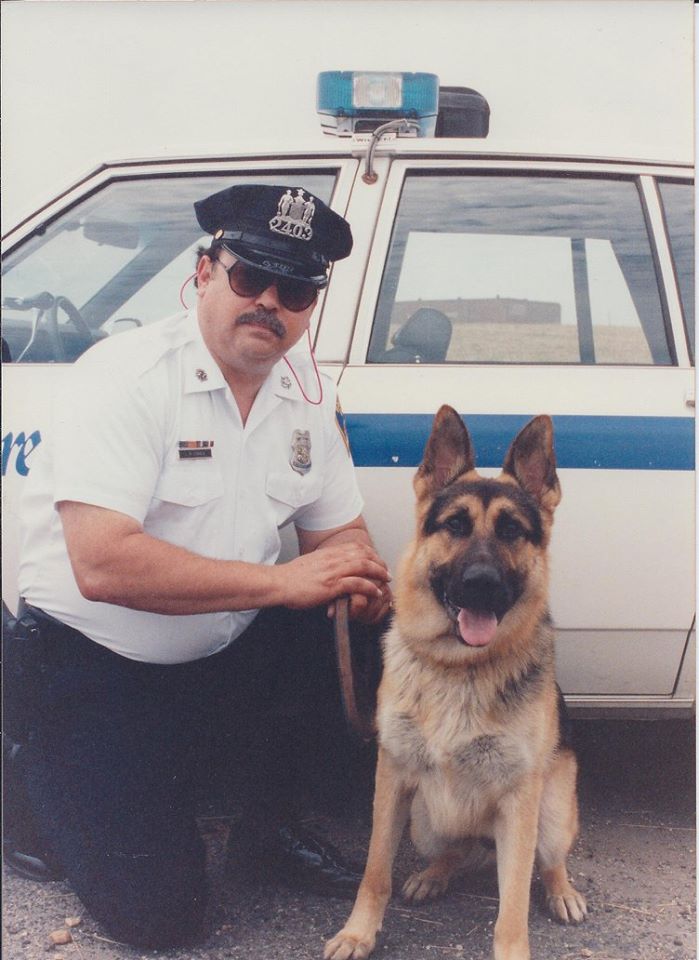
A department should establish qualifications for handlers before they are selected. In small departments or those with limited manpower, strict requirements will yield few volunteers; thus, qualifications will differ from department to department. There are certain basic qualifications, however, that every department should establish. A handler should be a physically-fit young man, who plans to remain in the department for the work-life expectancy of the dog, for a dog should not be switched from one handler to another. The man must volunteer, he must have the permission of his wife and family, and he must own his own home or have a rental agreement in writing that permits him to kennel his dog at his home. He should have at least one year of police experience, a good record, and an affection for dogs. If the department cannot provide it, he must have means for transporting his dog too and from work. It is also advisable that he has no other dog at his home. These are the basic requirements. Many departments require, in addition, that he have the approval of his neighbors, that he have at least ten more years to work before retirement, that he sign an agreement to remain in the department for a certain period, and that he qualify under various other age and service-length conditions.
The next major cost factor is the initial training of the corps. For the first few handler-dog teams, the department should select a police agency with an established training school and make arrangements with it for the training of these teams. Once the handlers have completed the training program, they should be able to establish a training school within their own department. This is the recommended procedure if the city plans a large corps, with more than five or ten dogs. If, however, the city is small and its need for dogs limited, it may wish never to have more than three or four man-dog teams; such a city will find it financially advantageous to send all its teams to an established school. The charge for training at an established school is usually $600 for each man-dog team, including the cost of the police dog.
If a large department plans a continued expansion of its corps, a permanent training facility is indicated. The cost of a school building and training grounds can range from $4,000 to $50,000, depending on the complexity of the structures and the number of kennels included. These kennels each consist of a fenced-off area, a doghouse, and a tying post. Their location at the training school serves a double purpose: First, it limits the number of persons the dog encounters during training, ensuring its concentration on the handler; second, it provides housing for dogs acquired prior to training, as well as for dogs belonging to other departments that are waiting to begin training. Therefore, enough kennels should be constructed to accommodate the number of teams that can be trained at one time, as well as a few extra for dogs waiting to be trained.
If a department intends to establish its own school, the first team it sends to another city for training generally does not participate later in the operational activities of its own canine corps. Instead, the handler-usually gave the rank of sergeant-becomes the trainer for the new school and uses his dog for demonstration. This man's salary, the 'team's training expenses, and the cost of the dog's maintenance must, of course, be considered part of the corps' expenses.
Once activated, the corps must obtain additional dogs for training. Although only one-tenth of the dogs presently in use were purchased, few suitable dogs are now being donated. As a consequence, departments will probably have to buy more dogs in the future, at a cost of from $125 to $175 each. The most suitable dogs are male German Shepherds, 6 to 24 months old, weighing 75 pounds or more. A dog should be inspected before purchase by both the trainer and the corps' veterinarian. Immediately after purchase, it should be housed at the training school. The work-life expectancy of these dogs is from seven to ten years. A department generally employs a caretaker for its training school, to look after the dogs kenneled there as well as the buildings themselves.
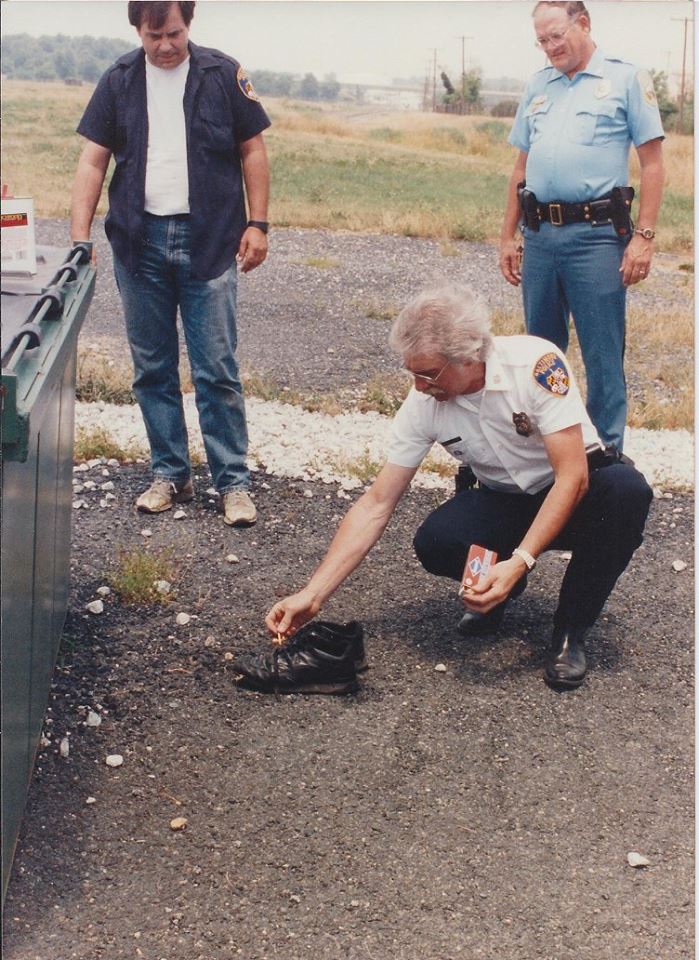
The equipment a department must provide for its canine program during the training stage is of two varieties: the permanent equipment of the training school and the articles supplied to each team. The first category includes attack suits; arm padding; obstacles such as hurdles, steps, ladders, and window jumps; different types of buildings for search training; cleaning equipment; and some medical equipment, especially if the corps' veterinarian is housed at the school. An optional item in this category is the "electrified collar," used, for example, in the St. Louis training program to administer a mild shock if a dog has trouble learning to break off the attack.
Included in the category of equipment supplied each team is two chain-choke collars; a 22-inch leather collar; a tracking line and harness; two five-foot leather leads; one one-foot leather lead; one kennel collar; two feeding pans; one comb; one brush; and a kennel for use at the handler's home. The kennel costs approximately $60 and the rest of the equipment about $25. The handler himself should supply his own work clothes, foul weather jacket and cap, three-quarter-length boots, gloves, and raincoat. The estimated average cost of training- one handler-dog team is about $1,200, the approximate cost of training a rookie policeman. All indications are that those departments following the London Plan of training are enjoying great success. (See the section, "The London Plan.") The training program advocated by the Army and Air Force, although appropriate to their needs, would require considerable alteration and integration with the London Plan to fit it to the needs of a city police. department, since the aims of military and municipal canine programs, are different. Our findings indicate that conformance to the London Plan alone yields as good if not better results than the adoption of any military plan of training.
One deviation from the London Plan may be necessary, depending on the city's characteristics, and that is training in hard-surface tracking. As noted above, the London Plan does not emphasize this training, since London has a few large areas of hard surface-that is, surface devoid of crushed grass and insects. Hard-surface tracking is taught much the same as other tracking, except that the training takes longer, is more difficult, and requires a greater development of the dog's sense of smell. Classes in this training phase should consist of not more than six teams, to permit more concentrated instruction.

The next cost factor involves field operations. Food, veterinary services, kennels, and working equipment cost an estimated $200 yearly per dog. Added to this is the cost of equipping police cars four-door sedans, one for every two teams-with aluminum or wooden compartments in the place of back seats, and with wire mesh to separate the dogs from each other and from their handlers. Wire mesh is also placed over the windows to provide ventilation without allowing people near the dogs when the auto is parked. The vehicles should be painted white, as this reduces summer temperatures inside by 10 or 15 degrees.
Also included in the corps' operational costs should be the salaries of a commanding lieutenant, sergeants who supervise field operations, and additional record-keeping personnel, as well as the cost of office equipment, space for administrative activities, and insurance to cover accidental injury to innocent persons. Other operational costs are overtime pay to handlers for extra duties, and $20 per year figured as depreciation on the dog. Still another expense covers time lost in supplementary training, usually averaging eight hours per week. In all, the expense of maintaining a dog on duty is estimated at one-half that of maintaining its handler.
Operations. After weighing the financial costs, a department should consider what it will gain from using police dogs. This consideration is closely linked to the particular crime problems and needs of the city, which should determine how the dogs are used. Canine corps are used most effectively for searching, tracking, crowd control, and crime deterrence. In cities where muggings, purse snatchings, burglaries, and breaking-and-entering are frequent, canine corps are more valuable than in cities where white-collar crime prevails. Cities with large slum and deteriorating areas have more need for dogs than suburban communities, although suburban areas bordering on the central city have used dogs successfully in curbing the city's overflow of crime.
Dogs should be assigned to areas with rising crime rates, to industrial areas containing warehouses and stockyards, to riverfront areas, and to tenement and slum areas. A canine corps is also effective in parks and in the parking lots of public areas, operas, theatres, and sporting parks. The dogs are most valuable at the time of day the city experiences its greatest crime activity, usually in the late evening and early morning hours. Teams should be rotated between day and night duty for experience in both.
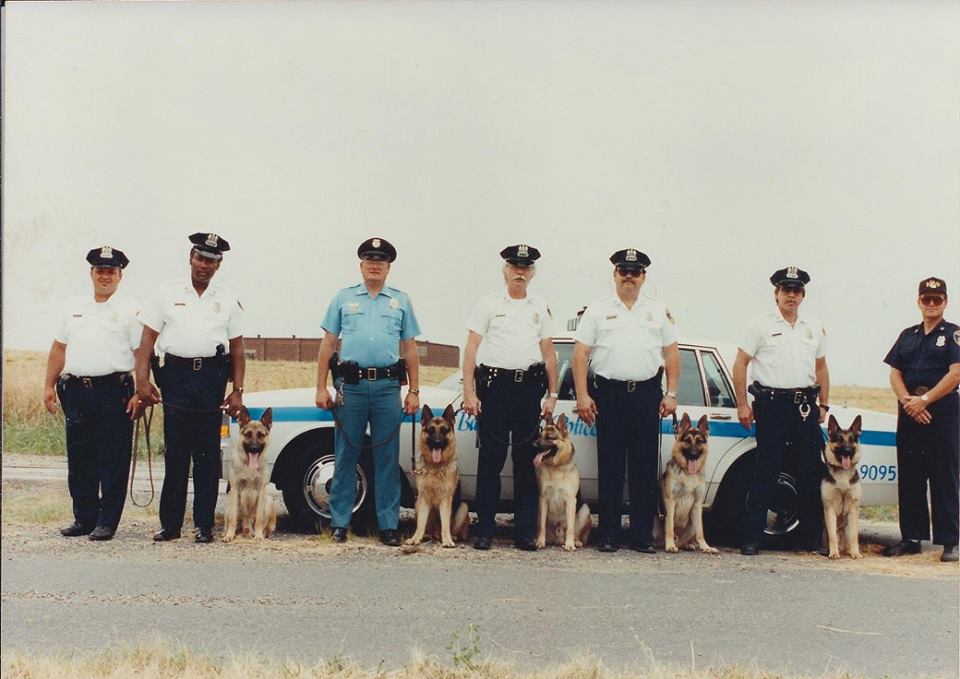
The system of assigning teams to ride two in a car, one leaving the car to patrol a designated area on foot, and the other remaining on call in the car, is considered most successful. The two duties should be alternated between the teams, allowing each equal experience in foot patrolling. A handler should keep his dog on a leash at all times, releasing it only to search presumably empty buildings, or to chase or attack. A special line allowing the dog more freedom of movement is used for tracking. A muzzle is unnecessary if a dog is properly trained. Only in the line of duty should dogs be taken into public buildings or onto public transportation vehicles.
One regular work-day a week should be set aside for supplementary training under the supervision of one of the regular trainers. The handler should indicate the areas in which his dog most needs training. At this time the dogs are given practice in those duties rarely performed in day-to-day activities.
Wherever used, a police dog affords its handler greater protection and relieves him of the dangerous duties of searching wooded areas, buildings, alleys, and dark, out-of-the-way places. In controlling crowds, it has been estimated that one dog can do the work of seven officers, either dispersing the people or holding them for arrest. Dogs can be helpful in arresting known "escape artists," in finding lost persons, and in searching disaster areas for victims. They are most celebrated, of course, for their deterrent effect on crime; however, a canine corps must be widely dispersed and have strength enough to deter crime generally, not merely to drive it from one area to another.
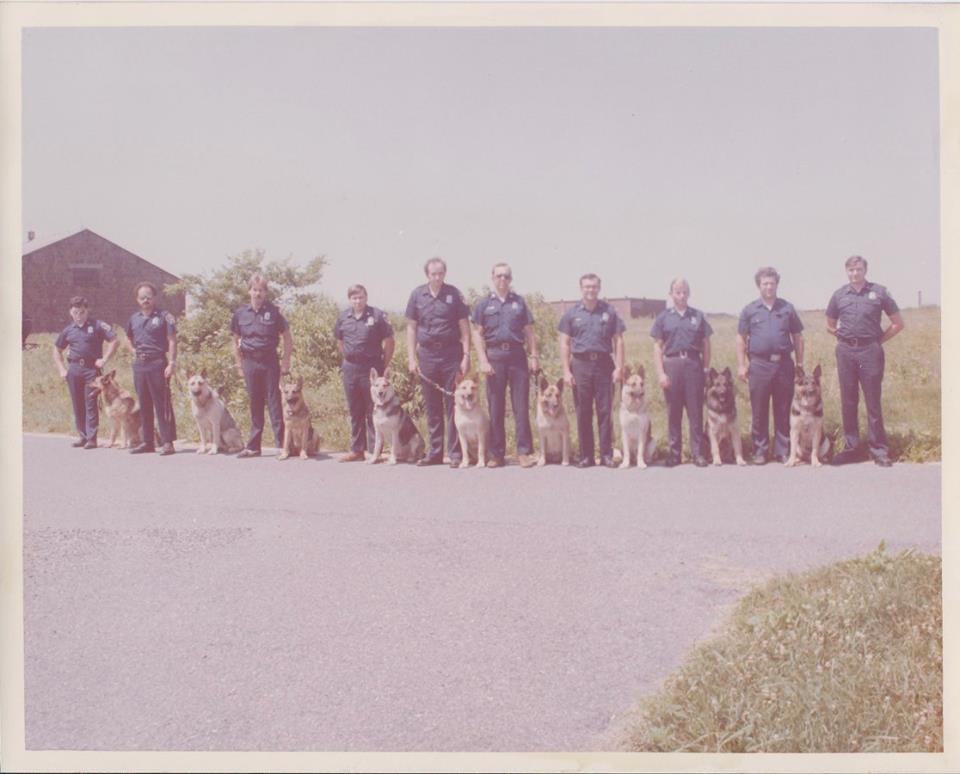
Some problems arise in using police dogs if their training is not thorough and complete. Thus, if a dog is trained to attack when its handler is threatened, the handler should be able to command it to break off the attack in the event, for example, the handler is scuffling with a drunk. Similarly, if a dog is taught to attack a person brandishing a weapon, the handler should have such complete control over the dog that he can prevent it from attacking if the team is working with other police officers. Attacking a person threatening its handler or brandishing a weapon is the only type of activity a dog is trained to perform on its own initiative; in all other situations, it should act only on the command of its handler. Dogs are not particularly useful in such functions as traffic patrols or investigation details. Each individual department must decide the phases of police work its dogs will aid most effectively and assign them to the appropriate divisions. It must be remembered that each dog requires at least eight hours -a week of its handler's time which would ordinarily be spent in the performance of regular police duties. A department must balance this sacrifice of time against the advantages of using dogs.
![]()
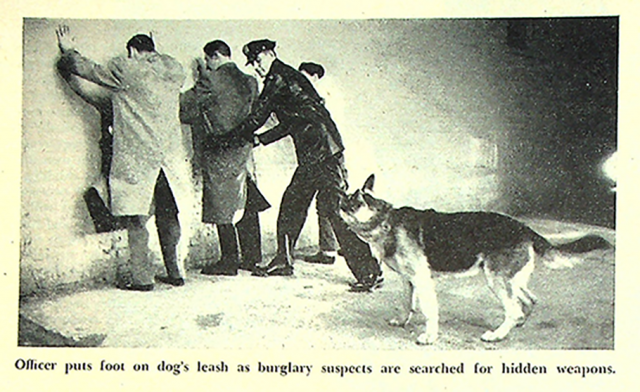 PUTTING TEETH IN THE LAW
PUTTING TEETH IN THE LAW
By Sid Latham
Baltimore police have gone to the dogs in a big way and all because patrolmen have learned that one low growl is worth a dozen warning shots
A Baltimore policeman and his dog were walking their beat in one of the more rugged sections of the city when they heard the sounds of combat a couple of blocks away. Double-liming it up the street, the officer saw five men had another man down on the sidewalk and were beating the hell out of him. Seeing the law bearing down, the five took to their heels. "Go get'em, Major!" the cop bawled. Unleashed, the big dog took off up a dark alley after three of the assailants. The two others outdistanced the cop, but when the officer began a search of a parking lot, he heard Major's throaty growl coming from the darkness. Sure enough, Major had cornered the three who were hiding in a big truck. The trio meekly crawled out of the truck. “We might have outrun you," they complained, "but when we saw that dammed dog, we knew we was up the creek." Such incidents are by no means rare in Baltimore, where the police department has been using dogs to help catch crooks for the past year and a half.
Every evening. Twenty-one policemen and their dogs report for duty in the ready-room of the city's Northern District Station house, headquarters for the department's canine corps. Baltimore, the sixth largest city in the country, claims that it has the only dog patrol used by any major police force in the United States. The animals are not regarded as a noble experiment but as a valued and important adjunct to proper law enforcement. The dog patrols began in December of 1956 under the supervision of Police Commissioner James M. Hepbron, who gives the fur-covered members of his force a large share of the credit in cutting the city crime rate by 21 percent during the first six months the dogs were on duty. Most of the dogs come from civic-minded people who have donated their animals to the force. The training program is under the direction of Major Wilson Davis, a wiry ex-Marine Corps officer who had a lot of experience with duty animals by training dogs for war during the Pacific Campaign.
All of the patrolmen in the canine division are volunteers. Many of the men have never owned dogs before, and each officer undergoes an intensive, four-month training period with the dogs before going on patrol. Officers with dogs are assigned to sixteen of the toughest posts in the city. Major Davis prowls the city in a station wagon with a big German shepherd named Prince sitting by his side. A prime example of where the dogs prove their worth is Jackson Park, a three-block area that once required the constant attention of seven policemen and where the rapes and muggings continued regardless. Within one week of putting a solitary officer and his dog on the post, crime in the park dropped almost completely. Dogs are also the answer to the city's unique problem of a rabbit warren of alleys and byways in the old sections of Baltimore.
A fleeing criminal can quickly lose himself by running into one of the dark, twisting lanes. But when a cop shouts up the alley, "Come out, or I'll turn the dog loose," the well-hidden crooks come crawling out of their holes with great haste. "Most criminals," Major Davis says, "stand ·very still when cornered by a snarling, Bare fanged dog. Our dogs are not trained to kill or injure. Their job is to catch up with a suspect and hold him until an officer arrives to take charge. Dogs have not injured anybody, but I will not guarantee what might happen if someone were fool enough to try to fight off a dog. If one of these dogs are attacked, he'll attack in turn."
The dogs really shine when it comes to searching great warehouses and stores for prowlers. It took just 20-minutes for six dogs to completely search the large May Company department store on a prowler call. Where cops are forced to proceed with a certain amount of caution, dogs can rush around without any fear of being jumped or "disarmed." Street fights arc very quickly broken up by dogs, where policemen trying the same thing are apt to get embroiled in the fighting themselves.
Besides his fangs, the dog has one other weapon no crook can escape: the animal's keen nose. Recently a policeman and his dog were sent to check a prowler call in a large factory. The officer found, a man’s jacket lying on the floor and gave it to the dog to sniff. The canine cop trotted around with his nose to the floor and then took off upstairs. There, hiding on top of a large vat, was the prowler, who surrendered quickly enough when he heard the growls of the animal below him.
The Baltimore cops are so fond of their dogs that one of them said: "I wouldn't be without my partner for anything. I go places I'd never go before. If they took my dog away, I'd quit the force tomorrow."When the night's tour of duty is over, the dogs each go home with their master. Not only do the officers and the animals get to know each other better this way, but the need for an expensive police kennel is eliminated.
The idea of using dogs in police work is not original with Baltimore. Police departments in Holland and in Egypt use dogs in narcotic control and have for many years. Dogs to help catch crooks is old scuff to many European law enforcement agencies, but Baltimore is the first American city to recognize the worth of four-footed flatfeet. - Sid Latham
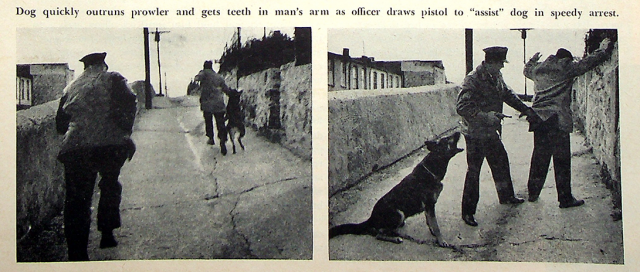
![]()
Patrolman Leo Smith

My uncle Leo Smith came onto the department in 1960 and was a member of the K9 unit from approximately 1962 until 1969/70. He had two dogs "Rusty" and "Prince" Ret Officer Smith carries a picture of them in his wallet to this day. Rusty retired, and went to live with him and his family, Prince was a bit aggressive and ended up going to the military, and doing a couple tours in Vietnam. He said working K9 was a great unit, and when you get a good dog, he becomes a part of your family.

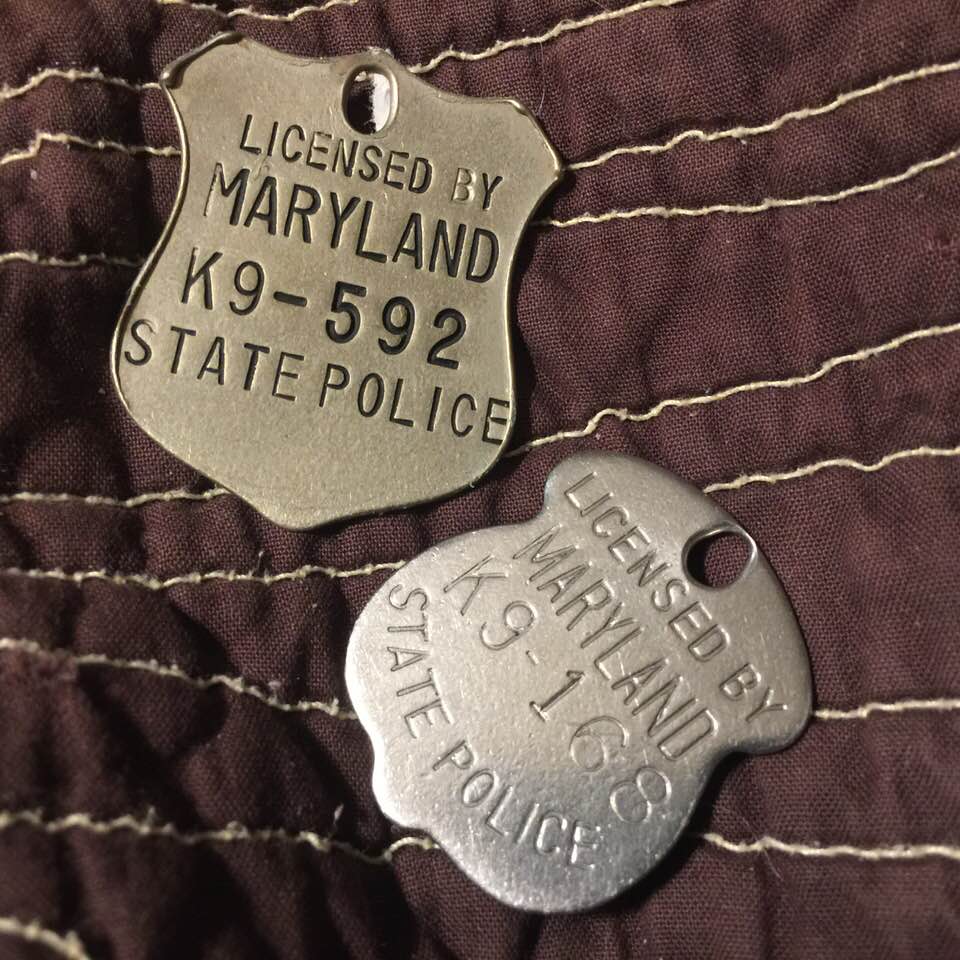
Baltimore Police K9 Licenses
This is two K9 Licenses once worn by k9 Dogs being trained and handled by Officer Al Wilder, The dogs Lupo wore K9-592 from 1981 to 1986 the second Jock K9-168 worn from 1986 to 1996.
![]()
America's best K9 unit and system started in 1956, became official in 1957 But some trial runs date back as far back as, "1914" when we started a unit using "contract employees", "sub-contracted Dogs" call them what you want, but we had K9 Dogs as far back as 1914 from what I can see, and based on the following:
FINE SCOUTS, THEY SAY--THESE POLICE DOGS
1 Nov 1914
Baltimore will test them in lonely suburbs, tales of criminals they have caught in New York.
Trained to attack a burger, a murderer or any person against whom a policeman wants protection, two Airedale Terriers are on their way here from the kennels of Major E. H. Richardson, and Grove and, Haro, near London, to do services within the Baltimore Police Department. Through the success obtained by the Airedale police dogs in other cities, the police board at a recent meeting decided to create a dog squad, the four-footed members of the force being assigned to assist the policeman in the northern and another in the Northwestern District. In regular police service, the police dogs are said to be invaluable tool patrolman’s post is extensive. Their duties as police stalls include aid in capturing criminals, as well as protective work. As a constant companion of the patrolman, the Airedale Terriers are considered good detectives. At a word, they will rush like a flash around the house and with their sharp eyes and keen sent track down a burglar or marauder in a jiffy. When regular police service adults can be put on guard at the door of a house and no one will be permitted to pass in or out. If one is rational to try it, the dog will knock them down and throw his heavy body upon the man’s breast and hold him until the police master comes to take charge of the prisoner.
Court New York Gunmen
The New York Police Department has a squad of 16 police dogs. The animals have made a surprising record they're being credited with the capture of many thieves and some notorious criminals. To show the efficiency of these dogs in service there it is recalled that dog trials and competitions recently held in Van Cortlandt Park to police dogs assisted in capturing of four gunmen who attempted to hold up a citizen.
A policeman was within 100 yards of the scene of a daring hold-up. Blowing his whistle, the officer came to the rescue of the gunman’s victim. Two police dogs that had been on exhibit at the exhibition leaped behind the policeman and in less time than it takes to tell if the animals had thrown the three gunmen to the street, while the other dog, leaping on a taxicab in which the robbers came upon the scene, pulled the fourth thief – “The Chauffeur” – from his seat. Without the police dogs, it is believed the policeman would have been able to capture only one of the four highwaymen, the others escaping while the copper was grappling with his prisoner. (Sure interrogation would have gotten the names of the other 3, but by the time they were apprehended, who knows what crime they may have committed!)
Among the several breeds of dogs that have been trained as police dogs are the Doberman Pinscher, the Rottweiler, and the Airedale Terriers. Some of these types of dogs are not reliable because they are full of the fighting spirit, which diverts them from serious work.
Their Great Protectors
Police dogs are, “one master” dogs and, “one purpose” dogs. They inherit the trait to be vigilant, to protect life, and property. Before it was discovered that these breeds were invaluable for police and protective work they were valued for their vigilance in minding sheep, cattle and other pasture animals.
The Airedale Terriers don’t need patting, just a part of thanks when they perform a service. They are not pets, but service, says Maj. Richardson, who has furnace police dogs to authorities in all countries, as well as to the royal family of Britain the German Kaiser, and Czar of Russia. And for us Marie of Russia, the Queen of Spain, the Quinn of Wartburg, the queen of Sweden, the French Prime Minister, and many others, as well as to police departments in this and other countries.
“The dogs,” he says, “must be handled intelligently and disciplined if they are to do good work, and not have everyone petting them or giving them orders.”
It is expected that the police dogs will arrive in Baltimore within a month. The two policemen it will be given the custody of the dogs will care for them at their homes, being amply repaid by the police board for the costs incidental to their maintenance.
How They Will Work Here
at 7 o’clock at night each of the patrolmen will leave his home accompanied by the police dog and the animal will journey with him around the beat. From then until 4 o’clock in the morning they will patrol the streets, the dog’s mouthing and scale ahead of the patrolman, making detours around houses, and small streets and alleys bent on coming across any possible marauders.
Should the police dog discover a suspicious individual it hurries back to the patrolman and the officer investigates. If the four-footed member of the force has found a man who looks suspicious, the patrolman gets busy. If the stranger puts up a struggle, the policeman has a valuable helpmate in the patrol dog.
Maybe it would be well for the man inclined to carry home in the “wee small hours” a “bundle of cheer” to use a taxicab, should he live on the post of the patrolman who has a helpmate a police dog. It might cause him some embarrassment to have a police dog suspect him, for the dog can always discriminate between a worthy citizen in a pickled state and a second story man on a professional burger and.
It would scarcely be pleasant for the innocent but uncertain citizen going along on one leg to begin front with a big police dog. The “R-r-r-o-w-w-o-f!” My get on his nerves.
Subordinate Protector
However, it will give much satisfaction to residents of the outlying sections to know that while they are in the arms of "Morpheus"a patrolman’s aid, the police dog, is stepping so quietly, running around their homes, that a burglar can’t hear the snout are. It is the police dogs duty to find for the patrolman those who have no business in a neighborhood so they can be questioned and locked up if suspected of being one and ill bent mission. They can find such persons a lot surer then can the patrolman, who cannot be on the job as quickly as the dog, because his footsteps might be heard.
Should these four-footed members of the police force get in “Dutch” with their superiors: should they fail to perform their duty as a real good policeman said, what punishment is to be matted out to them by the commissioners? This is the question Marshall Carter and Deputy Marshal House ask yesterday: “the dog policemen being official members of the force, but not human citizens responsible for their acts, what will we do if it is necessary to preferred charges against them?”
At any rate, the police board feels that the police dogs will be a real and invaluable service to the department. If they are found to be of value to the force, as they have been to other cities, it is likely that the squad will be augmented. It is pointed out that in the suburban sections of the city great need is felt for more policeman. The dogs, which cost $51 each, will, it is hoped, help fill the much-needed gap in the service until the next legislature meets when the Gen. assembly possibly will increase the force by not less than 100 patrolman
1914 -1916 - "Luxe" and "Morpheus" Baltimore’s first actual police dogs - This is a little-known fact, but while not an official unit, Baltimore had two police dogs at their call when two Airedale Terriers from London came to enroll as members of our police force. Their owners learned two dogs were already here, privately owned, one belonging to a Mr. Jere Wheelright, and the other to a Dr. Henry Barton Jacobs.
“Luxe,” Mr. Wheelright's dog was a superb example of a highly trained equine aristocrat, big, powerful and intelligent to a degree that he was truly remarkable.
It would be 42 years before we would have an official K9 Unit, but off-and-on, since 1914, we had Police Dogs used in both a private and official capacity.
1948 - Socolow McGee - 18 Dec 1948 McGee as this dog was known, was killed in the line of duty while patrolling the Central District, he was struck by a car, that car rushed him to an emergency Veterinarian Hospital where he was pronounced dead. This based on the following Sun Paper Article dated 19 Dec 1948
1956 - We establish an official unit, 17 April, 1957 it was officially a unit, all trials had been complete, and concidered a success, so with an official methodology that would go on to become known worldwide as the best K9 unit in the country, a system that would be the model for other K9 units around the country, and around the world. The system became known as the Baltimore method, as we were the first to have the handler take their dog home at the end of the shift to become part of the handler's family. Prior to this, dogs either went into a kennel at night, or took off with a handler from the next shift.
![]()
Courtesy Ret LT Bob Wilson
18 Sep 1914
TO TRY POLICE DOGS
Department Here Will Use Belgian Hounds In Suburbs.
THEIR JOB TO CHASE CROOKS
Success In Other Cities Prompts Experiment Here For Detection and Protection,
Four Belgian hounds, trained to attack a burglar or murderer or to assist anyone who needs protection, will soon be doing police duty for the Baltimore Police Department in the suburban districts. At a meeting of the Police Board Wednesday it was decided to give the police dog a tryout in Baltimore and Marshal Carter and Deputy Marshal House were instructed to create a dog squad as an aid to policemen who work extensive posts. As soon as the dogs are bought they will be placed in the custody of four-night policemen, who will care for them, being amply repaid for the care by the department. While the board's action is one of an experiment it is believed that the dog squad will meet with favor and be an important adjunct of the police force. The policemen who will have the dogs as aids will take them from their homes directly to their posts. Journeying with the policemen the dogs will work until 5 o'clock in the morning. The dogs will be taught to make detours around houses to detect possible marauders.
The record of police dogs in New York, Brooklyn and cities of the West is said to be a surprising one, many notable captures having been made by the animals. According to Marshal Carter and Deputy Marshal House, the Belgian hounds can be trained in criminal detection as well as in protective work. As a constant colleague of the patrolman and as a detective he is considered by police as invaluable. "When the dogs are in regular police service," declared Deputy Marshal House, “They can be put on guard at the door of a house and no one will be permitted to pass in or out. If one is rash enough to try it, the dog will knock him down and sit on him. He does this by getting between the legs of the would-be fugitive and causing him to lose his balance and fall." Marshal Carter said last night that he would arrange immediately to get at least four dogs in the department within the next two weeks. It is expected that a Belgian bound will cost about $100. Marshal Carter was in Milwaukee several years ago and in looking over the police situation he learned of the work that the Belgian police dogs do there. This is only one of the many new ideas that the Police Board has to better the police system. It is probable that within the next six months the department will Increase the dog squad.
![]()
Dog Shoots Officer
10 Feb 1974
Dog Triggers Officer’s injury
A Southern District Police Officer, Austin L. Harres, was accidentally shot in the right foot with a householder’s high powered pistol last night while checking a report on a suspected break-in in Cherry Hill. According to police, a dog caused the blast from a .357 magnum pistol that pierced Officer Harres's foot; near the toes. He was in satisfactory condition in Mercy Hospital last night. The officer and Russell Brown, of the 600 block Cherrycrest road, were combing the vicinity at about 9.30 P.M. Mr. Brown, the complainant, was carrying the pistol when his dog jumped on him, triggering the gun, police said.
![]()
K9 Dogs Lost in the Line of Duty
1948 - 18 December 1948 - We lost fellow officer K9 Dog Socolow McGee
1971 - June 1971 - We lost fellow officer K9 Dog Shane
1972 - 23 April 1972 - We lost fellow officerK9 Dog Duke
1982 - 12 July 1982 - We lost fellow officer K9 Dog Sultan
![]()
Dog Policeman Killed on Duty
19 Dec 1948
Dog Policeman Killed on Duty
Four – Footed volunteer struck by a car while on his beat Funeral services for Patrolman Socolow McGee, who has killed yesterday 18 December 1948 in the line of duty, will be held tomorrow morning at the Oakley Cemetery, in the 8400 block of Oakley Road. Patrolman McGee, a dog adopted by central district police two years ago, was struck and killed by an automobile at Baltimore and Front streets yesterday afternoon while he was patrolling his regular beat. According to Patrolman William Hogan and Halley Schreiber, Patrolman McGee was following them along Baltimore Street and he was struck by a car as he crossed Front Street. The motorist took the Patrolman to a veterinarian’s office in the 100 block of S. High St., where he was pronounced dead on arrival.
Usual Schedule on Beat
It was according to police, a bit unusual for Patrolman McGee to be on duty during the daytime, his normal shift being from 8 PM until 8 AM. Forever since he was adopted by the central district, he would report in at 8 PM trot around his beat – bounded by Baltimore Street, and Fallsway, Asquith and Hillen streets – check back in the station at midnight and go back out until 8 AM After learning of his death last night, businessmen along the beat made the arrangements for the funeral. The pallbearers have not yet been announced After this we lost three more dogs, Two in the 1970's and one in the 1980's what follows are the newspaper articles from the 1972 and 1982 Sun Paper reports
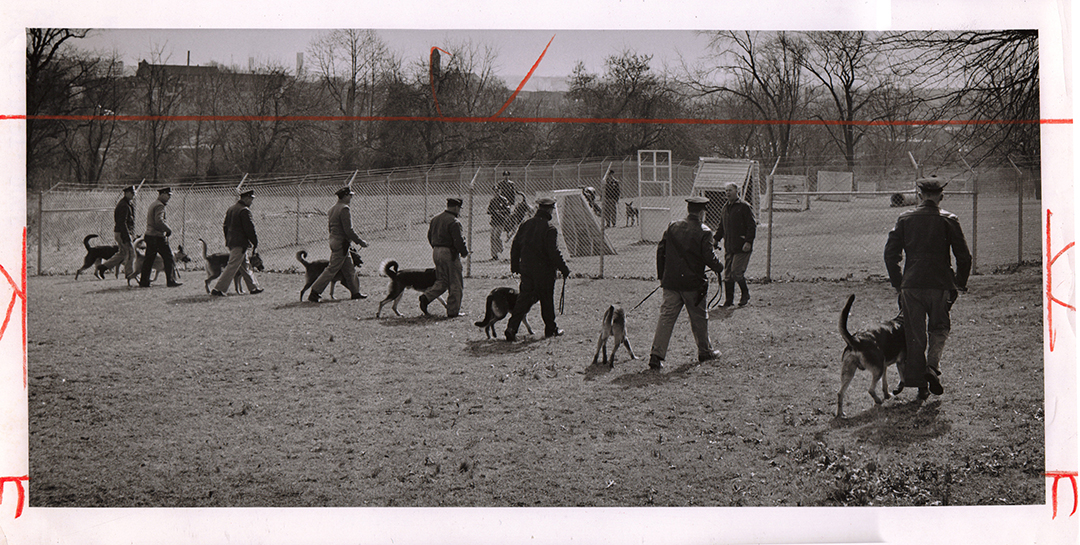 Courtesy Mark Frank
Courtesy Mark Frank
Great 1950's K9 unit new grounds
![]()
Memorial Plaque Present
August 1971
On August 16, at the monthly meeting of the K-9 law enforcement Association, Officer. David Stuller of the tactical section K-9 unit was presented with a plaque to commemorate the loss of his dog, Shane, who died in the line of duty in June 1971. The plaque was presented by Commissioner Donald D. Pomerleau and Association President Paul Mossberg of the Frederick City Police Department at the meeting which was held at the Stafford Hotel. The presentation was also attended by Deputy Commissioner Frank J. Battaglia, Lt. Col. Donald T. Shanahan, Capt. Francis X. Hayes and Lieut. Horace M. Lowman.
![]()
K-9 Dog Plunges to Death
24 Apr 1972
K-9 Dog Plunges to Death
A city police K-9 unit dog plunged to his death from the sixth-floor roof of a downtown department store while his master was investigating a store burglary yesterday morning. Patrolman Samuel Spalla said his dog Duke preceded him out the door to the roof and Jumped over the parapet of the Hochschild-Kohn store when the policeman called him to come back. John B. Starnes, 71, the store watchmen, had called police after he chased a burglar upstairs from the first-floor watch shop about 10:45 AM Mr. Starnes said the watch case had been forced open and several items scattered on the floor. He had no estimate of the value of the items taken. Police said the door leading from the employees’ lounge to the roof had been forced and that the burglar apparently escaped through the door and down the fire escape to an alley
![]()
Tear Gas Ends 23-Hour Standoff
13 July 1982
Tear gas ends 23-hour Standoff
A 34-year-old man who barricaded himself for 23 hours in a West Baltimore row house and apparently killed a police dog sent in after he surrendered to police last night after officers shot tear gas cartridges into the residence. The man came out at about 8:30 PM 15 minutes after police issued an ultimatum. Dennis S. Hill a departmental spokesman said the man carried a 32 caliber handgun, but pointed at the ground and was not threatening when the siege ended. He was handcuffed by police and taken to bond secure hospital for observation. The man had made no demands and police originally planned to wait until he came out by his own choice. Families evacuated from adjoining houses wanted to return to their homes, however, and police decided to end the standoff “because it had become a neighborhood problem,” Mr. Hill said, “We decided that it would be in the best interest of everyone if he came out,” the spokesman said. About 1:30 PM yesterday, two K-9 officers broke down the front door of the house in the first block north through the street and sent in two German shepherds. The door apparently had been nailed shut. One of the dogs, Sultan, ran into the first-floor kitchen and was shot in the neck with a 12 gauge shotgun. The animal was rushed to a veterinarian’s office where he had died. A shotgun was found in the house after the barricaded man came out. No charges have been filed last night, Mr. Hill said. The house, occupied by the man’s father, was broken into about 9:30 PM Sunday. The father, who apparently was the only person there, left soon afterward. The man’s father and a psychiatrist yesterday repeatedly tried to talk to the man, through both bullhorns and the telephone but received no response. Usable warns police officers told the man about 8:15 PM that they would fire tear gas into the house if he did not come out in 15 minutes. He did not, and the dart size cartridges called “ferrets” were fired through the windows. About seven minutes later, he emerged to the front door.
Except for the shooting, the scene around the barricaded house was calm most of yesterday. Children raced in front of the television cameras, 10-speed bicycles passed through the crowd being held back by police cordons, and a snowball stands a half block away did brisk business. About 100 neighborhood residents watched the house from the front steps of nearby houses.
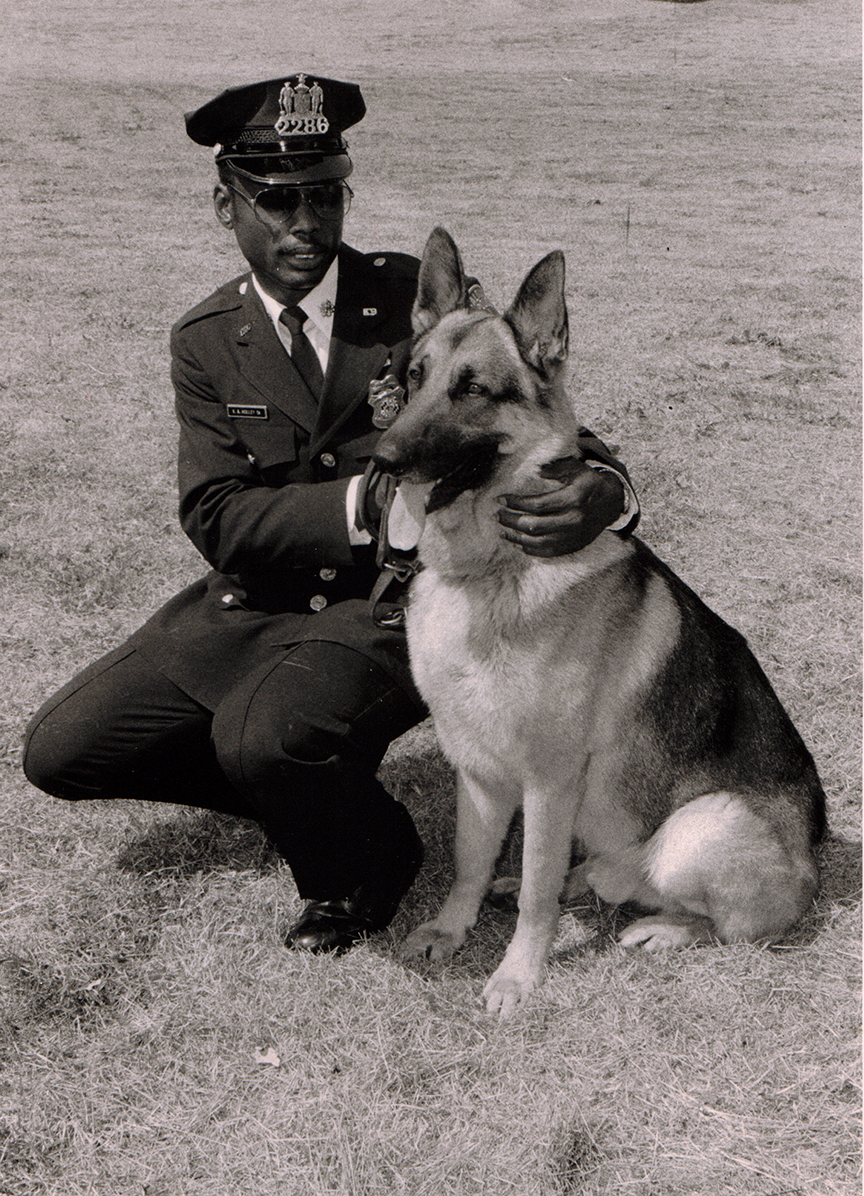
Courtesy Mark Frank
"Fritz"
Fritz Sets Out to be Policeman's Best Friend
16 July 1983
Fritz Sets Out to be Policeman's Best Friend
One year ago, city Police Officer Vernon and Holly buried his partner, a German Shepherd name Sultan, who was killed while working in West Baltimore yesterday, the officer formerly teamed up with a new partner, a two-year-old, 95 – pound dog named Fritz, during a graduation ceremony in Druid Hill Park. He was one of seven officers – two from North Carolina, one from Anne Arundel County and four from the city – who completed a 14-week session with their dogs at the city’s canine training grounds in Curtis Bay. The event also was used to unveil the departments first attempt at maintaining a permanent police presence in the park; a new headquarters for the 50 member K-9 unit. The $200,000 facility, located near the children’s zoo, was prized by some community leaders who attended the ceremony as a sign that the city is trying to make the park safer. The one-story brick building featured spacious air-conditioned candles for nine police dogs at a time. Of those will leave their dogs at the kennels when appearing in court or writing reports. Except for mandatory roll call appearances, officer Holly and Fritz will not spend much time together in the new building. The team officially begins its patrol Monday. Officer Holly said he was looking forward to working with Fritz, he said he wanted to be careful not to compare him to his previous partner Sultan “every day I remind myself not to compare dogs” officer Holly said, “it’s like an omen to ask this dog to fill the shoes of another it’s unfair. “You don’t want to compare, but you do want to make sure that he’s better. It’s like a father with one child; you want him to have everything you didn’t.” Sultan died from a gunshot blast last July after officers broke down the door of a West Baltimore row house where an armed, mentally disturbed man had barricaded himself in held police at bay for 23 hours. Sultan confronted the man inside the kitchen and was wounded in the neck. He died a short time later the veterinarian’s office. Officer Holly said that although his new partner is trained to sniff out drugs in explosives and search buildings, Fritz seems to have a certain aptitude for two other activities for which he was not trained. “He’s a freak for catching frisbees and tug-of-war games,” Ofc. Holly said, smiling while his six-year-old son, Vernon Junior, playfully demonstrated Fritz’s tenacious refusal to release a Long stick from his mouth. Despite some powerful seemingly tooth-jarring pulls from young Vernon, Fritz held on easily and even appeared disappointed when the youngster tired of playing. As in most police departments, Baltimore police dogs go home with the officers and assume a second role as a family pet, who, like their masters, work for the city. Let the police horses and other dogs the department has, Fritz was donated. His former master, Teresa likens, a Perry Hall, said her family was too busy to give the animal the attention it deserved. She said she decided to give him to the department when she heard the police could use good animals. As of yesterday’s ceremonies, police Commissioner Frank J Battaglia said building the K-9 “many police district” in Druid to a Hill Park will make the park safer and more attractive for families. Judy Morris, head of friends of Druid Park, who was attending the ceremony with her children, said the city’s decision to put a permanent K-9 police station in the park was the first step in a long-range plan to improve the image and condition of Druid Hill Park. “We’ve been working with the police department a long time to upgrade the park, “Mrs. Morris said, “I definitely think more families will come over here now, and it’s a nice way to introduce kids to the police.”
Courtesy JoAnn Oliphant Voelker
1964 K9 Unit with OfficerJames Pate
Sunpaper Pic
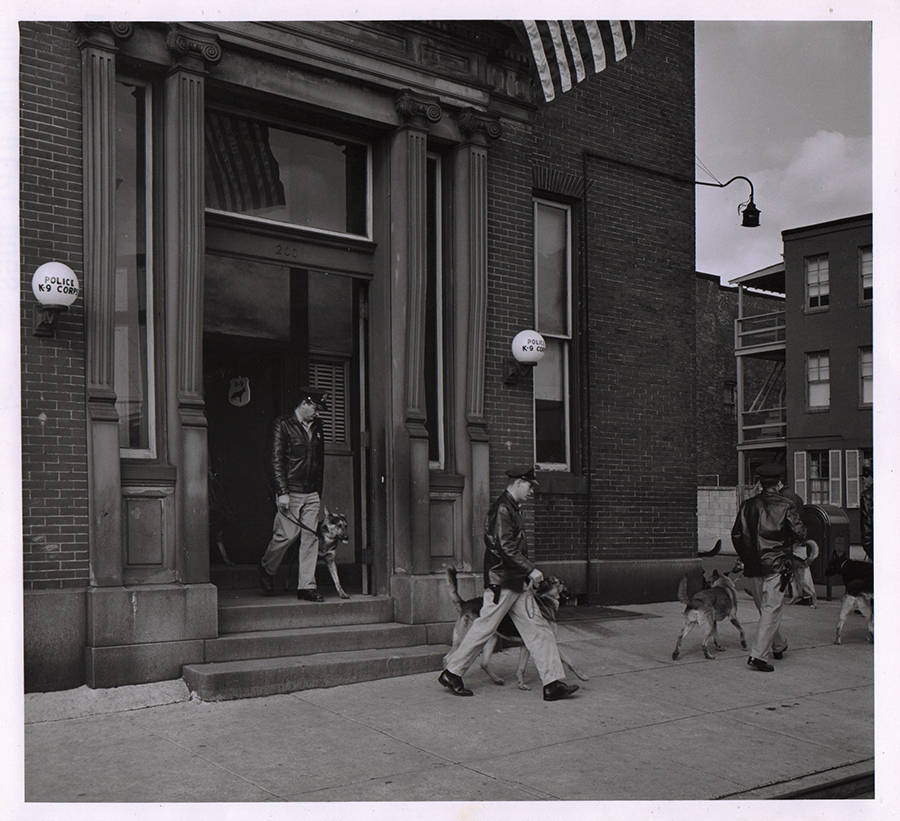
Sunpaper pic
![]()
Baltimore's Oldest Police K9 Dies
21 December 2006
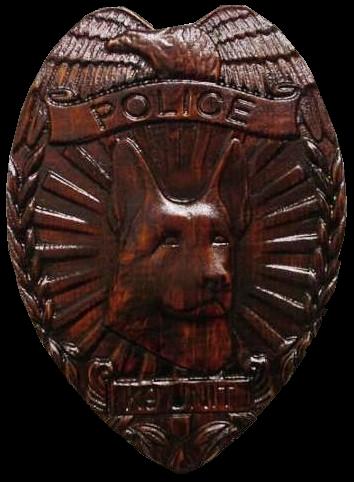
There is sad news from the Baltimore Police Department, as the oldest veteran of its renowned k-9 unit has died. “Reno” was 14, and served 11 years as Officer Jerry Turpin's partner, before failing hips, caused him to be put down. With tears in his eyes, Turpin, a 26-year veteran of the force, says "I've lost my best friend. Nobody will ever know what goes on between an officer and his dog." Reno and Jerry hit the streets in 1996 and were inseparable until Reno was injured in the line of duty. In 2005 Reno fell through a window while in pursuit of a suspect which lead to his retirement as a result of the injuries. Reno's sister “Imka” has become Jerry's new partner. There are 28 canines on the city police force which, celebrated its 50th anniversary March 2006
![]()
The Canine (K-9) Corps
Of the Baltimore Police Department
By: Inspector Leo T. Kelly November 1959
EDITOR'S NOTE
There are many who feel that the use of dogs on patrol merits serious consideration by Police Departments everywhere. In this revealing article, Inspector Kelly points the way with basic information concerning the formation, administration, and use of this new police unit. In addition, in a letter to the Editor, he states, "Since the innovation of the Canine (K-9) Corps in this Department, we have found that the use of trained dogs properly controlled by experienced police officers has undoubtedly been an excellent deterrent, particularly when they are assigned to those areas of the city where the records show crime to be most prevalent. We have also found that trained dogs are particularly effective for apprehending offenders fleeing from the scene of a crime; detecting burglars in operation; dispersing disorderly crowds; appearing at the scene where an officer may be having trouble with a prisoner; trailing and detecting wanted persons hidden in wooded and suburban areas, particularly at night, and for other uses.

Tuefel
![]()
Our 1st K9 Dog was a 2 yr old Black and Silver, German Sheppard, named "Turk" he was handled by Patrolman Thomas McGinn. Our number 2 dog was also a German Sheppard his name was "Major Von-Gruntz" they called him "Major" for short. Major was handled and trained by Patrolman Irvan Marders. Baltimore became the first K9 in the country to train the way we do. A system that would come to be known as the "Baltimore Method". After Turk and Major, we had several other dogs, Major II, Reds, Mark, Wolf, Duke 2, Major I, Sergeant, Kevin, Quickstep, Rusty, and Duke. Each of these dogs was donated to the squad by Marylanders anxious to see the experimental program a success. All were pedigreed and were registered with the American Kennel Club. At the conclusion of their training, they will be "command" dogs, capable of attacking command, releasing on command, watching and guarding prisoners on command, trailing and tracking suspects, or disarming and downing thieves and or assailants on command. Baltimore went on to become the first Federally Certified K-9 training center in the country, by 1982 they had already trained over 70 cities, and 20 countries in the proper use of the K-9
![]()
Dear Sir
In response to your letter appertaining to the use of police dogs in law enforcement agencies, I am forwarding information which I am hopeful will answer your inquiry satisfactorily. Since the innovation of the Canine (K-9) Corps in this department, we have found that the use of trained dogs properly controlled by experienced police officers have undoubtedly been an excellent deterrent, particularly when they are assigned to those areas of the city where crime appears to be most prevalent. We find it most difficult to furnish any measurable or accurate statistics at this time which would indicate what effect the use of our 40 trained police dogs (covering an area of 92 square miles and a population of approximately 1,000,000 inhabitants) has had on the crime situation here. However, we are definitely convinced that the psychological effect surrounding the appearance of an officer with a dog on patrol has been of invaluable assistance. The reaction of both the public and the press has been overly responsive in favoring the use of trained dogs for discouraging both the would be offenders from going astray of the law, and in apprehending those responsible for criminal acts.
The members of the K-9 Corps have for some time been demonstrating their training techniques and the procedure affecting the use of their dogs in the field, and the requests we are presently receiving from various civic and fraternal organizations, clubs, and other group associations desirous o£ viewing these exhibitions, are becoming so numerous that we find it impossible to comply with all of them. We have found that trained dogs are particularly effective for apprehending perpetrators of criminal acts fleeing from the scene of a crime; detecting burglars secreted in large industrial plants and warehouses, etc.; dispersing disorderly crowds; appearing at the scene where an officer may be having trouble with a prisoner; trailing and detecting wanted persons hidden in wooded and suburban areas, particularly at night. We plan to add additional police officers and dogs to this unit in due course of time. In addition, I have enclosed a prepared informative article which explains both the inception and operating procedures of the K9 Corps.
Sincerely yours,
Leo T. Kelly,
Inspector
![]()
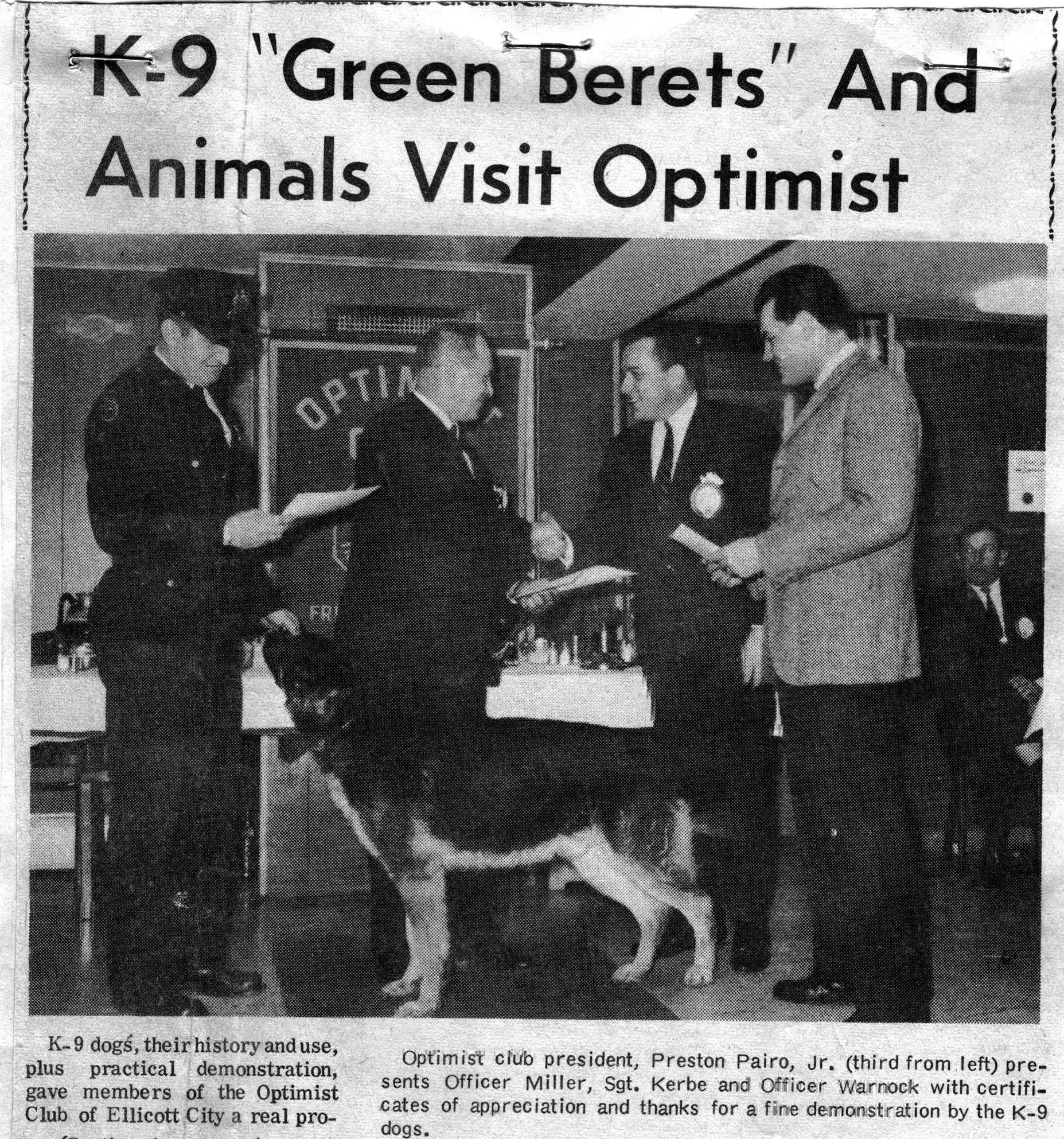

BALTIMORE
CANINE (K-9) CORPS
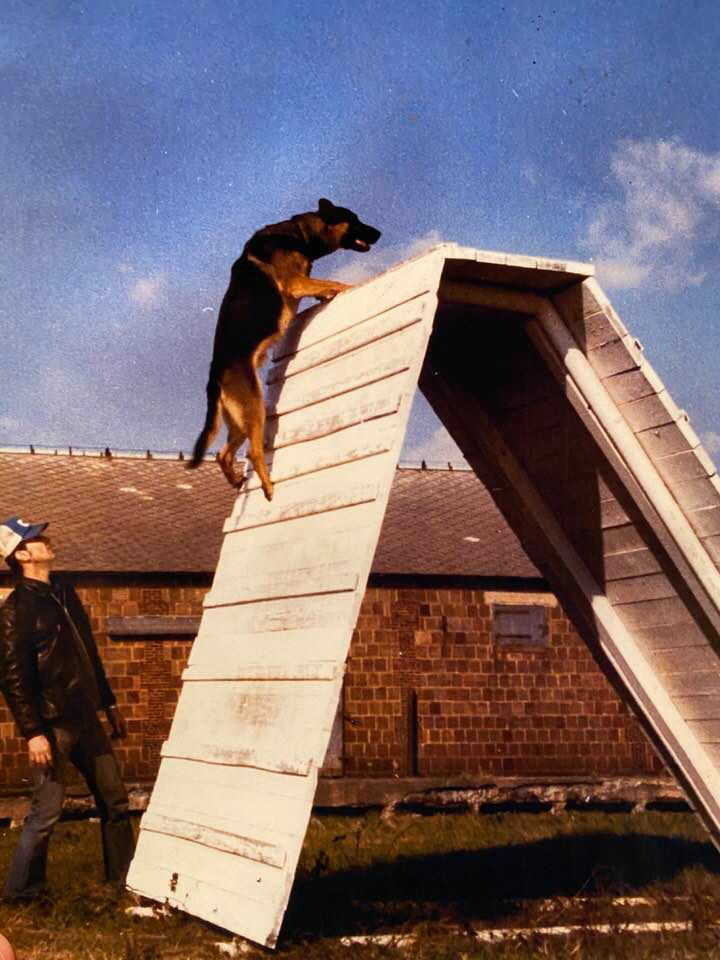
Jim Bowen in our K-9 unit with his dog Sparky, badge number 148
Location of the picture was BPD’s Ordnance Road Training Facility
They were working the Confidence Course.
Here Jim is teaching Sparky to jump and climb a 10-foot wall by himself and un-tethered.
This was sometime around the Fall of 1978.
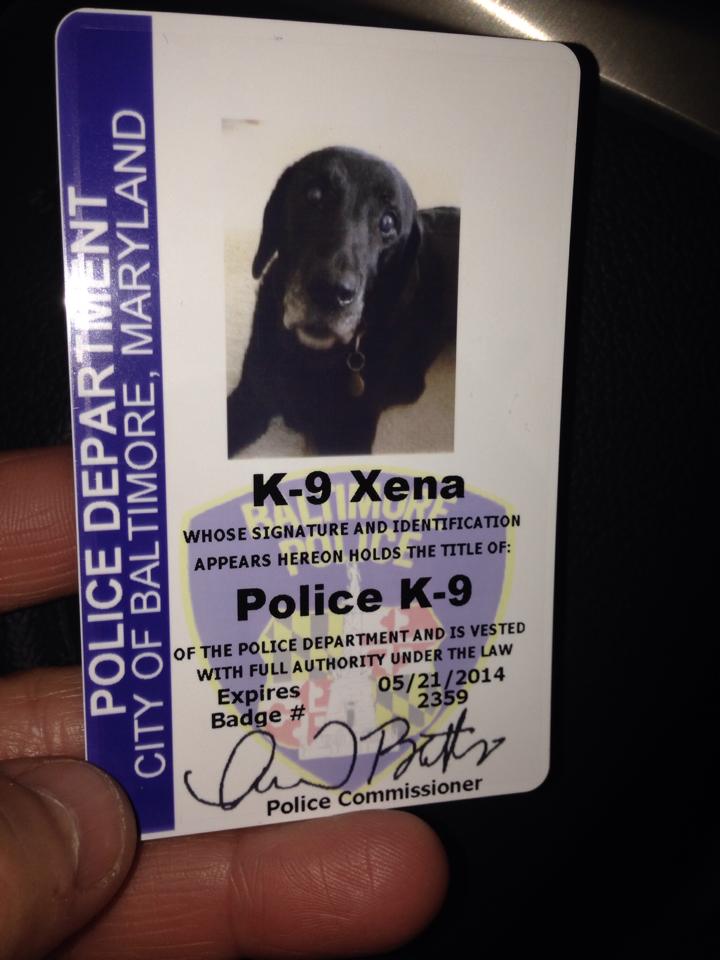
Courtesy Shirley Disney
K-9 Xena
![]()
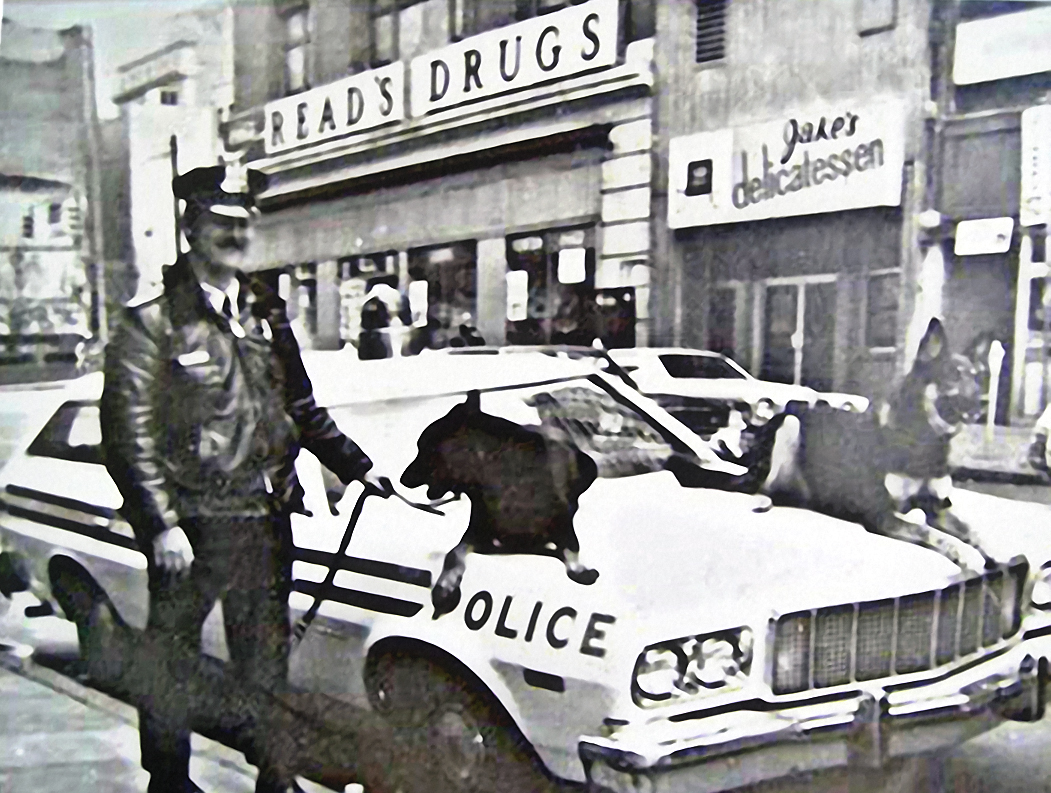 Courtesy Dan Karst
Courtesy Dan KarstMartin Karst BPD K9 Picture 1974
1956 - We plan to add additional police officers and dogs to this unit in due course of time." ON Tuesday, December 11, 1956, an article was published in one of our local newspapers which was one of a series of articles written by one Martin Millspaugh pertaining to Scotland Yard. This article, the last of a series, was devoted to the use of police dogs in London. As a result of the letters and inquiries received by Commissioner James M. Hepbron, an article appeared in the Morning Sun on December 17, 1956, which briefly stated that Commissioner Hepbron was interested and saw the possibilities of using dogs in the Baltimore City Police Department. On December 18, 1956, two dogs that had had previous training were offered to the Baltimore City Police Department and, with two officers also with previous dog experience, the program was put into effect on an experimental basis.
1957 - By the middle of January 1957, fourteen dogs had been acquired as potential candidates and fourteen men were selected and assigned to the K-9 Corps. These men were chosen as a result of a questionnaire which was sent to all members of the department asking for volunteers. These men and dogs were trained daily until March 1, 1957. At that time, they were put on the street on, Friday and Saturday nights, working the areas where a crime was most prevalent. Shortly after this, actually on April 17, 1957, Commissioner Hepbron, considering the experiment a success, went before the Mayor and City Council and appropriations were made through the Board of Estimates which resulted in the K-9 Corps becoming a permanent part of the Baltimore City Police Department.
ADMINISTRATION: The administration of the Canine (K-9) Corps is under the direction of an Inspector of Police. A Lieutenant has been placed in command of the unit, and he has a civilian trainer assigned to him whose sole responsibility is the training of the officers and the dogs. There are also 3 sergeants assigned to the K-9 Corps who assist in the training program. These sergeants also monitor the activity of the K-9 patrol force in the field under the direction of their commanding officer. These sergeants were selected on the basis of their qualifications, and previous knowledge' and experience in training and handling dogs. The balance of the organization at present consists of 30 officers (patrolmen), a clerk and 40 dogs.
![]()
Hepbron Ponders Dog Use.
Head of Force Interested in Possibilities Here
17 Dec 1956
James M Hepbron police Commissioner, showed definite interest yesterday in the possibility of using police dogs in Baltimore. The police commissioner said many persons had written to him, suggesting the use of canine aid for foot patrolman to help curb purse snatchings street attacks and other forms of crime now on the increase. Powers supplemented. The suggestion was in the line with the newspaper article reporting on the affected miss on police dogs used by Metropolitan police in London use of dogs here would help the Baltimore Police Department at a time of severe manpower shortage. The animals are trained to bring down possible criminals without serious harm, and their keen sense of smell and hearing supplement the beat policeman's powers of detection. Some 272 dogs currently are used by the London police. We are always interested in anything to improve policing the commissioner said, and the use of dogs looks like it has possibilities. He said the department is planning to investigate what type of neighborhoods, the dogs work best in and to gather details about the training, financing, and other matters involved. Speaking theoretically he said the current shortage of space at district police stations would be a problem. So the dogs are brought in on a trial basis.
Northern police station. He said is the only one which might have room for dog kennel facilities to accommodate even the experimental pair of dogs. The commissioner said the suggestions on using dogs were among the more practical of the many the department had received others have advocated the use of bicycles, motor scooters, and such vehicles
![]()
New Post Of Police Dogs Bureau Director Approved
2 May 1957
The Board of estimates yesterday gave its approval to a new job in the police department. The directorship of the police dog Bureau the position set up by the city service commission April 25 pace $8170 a year. The board. Two weeks ago granted the Police Department request to date canine dogs Corp., a permanent part of the police force James M heparin police commissioner said the 14 dog Corp., which up to that time had been experimental were very of effective both from a psychological angle and on a prevention of crime and in the actual apprehension of criminals.
METHOD OF SELECTING OFFICERS:
It must be kept in mind that an officer to work with a dog must want to do so he cannot be forced into the job as his reactions to his work reflects in the animal. All officers, therefore, must volunteer. From this list, they are carefully screened and selected. First, they must meet certain requirements:
(a) They must live in their own home. This home must have adequate ground or a yard to house and care for a dog.
(b) The officer's wife and family must be investigated from the standpoint of willingness and approval.
(c) They must have available an automobile to use at all times.
(d) Their personnel record with the department must be good.
(e) Sufficient practical police experience or knowledge before being assigned to a unit.
The cost of the K-9 Corps consists of the salary of the personnel assigned to the unit plus an estimated" figure of $200 per year per dog. (This latter figure is based on the cost of food, equipment, and veterinary charges.) All dogs have been donated outright to the department for use in police work. They must be German Shepherd dogs (male) sound of body, physically fit and of good even temperament-neither vicious nor shy, and preferably under 3 years of age. No kennel facilities are provided. Each dog is assigned to an officer and from that point on lives with him at his home. The fact that the dog is with the officer constantly not only provides a closer bond of relationship between man and dog, but it also eliminates the necessity of the erection of expensive kennels and the personnel to staff same. Food is purchased by the department and distributed to the individual officer as required. This food consists of a kennel biscuit and canned horse meat or beef. Each officer is taught to train his own dog. The dog is first trained, in basic obedience, and tested for gun shyness. Next, attack work and then trailing (location of lost persons or criminals). Finally, the dog is trained to locate articles or materials that could be used as evidence. (It is extremely important in the attack training that the dog attacks only on command of his handler and releases immediately when told.)
OPERATION:
Members of the K-9 Corps are assigned to the Headquarters Roster and they are available for use anywhere in the city. This unit operates on a three-shift basis. Shifts No.1 and No.3 work concurrently between the hours of 6 p.m. and 2 a.m. Shift No.2 works the hours of 8 a.m. to 4 p.m. This results in an officer working two weeks of night work followed by one week of daily work. There is also a small force operating on the streets in radio cars between the hours of 1 a.m. and 9 a.m. During the day shift, the training of the men and dogs is intensified and developed. All men on the day shift are on a standby basis for emergencies, but, by the rotation method, a small force operates in radio-equipped vehicles and occasionally on foot, on the street during the daylight hours. (It is important that both officers and dogs continue in their training to keep up their effectiveness and to increase their ability.) Officers of the Corps and their dogs are assigned to sections of the city where crime is most prevalent. They replace manpower due to the fact that additional officers need not be assigned to these areas. The actual area in which the dog is to operate is given to each District Commander via teletype on Monday of each week so that he can utilize the assignment of extra men to areas other than those covered by dogs. Primarily, a dog and officer work on foot and are assigned two posts instead of one. These dogs are always worked on the leash and only released when actually necessary to apprehend a criminal. However, 4 radio patrol cars are utilized-one being the Monitor Sergeant. The dogs ride in the cars with these officers and, being mobile, are very effective in taking calls anywhere in the city.
TYPES OF CALLS HANDLED BY THE K-9 CORPS:
Possibly the greatest value of police dogs lies in their mere presence on the street. The psychological effect has been tremendous and their deterrent effect on crime cannot be measured. Primarily they are assigned to areas where assaults, purse snatchings and yokings (muggings) are most prevalent. However, the dogs are very effective in dispersing and controlling crowds, in searching buildings, in assisting with arrests and the actual apprehension of criminals. They are also detailed (during visiting hours) in the vicinity of our hospitals as a preventive measure against purse snatchings and assaults, etc. Their function is not to replace the Post Officer, but to work in conjunction with him, keeping in mind that their effectiveness is greatest on the public streets and in the city parks.
PUBLIC EXHIBITIONS:
Upon requests, the members of the Corps demonstrate the use of their trained dogs at both private and public functions throughout the city, and the adjacent counties. These exhibitions are most interesting and the requests have become so numerous that we find it impossible to comply with all of them. We have established excellent public relations through these demonstrations.
SUMMARY:
As of this date, the Baltimore City Police Department is utilizing the services of 40 trained dogs. At the present time, we have 18 officers and dogs patrolling the streets of Baltimore on foot each night, in addition, there are 4 radio patrol cars each with officer and dog. The Canine (K-9) Corps occupies a building formerly used as a Police Station. The detention cells in this building are occasionally used for housing our dogs. The building is spacious and contains ample space for expansion. Much of the training during inclement weather takes place in the basement of this building. There is also an out-of-doors fenced-in training area which is situated in one of our city parks within close proximity to our present quarters. The general public has accepted this program wholeheartedly and the press has been most cooperative. The entire program has had the desired effect, and that possibly can be summed up in this brief statement-"You can argue with a Police Officer, but you cannot argue with his dog."
ACTIVITIES OF THE K-9 CORPS-YEAR 1958:
ARRESTS
Assault and Robbery................................................4 Cases.
Assault........................................................................56 Cases
Larceny.......................................................................21 Cases
Disturbing the Peace...............................................18 Cases
Drunk on the Street.................................................28 Cases
Deadly Weapons......................................................17 Cases
Trespassing.......................................... …………......1 Case
Vagrancy .....................................................................8 Cases
Indecent Exposure....................................................5 Cases
Burglary......................................................................18 Cases
Tampering 'With Automobiles.........………............1 Case
Cruelty to Animals....................................................15 Cases
Disorderly Conduct...............................................275 Cases
Purse Snatch...............................................................2 Cases
Escapees From Penal Institution......…………….6 Cases
Total.........................................................475 Cases
Radio Cars of the K-9 Corps responded to 2404 calls
PLACES SEARCHED BY MEMBERS OF THE K-9 CORPS
Buildings searched..........……....................240
Wooded areas searched.....………………....7
Ships searched.................................................1
Total……………………………….................248
DEMONSTRATIONS BY MEMBERS OF THE K-9 CORPS
Television Shows....................................................3
Service Clubs and Patriotic Organizations....24
Schools......................................................................8
Cub Scouts.............................................................38
Total………………………………..........................73
The present K9 Unit is a sub-unit of the Tactical Section of the Patrol Division.
The Baltimore Canine Training Unit is a Federally certified training center. It has assisted in the training of Canine Units for 35 American Police Departments or Federal agencies and police departments from 20 other countries. Many of the dogs trained here have achieved the American Kennel Club's Champion Dog Certificate and/or Tracking Degree. The K-9 Unit has almost a 50-year history, provided excellent service to the citizens of Baltimore and has been an integral and indispensable part of the Patrol Division.
The new Druid Hill Park Canine Facility was Dedicated on January 28, 1983.
![]()
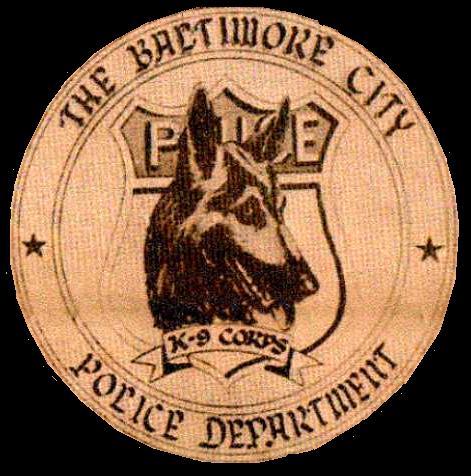
Original K-9 emblem from the inception of the unit in 1956

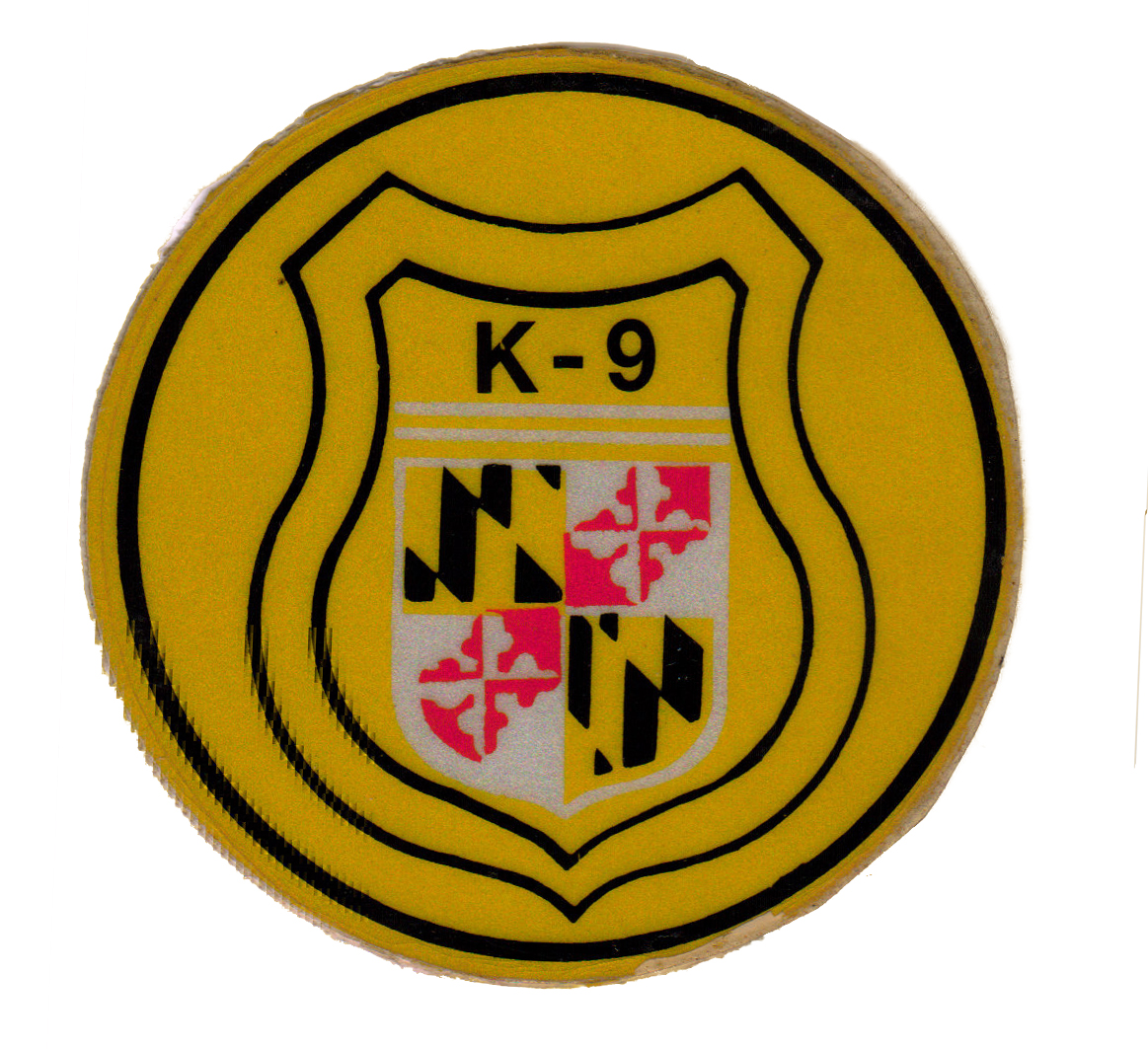
Training K-9 dogs in Baltimore 1956
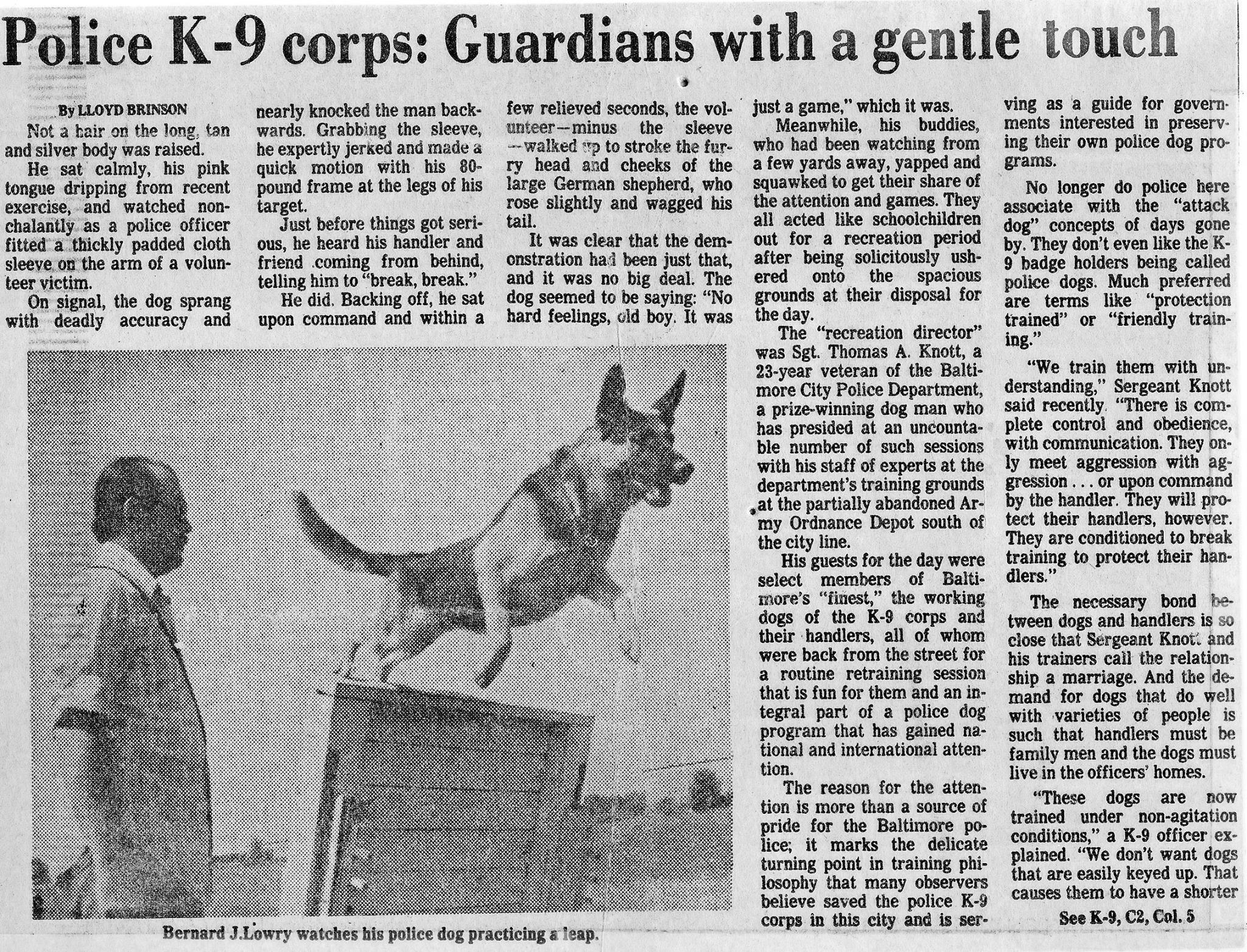
Courtesy Bernie Lowry

Bernie Lowry with Jako
Only Males with Nice Hips Need Ask For Some Jobs in Police Department
17 June 1979
The Baltimore City Police Department is making no secret that in its latest effort to bolster the force, only males with good hips need to apply. The age requirement has also been lowered, and lineage and race arc qualifying considerations. A few other requirements have been added. After a 14-week training session, the recruit will he expected to work very closely-in fact on a leash-with a veteran officer and live with that officer's family for the rest of his life. The recruits are of course DOGS. The requirements come from the department's K-9 unit, which is seeking shepherd dogs of German ancestry, 12 to 18 months old, to replace ailing and retired dogs. There is only one foreigner among the present squad of shepherds, a Bouvier, which Sgt. Thomas G. Hoffa, acting supervisor of the unit, describes as an overgrown shaggy dog. Sergeant Hoffa explained that the dog patrol, like the force's human counterpart, has been understaffed for some time and that one <tog died recently and two others will be retiring for medical reasons. The department is hoping to increase the dog patrol by 14 and is appealing to the public to donate shepherds, a gift which is tax deductible for the donor. Before they are accepted, however, all canine applicants will be put through a rigorous physical examination, beginning with an X-ray of their hips. If an animal does not pass the hip test, it will be returned to the donor without further examination.
Sergeant Hoffa explained that many shepherds "have a hip disclosure problem," in which the hip dislocates. While the condition may not affect house pets, it can cut short the average eight-year working life of police dogs, because "they spend a lot of time in the street." The new recruits will be trained to obey and protect. Some will specialize in sniffing out narcotics, weapons or explosives, or tracking lost children and suspects. Specialties will depend on the investigative preference of each dog's master. When they are not working, the dogs will be at home with their masters, serving as mild-mannered house pets. Donations can be made by calling the Police Department at 396-2475
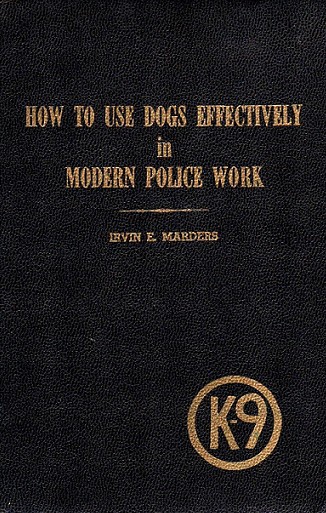
How to Use Dogs Effectively in
Modern Police Work
by Irvin E. Marders
Modern Police Work
by Irvin E. Marders
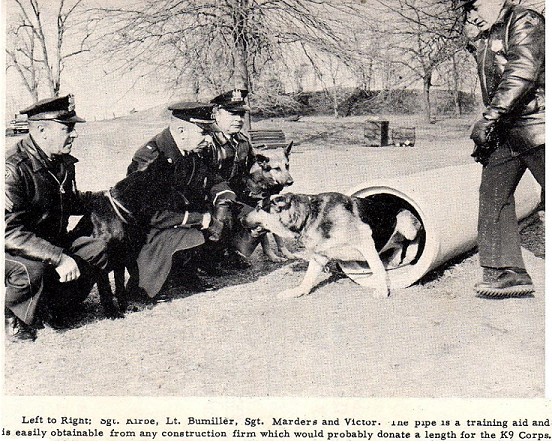
LEFT TO RIGHT: SGT. KERBE, LT. BEMILLER,
SGT. IRVIN MARDERS & K-9 "VICTOR"
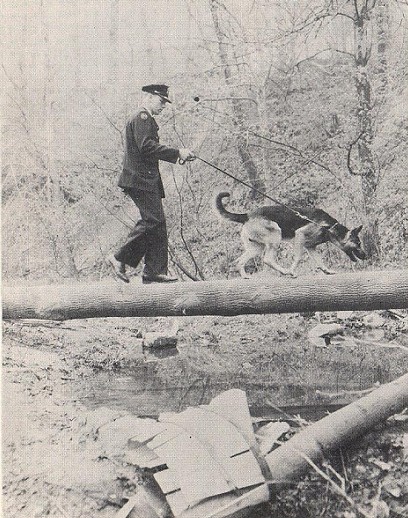
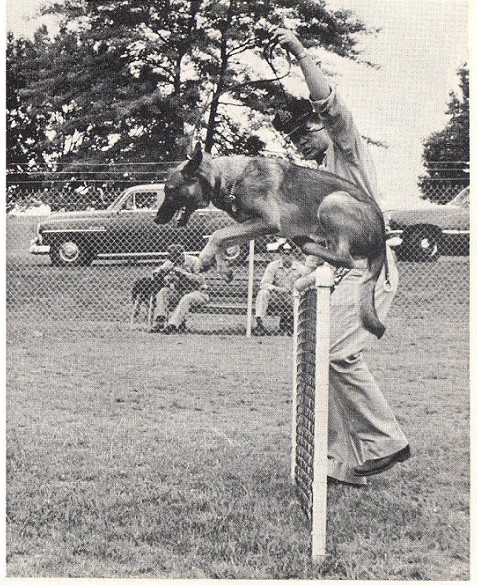
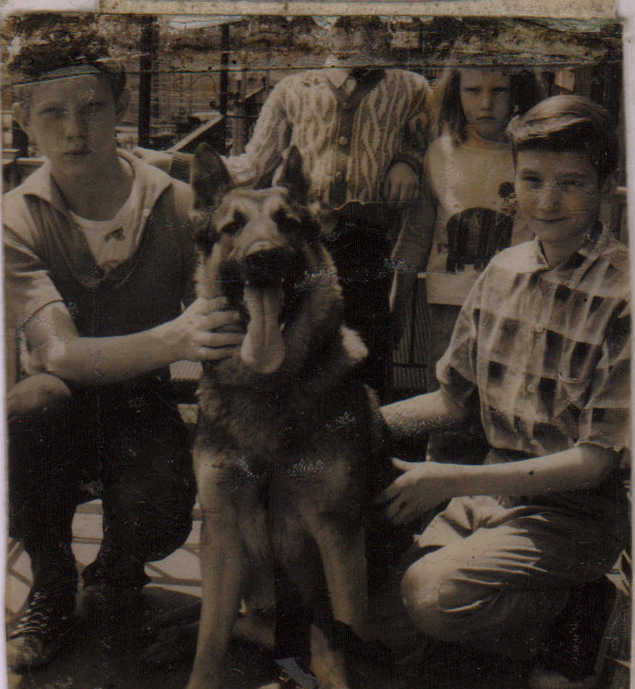
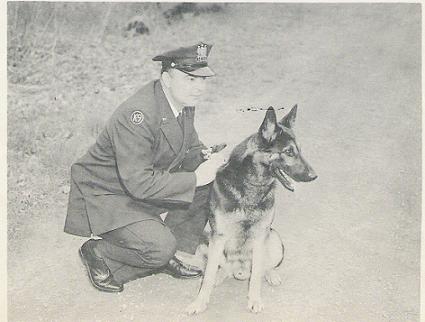
OFFICER IRVIN MARDERS IN 1956
TRAINING THE K-9 TO RESPOND TO AN ARMED PERSON AND PROTECT THE OFFICER

OFFICER HUGH MILLS far left.
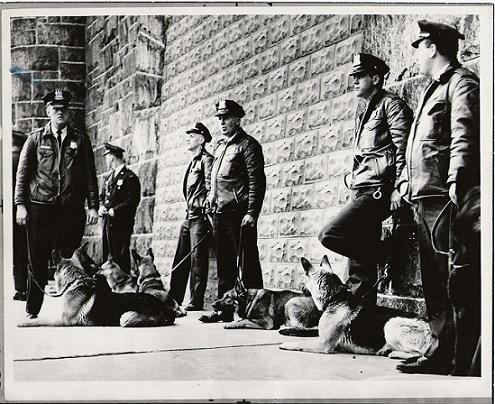
BALTIMORE POLICE COMMISSIONER JAMES HEPBURN
OFFICER IRVIN MARDERS WITH THE 1ST. K-9
MAJOR VON GRUNTS, BALTIMORE'S 1ST K-9 DOG
K-9 UNIT ESTABLISHED 1956
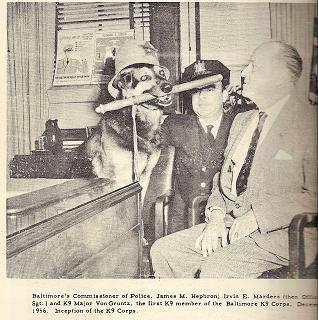
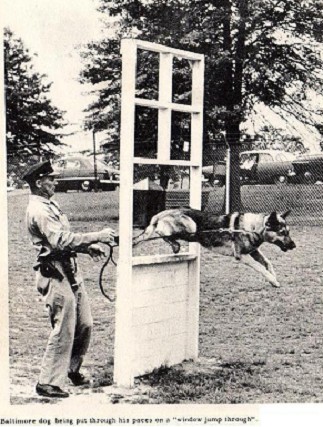
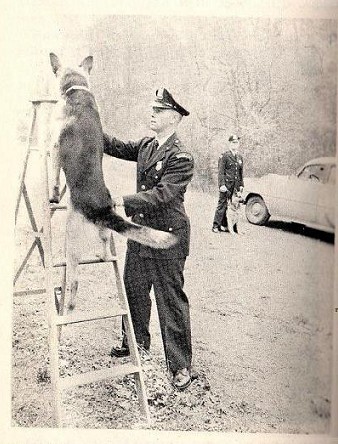
Services set for Irvin E. Marders, Police Veteran
3 Aug 3, 1986
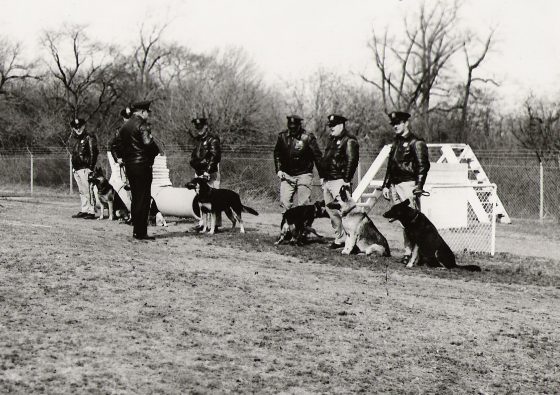
Service is Set for Ret. Sgt. Irvin E. Marders, Police Veteran
Funeral services for Ret. Sgt. Irvin E. Marders, a retired Police Department Sgt. who helped organize the city’s canine corpse, will be at 11:30 AM tomorrow at Dulaney Valley Memorial Gardens, 200 Padonia Rd. A graveside service will follow at 2 PM at the Arlington National Cemetery in Virginia. Ret. Sgt Marders died Thursday after he suffered a heart attack at his home on Walnut Avenue in Owings Mills. He was 65. Called ace by his friends, Ret. Sgt. Marder was widely known for his work over the years in Veterans Affairs. His most recent project was the establishment of a fallen hero’s day, which was observed for the first time in May, to honor fallen members of the Police and Fire Departments. With the rank of first Sgt., he served in 1942 to 1946 in the South Pacific with the Army engineers, 32nd division. He was awarded the Purple Heart. While in the Army he was graduated as a dog trainer from the San Carlo center in California. He later received certification from the Maryland police training commission, qualifying him to teach canine procedures. He joined the Baltimore Police Department in 1947 and was a member of the force for 28 years, as one of the organizers of the K-9 unit in 1956, he was master handler of Major, one of its first two K9 Dogs along with Major Von Grunts, was Turk the two were the first two dogs to serve as K( for the city of Baltimore. When he retired there were 86 dogs in Baltimore's K-9 force, a force that was listed as the best in the country.
Ret. Sgt. Marder wrote the book on K9 Handling, literally, he wrote a book called, "How to use dogs effectively in Modern Police Work" a book that not only sold well, but became the go-to book in law enforcement, and is of this day almost impossible t find a copy, those that have them are holding them and those that are selling want top dollar. Ret. Sgt. Marders was commander of the Baltimore police post of the veterans of foreign wars in 1954 and 1955. He served as the state commander in 1960 and 1961. Ret. Sgt. Marders, a member of the disabled American veterans in Towson, had been the Davis legislative representative in Annapolis and at the time of his death was a judge advocate of the organization. He was also a member of the American Legion, post 116. He had attended law enforcement classes at Northwestern University, he was a member of the national police bloodhound Association.
Ret. Sgt. Marders was active in the Maryland state law enforcement officers Association; the fraternal order of police Lodge number three; the Sons of Confederate veterans; the Veterans Association of the 32nd division in Wisconsin in the international police Association, region 16, and Towson. For many years Ret. Sgt. Marders lobbied for state funding of grave liners for burial plots for veterans, a measure which legislation finally passed this year. He is survived by his wife of 43 years, the former Catherine HUD Berg; his mother, Lillian Gephardt; a brother, Earl T. Marders; a daughter, Jay. Lynn Galardi; three grandchildren; and two great-grandchildren. All are from Baltimore.
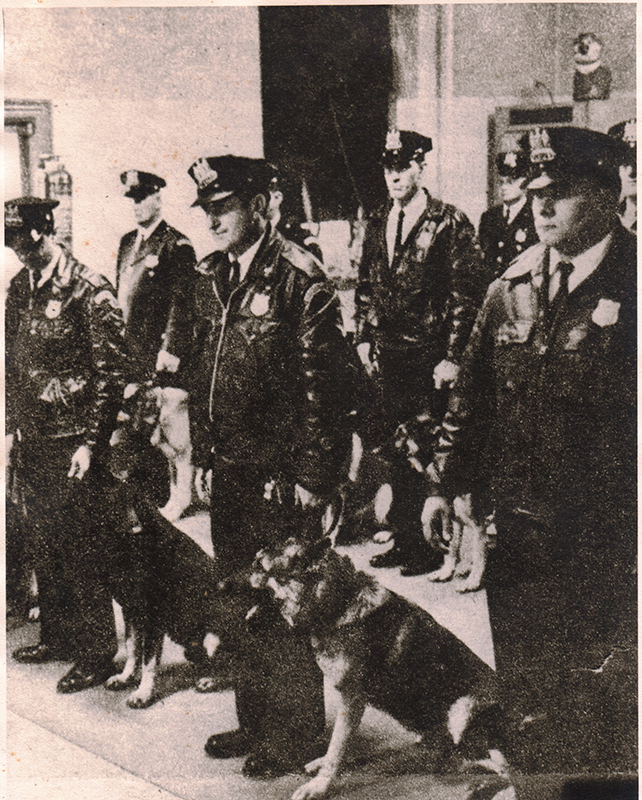
Robert A Miller w/ Tuefel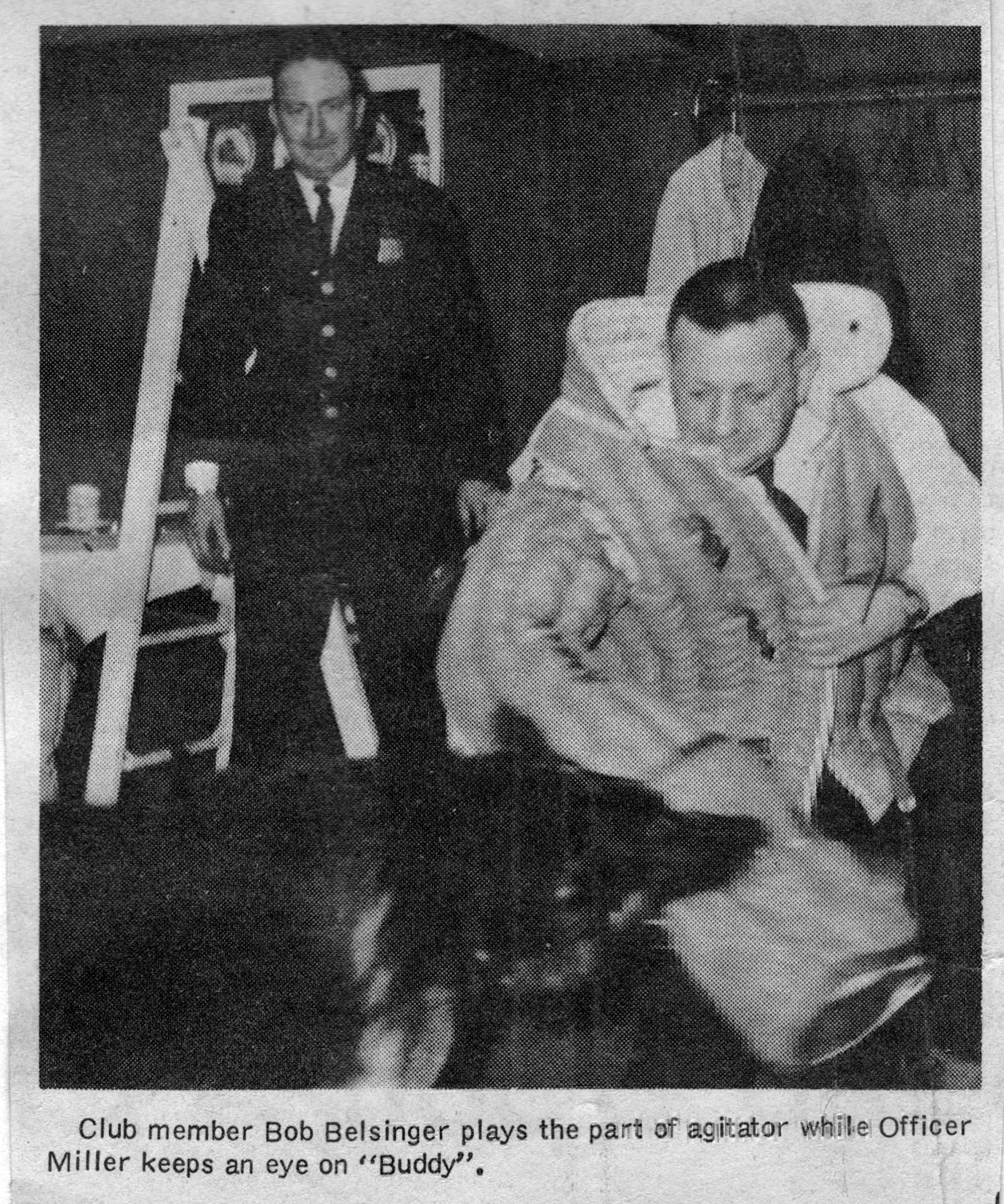
Officer Miller w/ Buddy
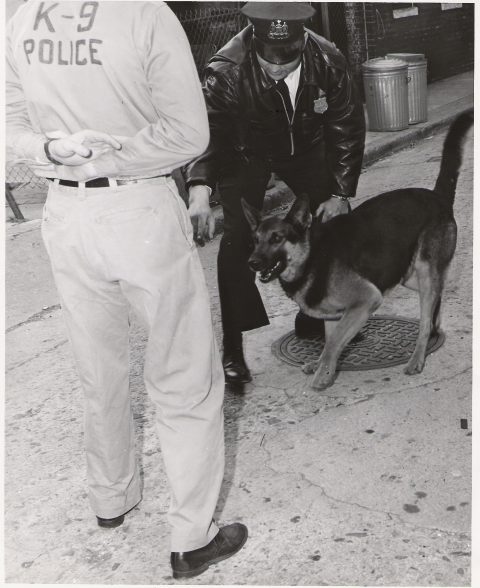
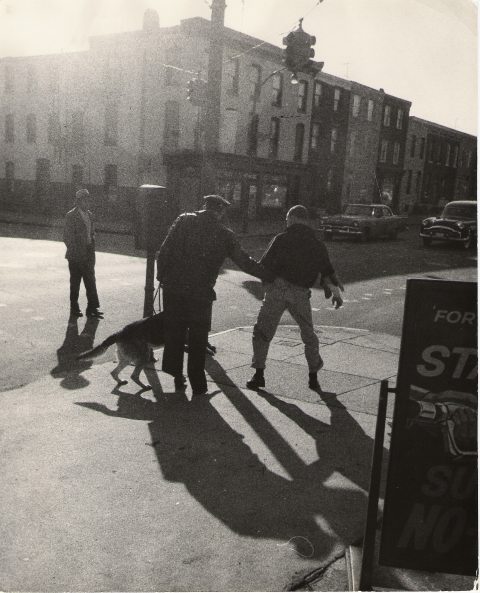
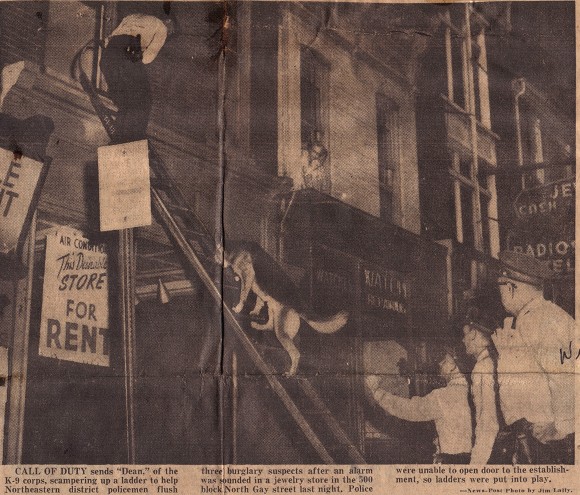
July 12, 1957, Sergeant Wilbert Sudmeier (far right.)
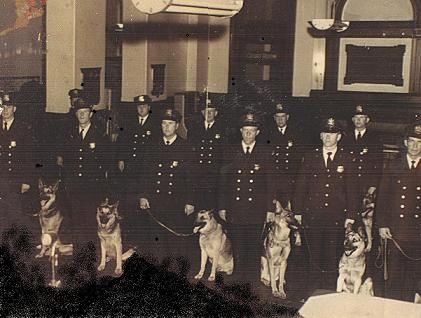
OFFICERS & K-9's at ROLL CALL LATE1950's
The Baltimore Police Department possessed one of the largest canine units in the United States and were experimenting with a new method of training that came to be known as the “Baltimore Method”. The “New Method” of training dictated that the canines be sociable, allowed to be in and around the general public, and reside in the handler's residence. Most canines up to this point were extremely aggressive and kenneled when not in use. The Baltimore method is still one of the most prevalent training methods in the United States.
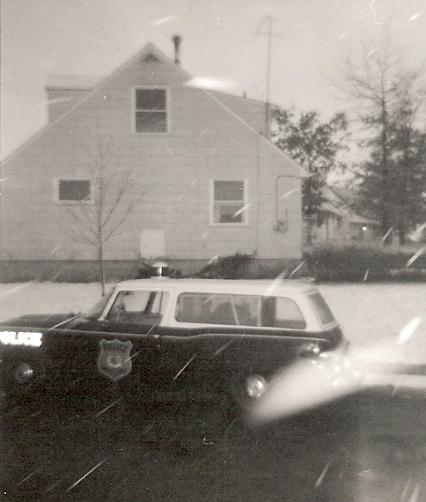
Photo courtesy Cindy Stickline-Rose
K9 wagon used by Officer William Stickline on patrol
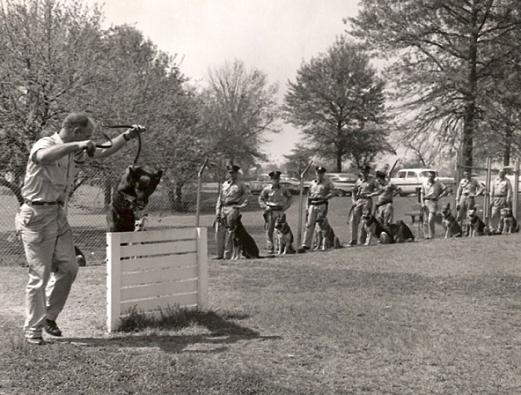
Photo courtesy Cindy Stickline-Rose
Officer William Stickline and 'Serga' in training, they are 5th from the front
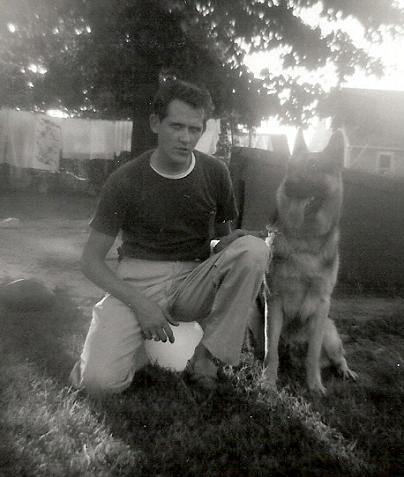
Photo courtesy Cindy Stickline-Rose
Officer William Stickline and his first police dog, "Serga", relaxing at home after a long day searching for wanted criminals
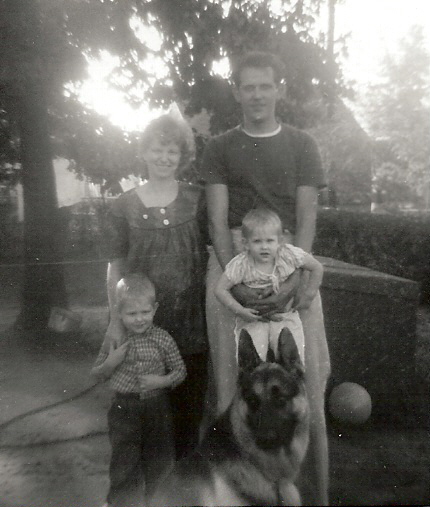
Photo courtesy Cindy Stickline-Rose
Officer William Stickline with his wife, Fay, daughter Joyce, son Ed, and Serga.
Mrs. Stickline is pregnant with another child at this time, another daughter named Cindy.
Cindy, as she grew up, became very attached to both dogs her father had while serving in the K9 unit. This shows just how a K9 dog becomes a member of the officer’s family
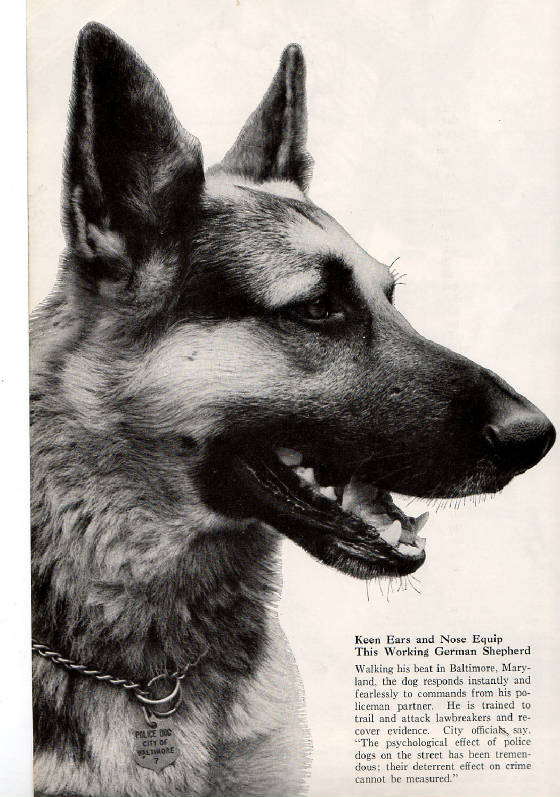
ARTICLE ON BALTIMORE’S K-9 UNIT
FEATURED IN THE NATIONAL GEOGRAPHIC MAGAZINE 1950’s
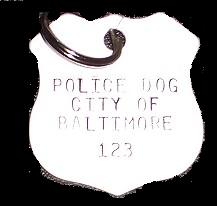

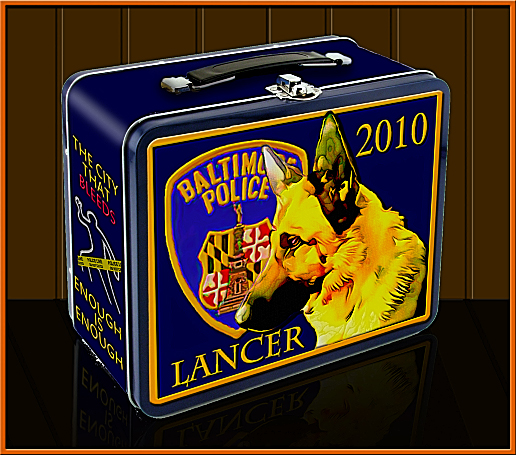
This was made in Photoshop for Bill Hackley a few years back

Courtesy of Steve Sturm
Painted by Me

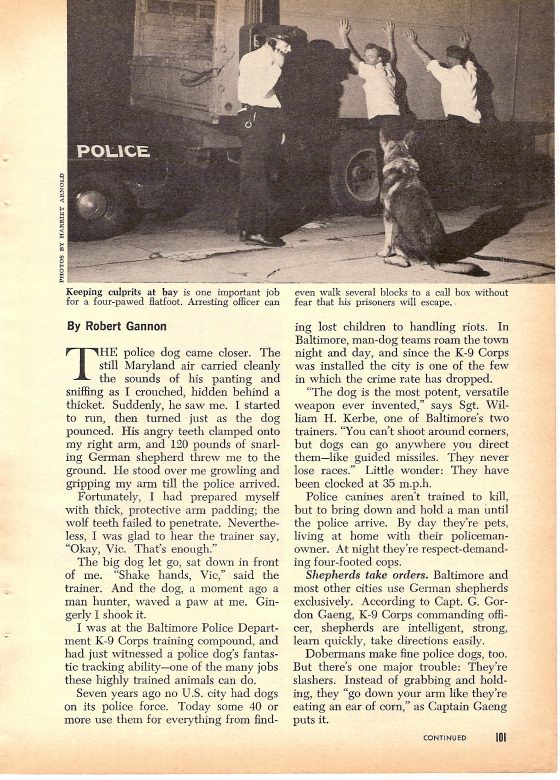
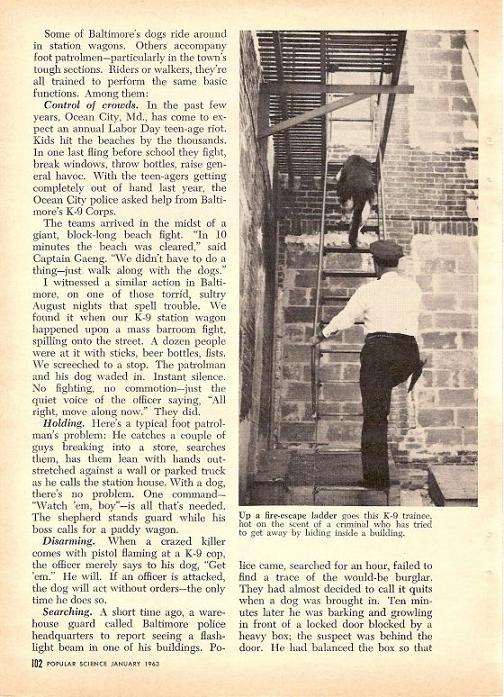
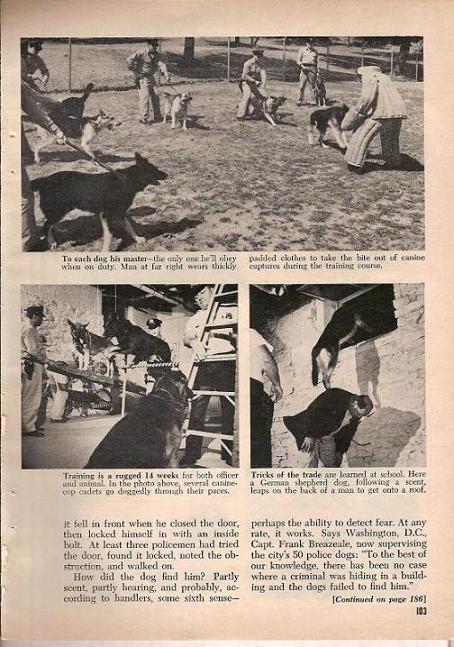
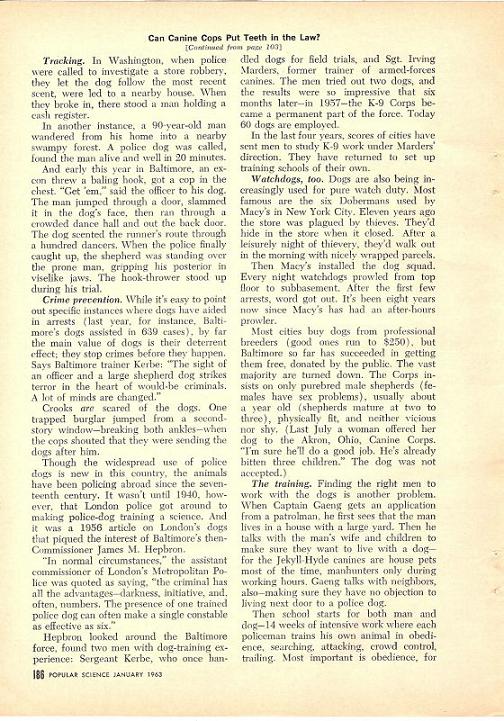
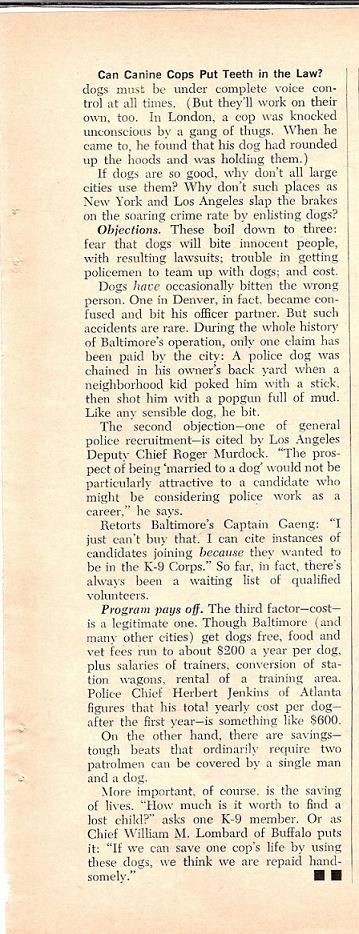

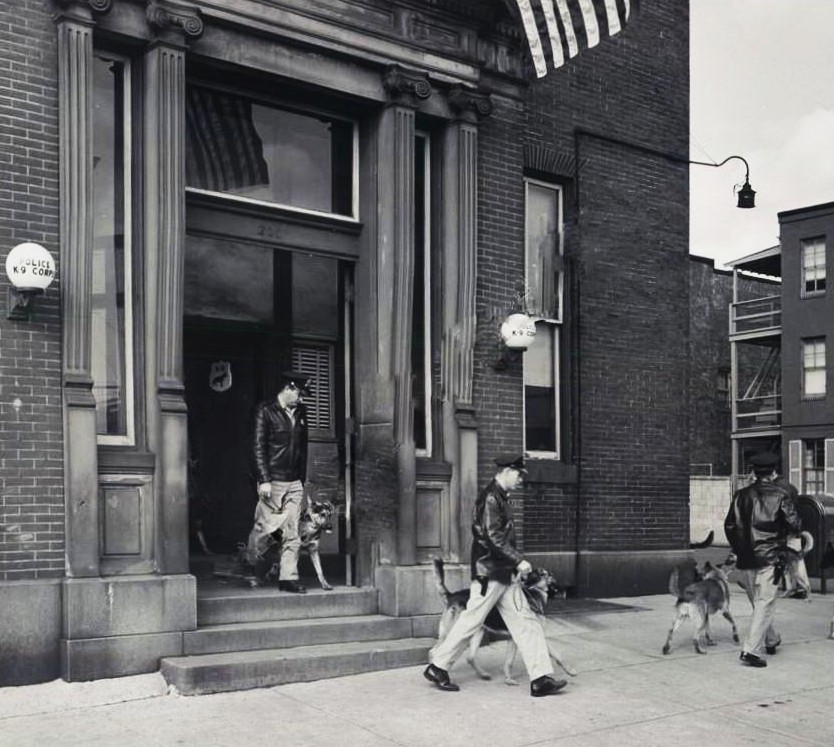
K9 officers and dogs leaving the K9 H.Q. located at Pratt & Calhoun Sts.

K9 Graduation Class September 30, 1965
The 5th man from the right is Otts Coruzzi, later our liaison man at the Motor Vehicles in Glen Burnie

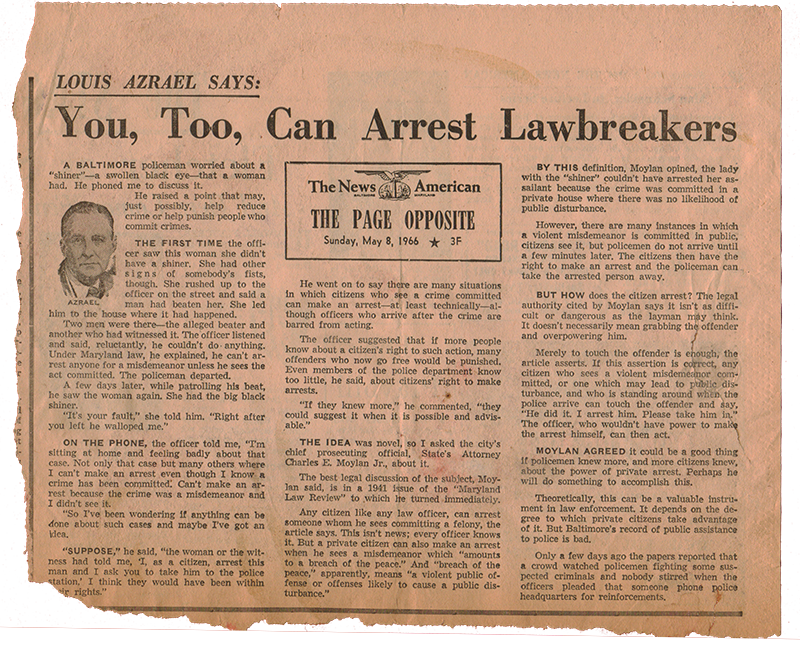


1960 FORD K-9 STATION WAGON PARKED IN FRONT OF THE TACTICAL SECTION - K-9 HEADQUARTERS.
(THE OLD SOUTHWESTERN DISTRICT)
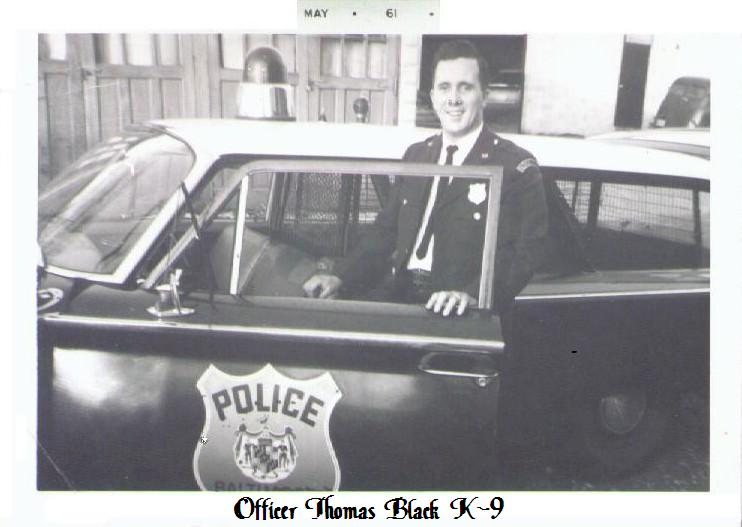
AT PRATT AND CALHOUN STREETS
Officer Tom Black K9 Unit 1961
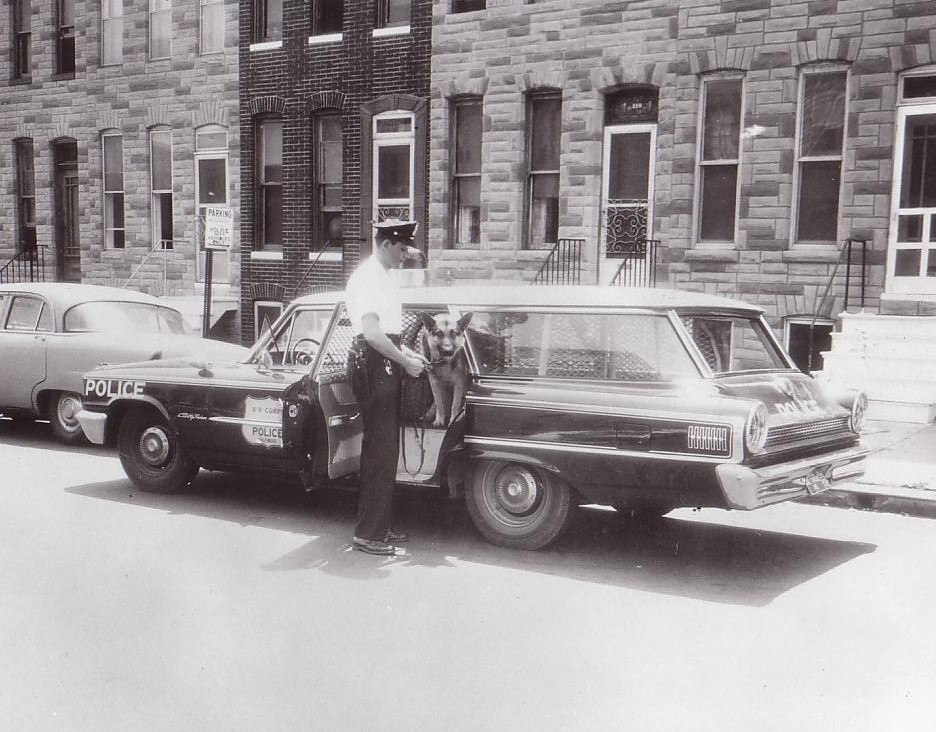
1963 FORD K-9 WAGON AT K-9 HQ.


Officer Joseph Garpstas, Lt. John Biemiller, K-9 Commander, bid farewell to K9 dog "Sarge"
as he begins his retirement from active duty. Joseph J. Garpstas, 84, of Crisfield and formerly of Glen Burnie, died Thursday, August 28, 2014, at Coastal Hospice at the Lake in Salisbury. Born in Baltimore on April 9, 1930, he was the son of the late Joseph C. and Margaret Bathgate Garpstas. He had been making his home in Crisfield for the past 27 years. He was a retired Baltimore City Police Officer working from 1951 until 1977. He was one of the original K-9 officers and later was an instructor.Mr. Garpstas was a member of the former Crisfield Kiwanis Club and spearheaded the Christmas toy drive for many years. He was also a member of the US Coast Guard Auxiliary Crisfield, Knights of Columbus, and the USMC Reserves. He is survived by his wife, Alfreda Lehmann Garpstas of Crisfield; two daughters, Susan Hose and Brenda Garpstas, both of Crisfield; a sister, Dorothy Braithwaite and husband Don of Deal Island; a grandson, Brian Garpstas and wife Kelly of Crisfield; three great-grandchildren, Ashley, Amber and Emily Garpstas, all of Crisfield; and a great-great-granddaughter, Anabelle Garpstas of Crisfield. Along with his parents, he was preceded in death by his son, Dougie Garpstas

Photo courtesy Officer Bill Hough
Officer Edward Dayhoff and his K-9 partner "CHAMP"

Photo courtesy Officer Bill Hough Officer Dave Maguire and his K-9 partner
assist in making an arrest during a disturbance at Western High School.
assist in making an arrest during a disturbance at Western High School.

Photo courtesy Officer Bill Hough

Officer Bob Powell and Partner "Blackie"
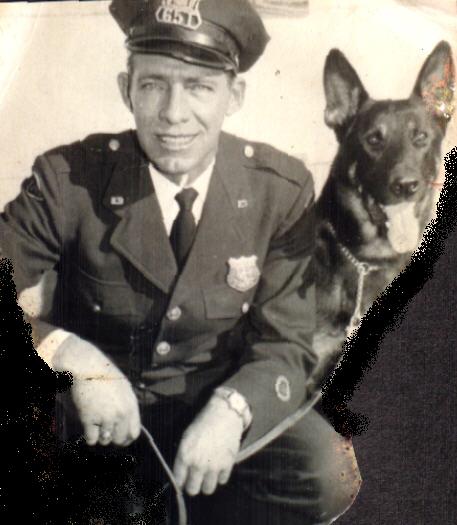
Patrolman William E. Bruff with his dog Tex
![]()
On August 16, 1971, at the monthly meeting of the K-9 Law Enforcement Association, Officer David Stuller of the Tactical Section K-9 Unit was presented with a plaque to commemorate the loss of his dog, Shane, who died in the line of duty in June of this year.
The Plaque was presented by Commissioner Donald D. Pomerleau and Association President Paul Mossberg of the Frederick City Police Department at the meeting which was held at the Stafford Hotel. The presentation was also attended by Deputy Commissioner Frank J. Battaglia, Lieutenant Colonel Donald T. Shanahan, Captain Francis X. Hayes, and Lieutenant Horace M. Lowman.
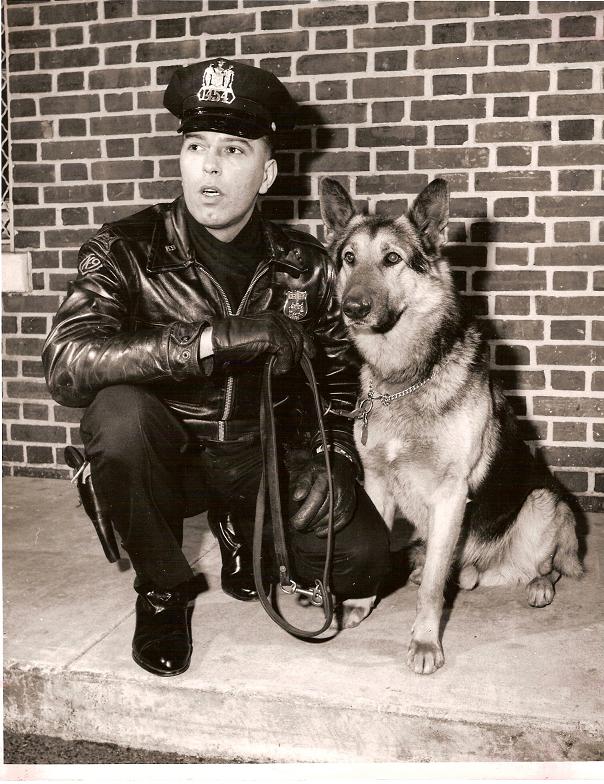
K-9 UNIT: An Asset To Patrol
April 1974
His badge number is 182. He has been a member of the Department for over two years and has never driven a radio car. He works shift work and always has a driver who takes him to calls all over the city. All of his meals are supplied and paid for by the department. He received fourteen weeks of intensive training after he passed a rigorous physical examination and goes back to school for two days about every three weeks for retraining. If you believe he is receiving preferential treatment, you are right. He is four years old, his name is "Happy," and he is a four-legged member of the Department's Canine Unit. The Unit was formed in 1957 with two K-9 teams consisting of a dog and a handler. This Unit has expanded to its present authorized strength of forty-two teams. These dogs and handlers are on patrol around the clock manning downtown and hospital area foot posts as well as motorized patrol in specially selected areas of the city. While on their posts these units are available to assist other units of the Patrol Division whenever their specialized skills become needed. The development of a team into a useful tool in law enforcement requires a dedicated and capable handler, a specially selected dog and a highly skilled team of instructors. The Department, by successfully combining these elements, has gained an international reputation for proficiency in the use of Canines. Police representatives from other departments throughout the United States and other countries as well, have visited the training complex. Many have had units of their own trained by the Department. Representatives have come to the K-9 Training Center from Alabama, Montana, Louisiana and from as far away as South Vietnam, Peru, Hong Kong, and Guyana. The handlers are selected on a voluntary basis from among experienced sworn personnel. Before he is accepted the Officer is screened. He must have a residence suitable for properly caring for the dog and his family must be willing to receive the new member into their household. This process also includes detailed interviews and psychological testing.
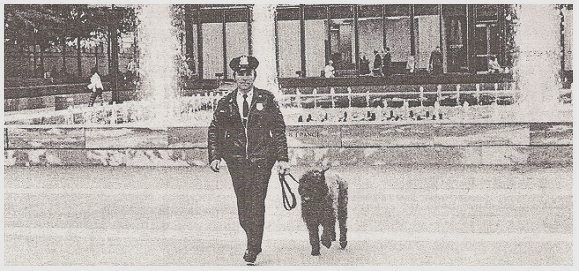
Officer Lawrence J. Malat patrols the Charles Center with his dog Bruiser, the first Bouvier des Flanders utilized in law enforcement in the United States.
All dogs are donated to the Department and are usually between 9 months and 1 1/2 years old when accepted. The training director, Sergeant Thomas A. Knott, inspects all dogs offered to ensure that they are in sound physical condition and of good disposition. Once found qualified the dog is turned over to a veterinarian for an extensive check-up to discover any possible physical or medical defects. The dogs and handlers are then paired and begin schooling. The team of instructors is comprised of two experienced trainers Officers William A. Lejewski and John F. Barnard. This Education and Training Unit is supervised by Sergeant Knott a twenty-three year veteran of the Department. Sergeant Knott has been training dogs for more than forty years. He is among the one hundred American Kennel Club Judges certified in Obedience and Tracking in the United States. He is also on the Advisory Council of the American Kennel Club and is an advisor to the Federal Government. During the fourteen weeks of schooling, the dogs are first tested for gun shyness and trained in basic and advanced obedience. The teams then become well versed in building and field searches for both subjects and objects. This training also includes the recovery of weapons. Among the thirty-nine dogs and handlers deployed by the Department, many are also proficient in specialized areas. Five are effective in bomb detection and over one-half of the dogs have proved to be reliable in drug detection. Recently a new training program was introduced to enable K-9 teams to detect the presence of deceased persons. The Officers, in their continuing effort to improve and refine the skills of their dogs, also spend many off-duty hours in training. Numerous teams hold American Kennel Club Degrees. The Companion Dog Degree can be obtained only after a dog receives a minimum score of 170 out of a possible 200 points by three different AKC judges in obedience. The Tracking Degree is awarded to a dog who follows a 500-yard track left by a stranger within 40 feet, under the watchful eyes of two AKC judges. The track must be from fifteen minutes to two hours old. This must be accomplished while on his handler's lead and at the end, locate an object left by the stranger. The special skills developed by the teams are applied almost daily. A systematic search of a large building for a suspect by a group of eight to ten officers would take three to four hours. The same search by a Canine team requires only one-fifth the time

Photo courtesy Lieut. Robert Wilson
Officer Larry Malat with his K9 partner
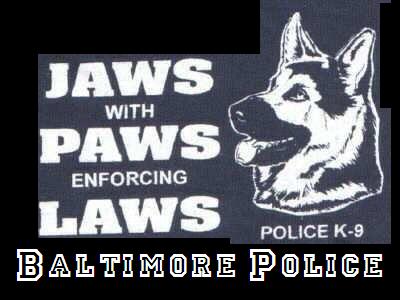
Officer Joseph M. Dunn assists his dog “King” after he located some narcotics during training
Occasionally more than one team is needed. On September 24, 1973, the night watchman was making his rounds at the downtown Hochschild Kohn store on Howard Street. On the fifth floor, he was overwhelmed by three burglars. One of the assailants struck him on the head with a pistol and the others tied him up before continuing on their rampage. The watchman was able to free himself and call the Police. Patrol Units responded, sealed off the building and notified the Canine Unit. Officer Francis Stewart and his dog “Snoopy” arrived first and began a systematic search. On the seventh floor, “Snoopy” alerted his handler that the suspects were near. Officer Stewart spotted two of the suspects lying on top of a beam running across the ceiling. He drew his service revolver, knowing that one of them might be armed and ordered them to come down. He then called for assistance on his radio, but due to the construction of the building, none of the other units were able to understand his message. Officer John Pflueger and his dog, “Rudy“, were sent in to locate the other team. Once the suspects were taken into custody, the Officers continued the search. On the sixth floor, “Rudy” became tense and excited, alerting Officer Pflueger that the third suspect was inside a closet. He was placed under arrest and since no weapon was found on him the search continued for the handgun. On the seventh floor, near where the first two suspects were apprehended, a loaded revolver was located. One of the most dramatic and rewarding cases handled by the Department's Canine Unit occurred in 1971. A retired Police Lieutenant wondered away from a convalescent home while recovering from a serious line of duty injury. Hours of intense searching failed to locate him and the Canine Unit was called. A number of teams were sent and the dogs picked up the track. They found the Lieutenant, over a mile from the home, unconscious and lying in a pool of water. His life was saved and full credit was awarded to the Officers, Instructors, and dogs who have exhibited that the Canine Unit is an effective tool in law enforcement.
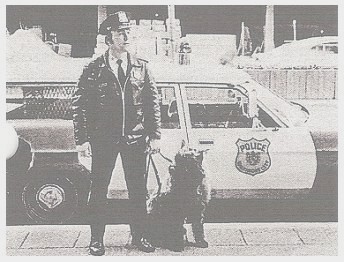
Officer Lawrence Malat & K9 "BRUISER"
'Bruiser, the Baltimore Police Department's first Bouvier des Flandres, still draws crowds of onlookers as he walks his post near Charles Center. Bruiser definitely does not fit the classic "picture" of a police dog. The Bouvier originated in Flanders, an ancient territory of France, which is now located within the borders of Belgium. The breed predates the 1800's but the specific dog we see today is a descendant of Bouviers which were recognized as a breed in 1910. Originally a farm dog the Bouvier is well suited to a variety of tasks, especially police work. Strong and alert the Bouvier's disposition makes him easy train. It is not the Bouvier's nature to be vicious but his devotion to his handler makes him an excellent K-9 because of his unfailing desire to carry out the commands and tasks given to him. K-9 Unit Adds Rottweiler April 1975 The classic image of a police dog at work is that of the dignified and alert German Shepherd at his handler's side. So embedded is that image that many people are somewhat dumbfounded when they see one of the other breeds of working dogs performing the same functions. Another unusual breed is the Rottweiler. Gus, now a member of the Department's K-9 Unit, represents a breed which qualifies as one of the first working dogs. Their history dates back to the Roman Empire when they were used to herd cattle. The Rottweiler is about the same size as the traditional Shepherd but the similarity ends there. His coat is short and is always black with tan markings on the muzzle, cheeks, chest, and legs. Attributes of the Rottweiler in law enforcement are his intelligence, size, steadiness and a good sense of smell. The dog is well muscled and compact. His demeanor is dignified and he is not easily excited. Gus, who has been on the street for just a few weeks has never failed to energetically perform the many tasks assigned to him.
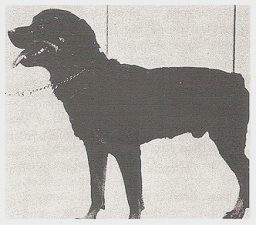
Another unusual breed is the Rottweiler. Gus, now a member of the Department's K-9 Unit, represents a breed which qualifies as one of the first working dogs. Their history dates back to the Roman Empire when they were used to herd cattle. The Rottweiler is about the same size as the traditional Shepherd but the similarity ends there. His coat is short and is always black with tan markings on the muzzle, cheeks, chest, and legs. Attributes of the Rottweiler in law enforcement are his intelligence, size, steadiness and a good sense of smell. The dog is well muscled and compact. His demeanor is dignified and he is not easily excited. Gus, who has been on the street for just a few weeks has never failed to energetically perform the many tasks assigned to him. Gus, who is handled by Officer Tobe A. Morrow, is the first Rottweiler utilized by the Department. Both Bruiser and Gus have taken their place within the K-9 Unit and have been accepted as members of the Baltimore Police Department. Members of the Department are invited to stop and meet them as they patrol their assigned areas or call for aid whenever their expertise can be helpful to assist in unusual situations. Their handlers are used to answering the many questions that come their way. As for the dogs. . . you should meet them. They can be very friendly
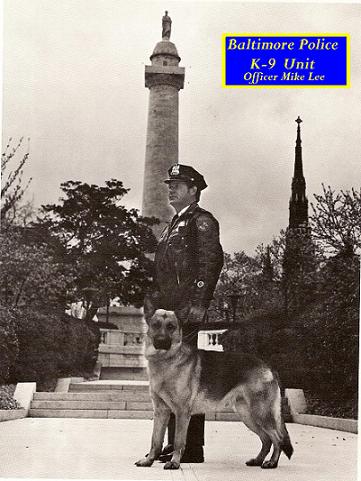
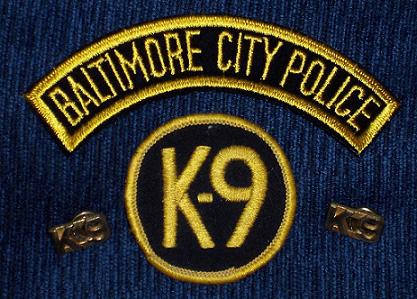
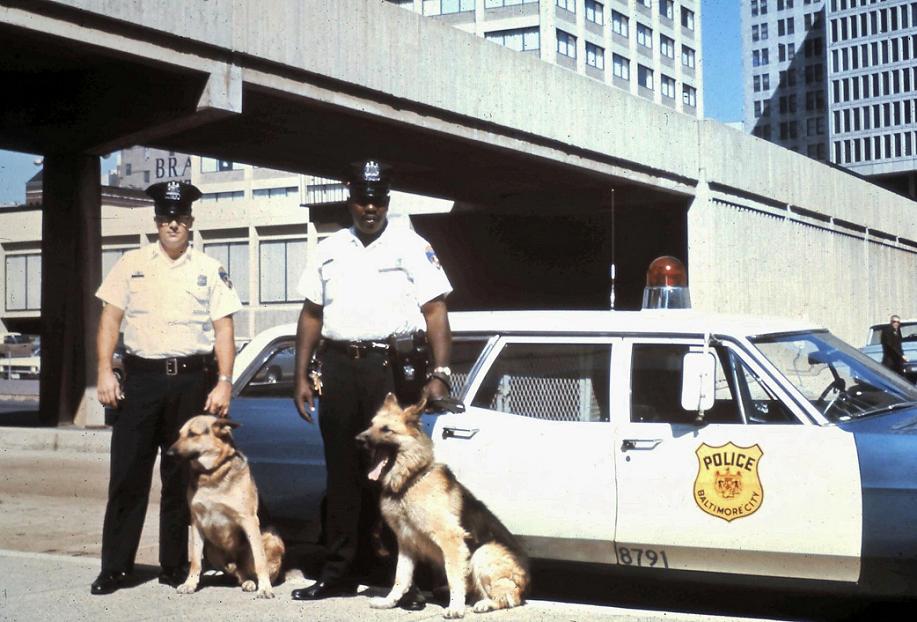
Officer Bob McCall (R) with his K9 partner on patrol in the downtown area
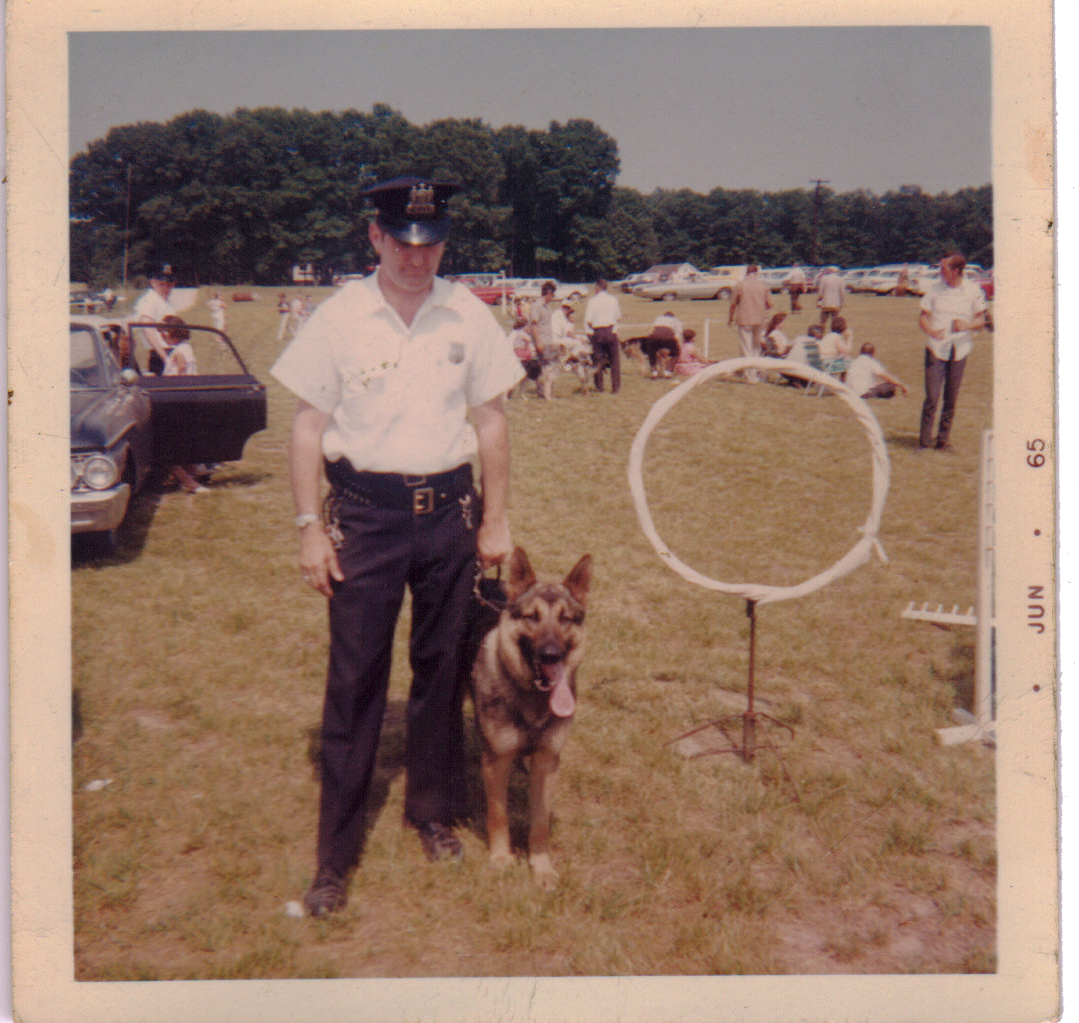
Courtesy Robert Miller
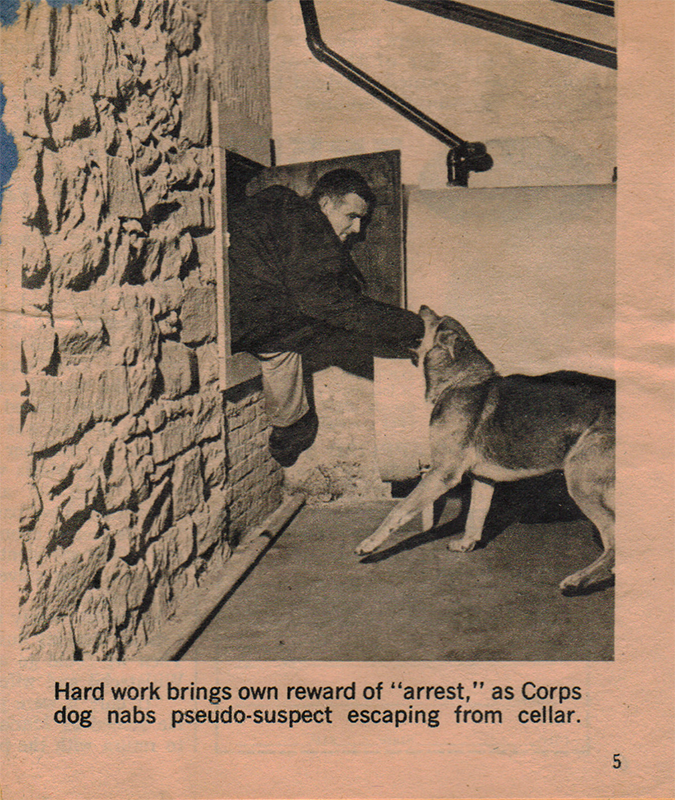
Courtesy Robert Miller

Courtesy Robert Miller
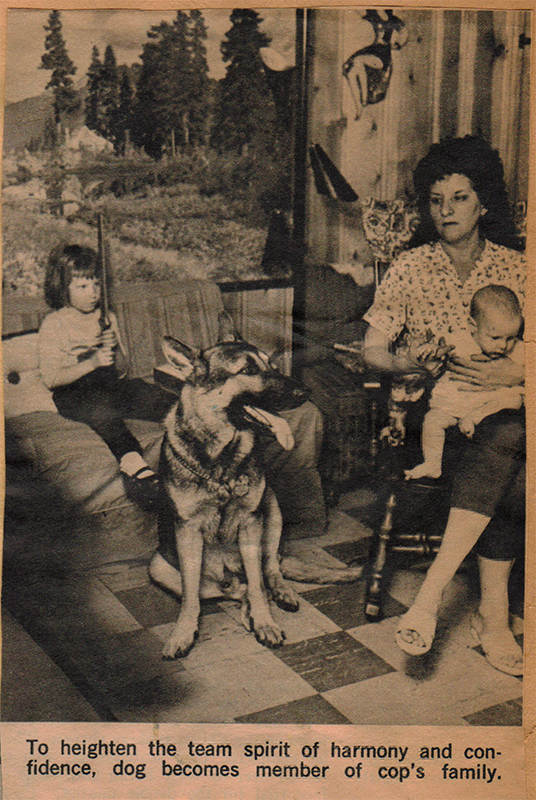
Courtesy Robert Miller
As a side note this is Robert Miller's Family
As a side note this is Robert Miller's Family
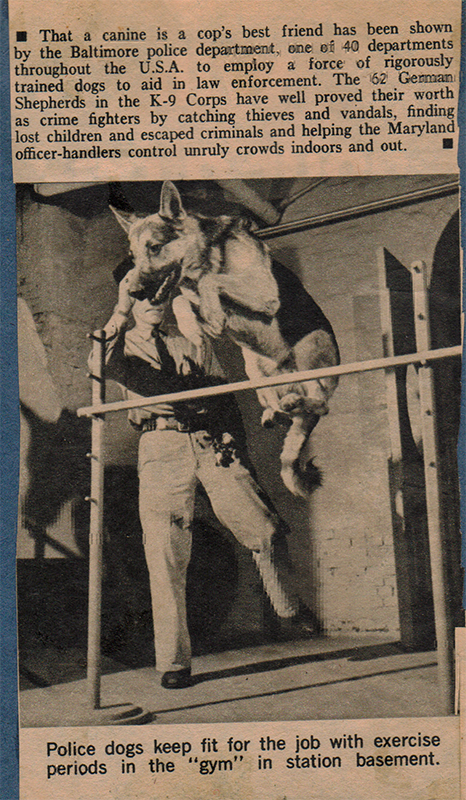
Courtesy Robert Miller
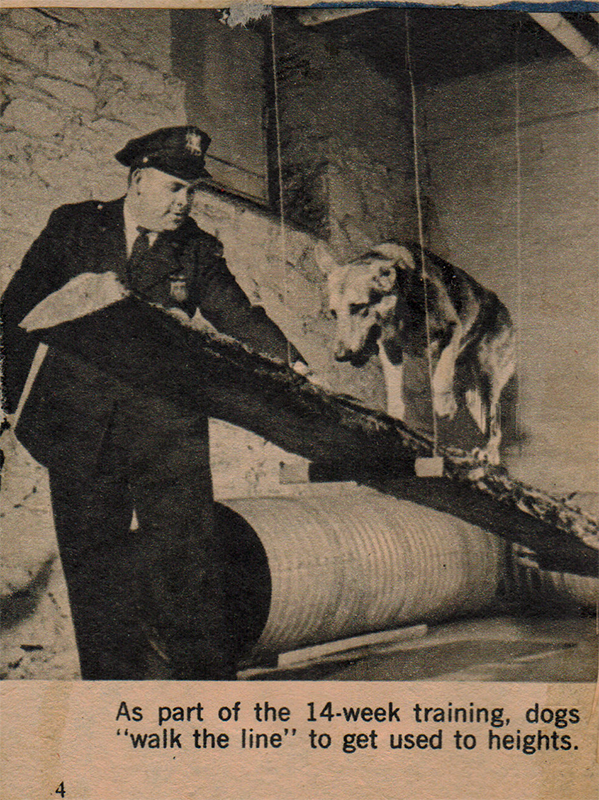
Courtesy Robert Miller
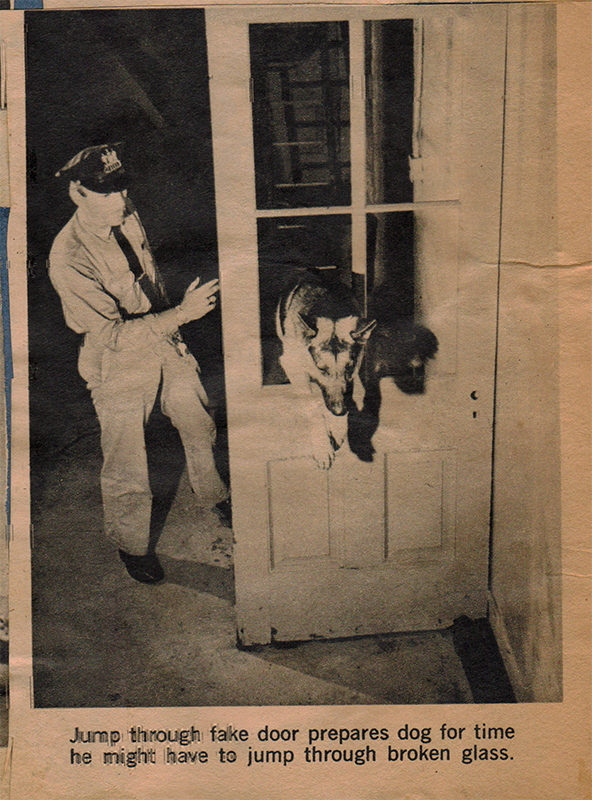
Courtesy Robert Miller
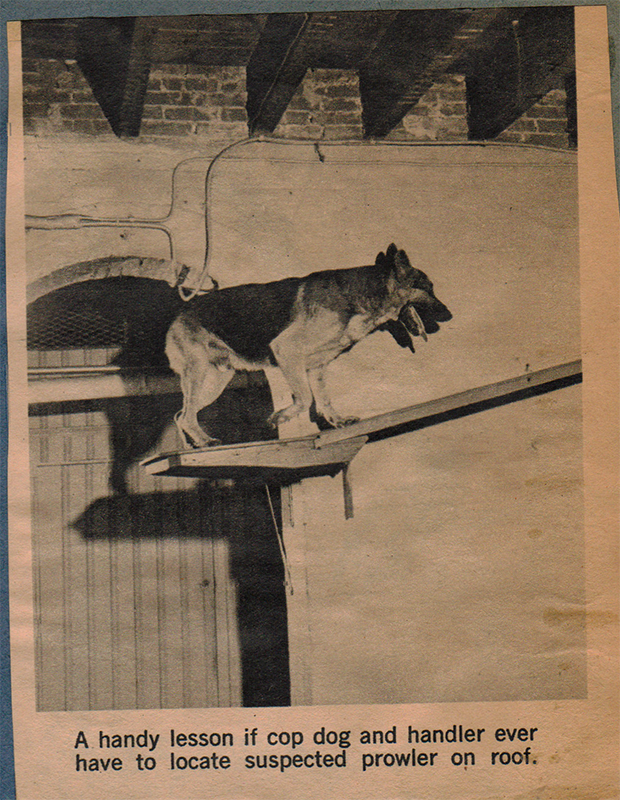
Courtesy Robert Miller
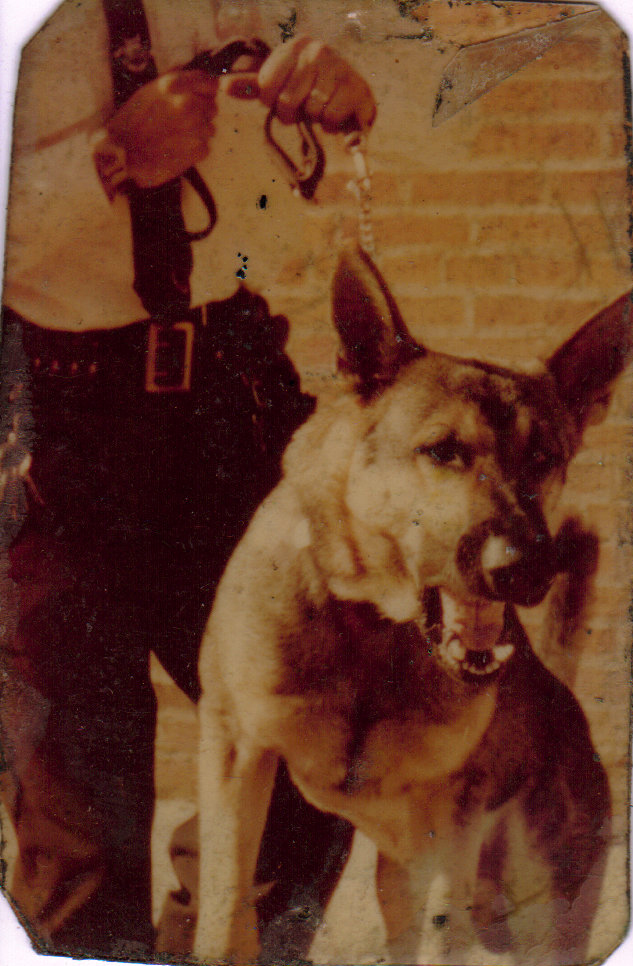
Courtesy Robert Miller
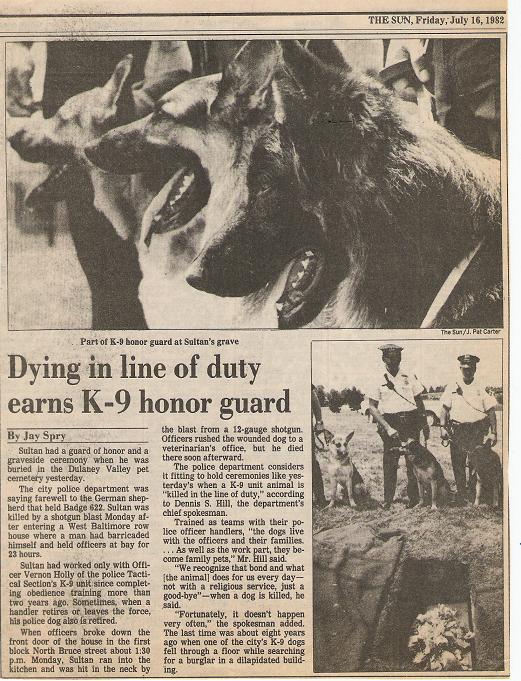

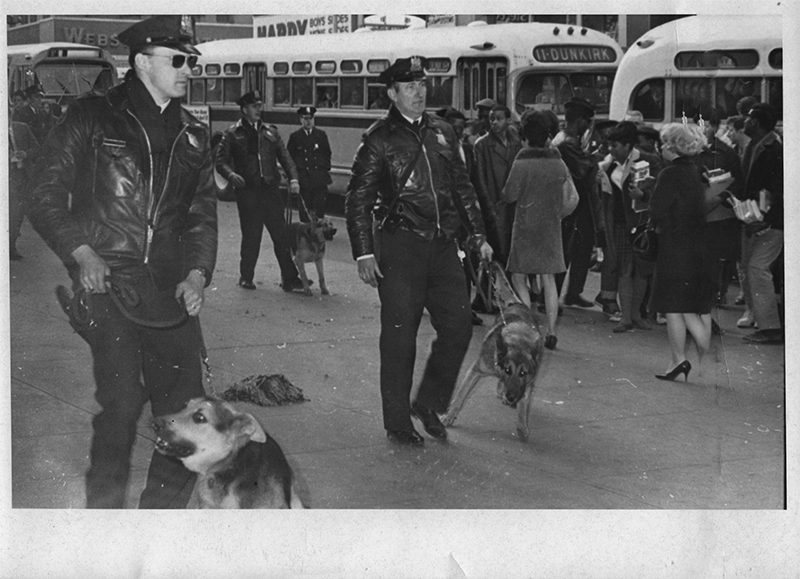
Courtesy Robert Miller

Called to Give My All
I am a Police dog in a canine crew
I’ve been trained to see it through
When danger is near, my ears perk up
They taught me as a pup
I’m often there to protect your rights
My presence sometimes hinders fights
I never attack with thought to kill
When subduing one, my job I fill
I never worry a single thought
As to how I’ll fare at a certain spot
The love I have for my handler’s care
Is all I need each day to fare.
(Author unknown)
The Rainbow Bridge
There is a bridge connecting heaven and Earth.
It is called the Rainbow Bridge because of its many colors. Just this side of the Rainbow Bridge is a land of meadows, hills and valleys, all of it covered with lush green grass. When a beloved pet dies, the pet goes to this lovely land. There is always food and water and warm spring weather. There, the old and frail animals are young again. Those who are maimed are made whole once more. They play all day with each other, content and comfortable. There is only one thing missing. They are not with the special person who loved them on Earth. So each day they run and play until the day comes when one suddenly stops playing and looks up! Then, the nose twitches. The ears are up! The eyes are staring! You have been seen, and that one suddenly runs from the group! You take him or her in your arms and embrace. Your face is kissed again and again and again, and you look once more into the eyes of your trusting pet. Then, together, you cross the Rainbow Bridge, never again to be separated.

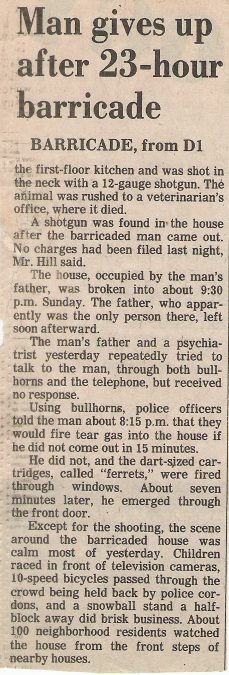
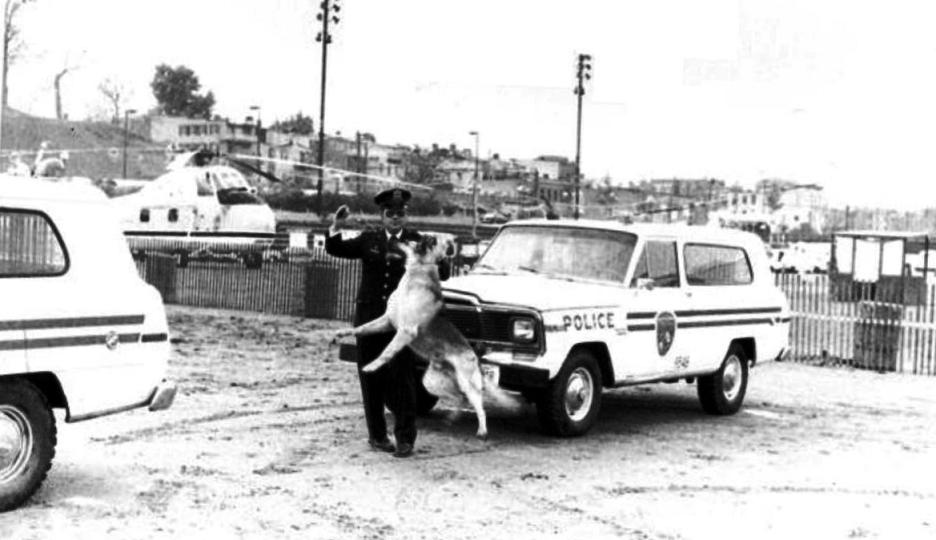
PHOTO COURTESY OFFICER GEORGE PARSONS
Officer George Parsons with his K9

Photo Courtesy Lt. Robert Oros

Officer Charmaine Thomas kneeling behind her partner "Bear", in the grass in Druid Hill Park. Bear is still with us, at 14 years old. He worked for 7 years in the K9 unit, working as an EOD, Drug Detection, Tracking, Building search, and Protection trained dog. When Officer Charmaine Thomas transferred to the Executive Protection Unit, he was the first ever K9 dog who was assigned to work in EPU, where he served an additional 3 years. Bear became an EOD only dog, they assisted the K9 unit when needed, along with conducting any bomb sweeps for visiting dignitaries. He retired at 11 years old, and would still like to go to work with her, three years later, if he could. He is a very special dog. Both were very proud to have been a part of that unit. I learned that "Bear" an exceptional K9 was just put down this past Friday March 26, 2010. "Bear" was a long time member of this agency, please keep his devotion to duty and the many things he did for the agency and its members in your hearts as well with his handler Charmaine who is dealing with his loss. Thank-you both for your service.

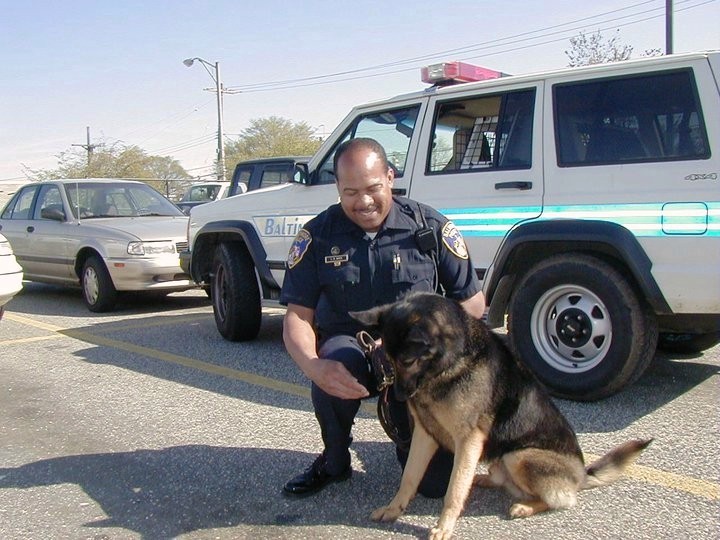
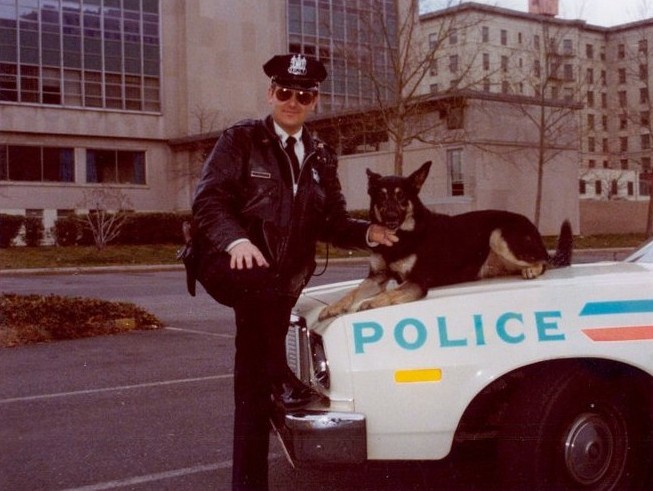
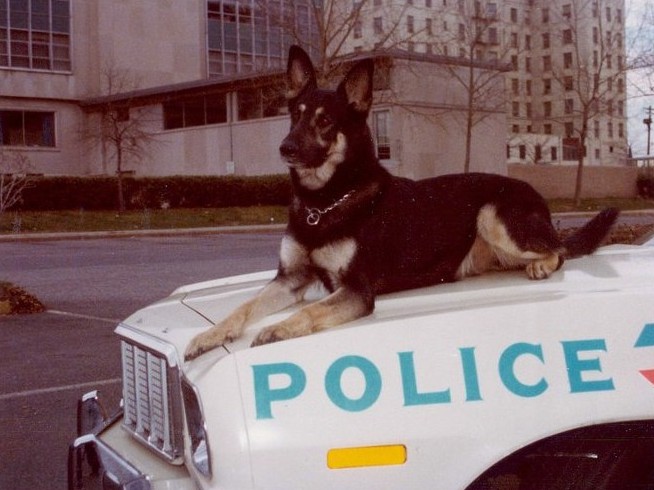
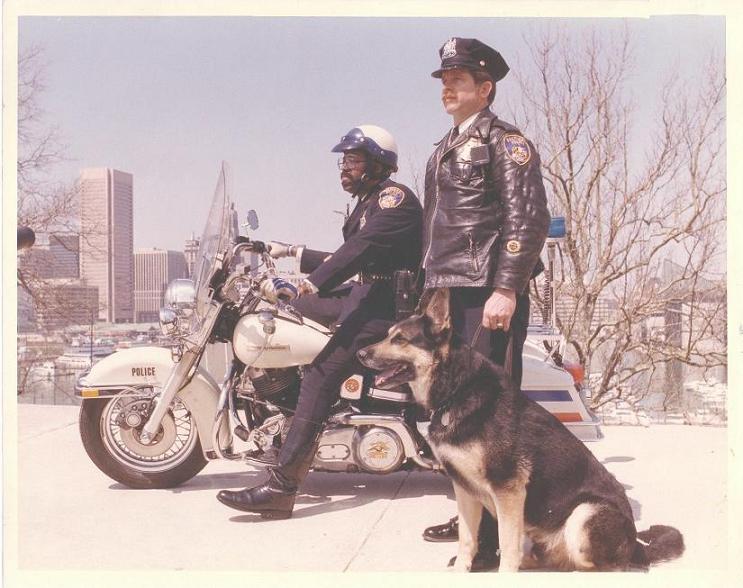

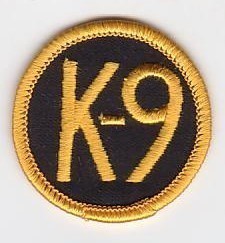
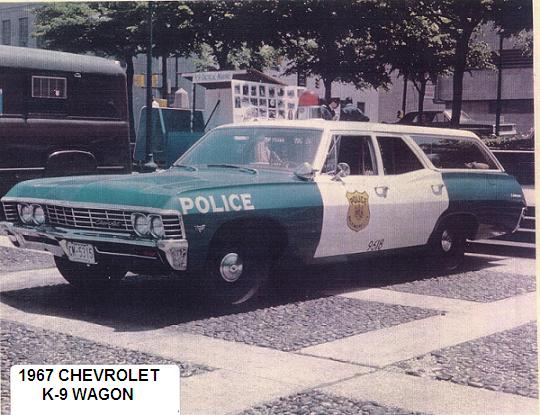

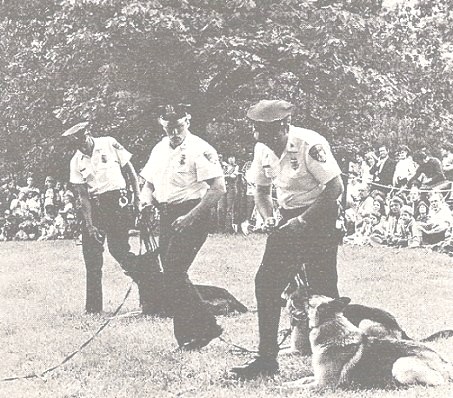
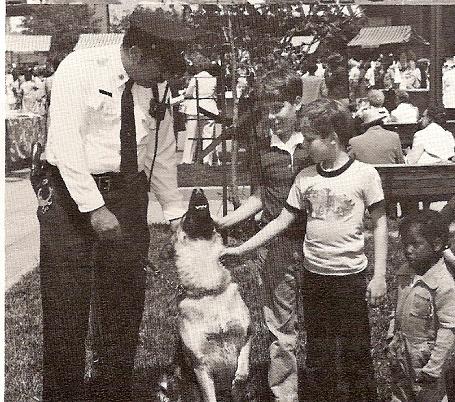
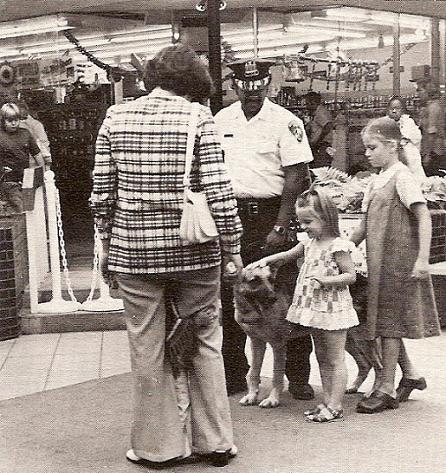
K-9 Officers at the City Fair 1978
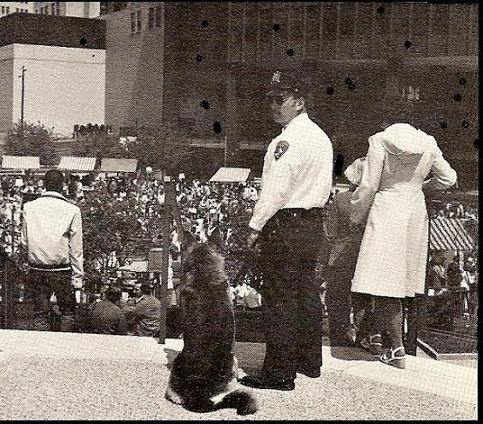
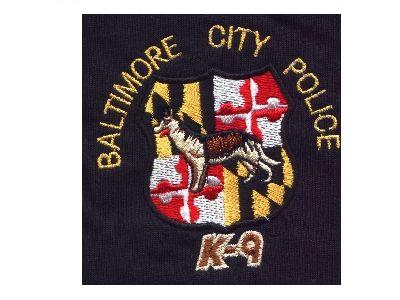
BALTIMORE POLICE K9
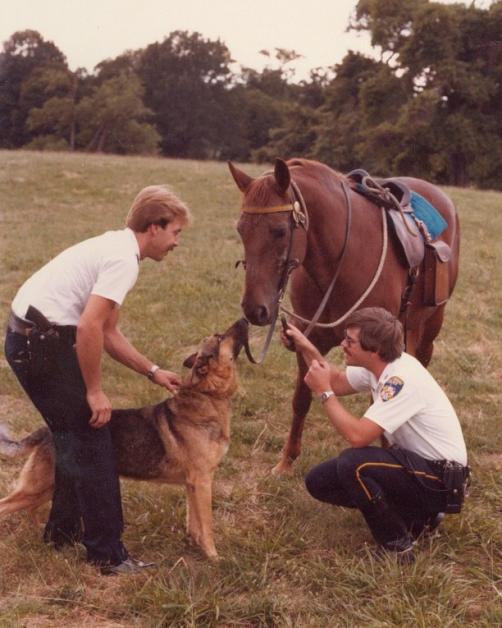
Officer Tom Bailey and Officer Kevin Reed with "Red" & "Rocky"
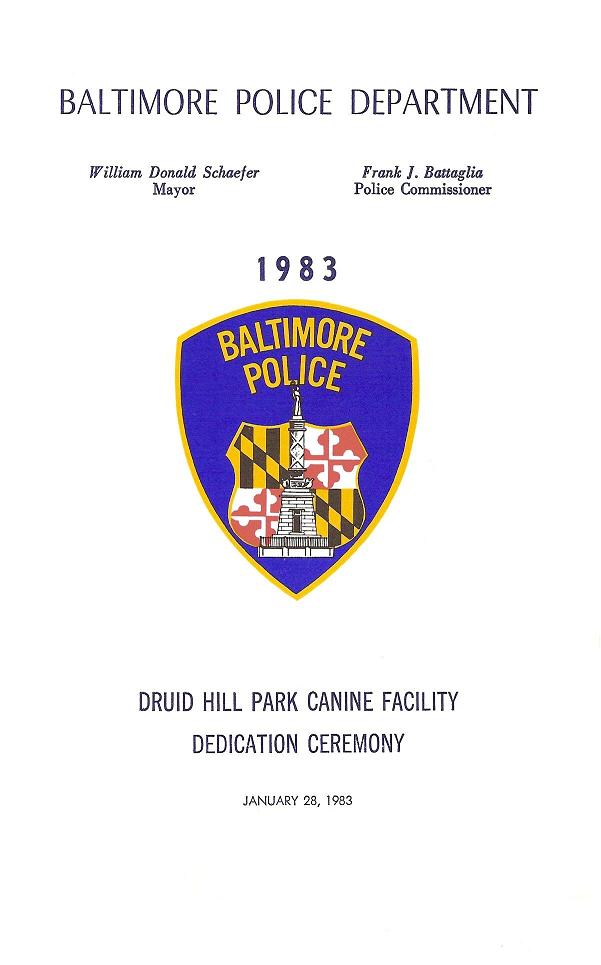
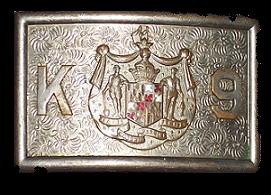
ORIGINAL 1956's K-9 BELT BUCKLE

Photo courtesy Officer Herb Moseley
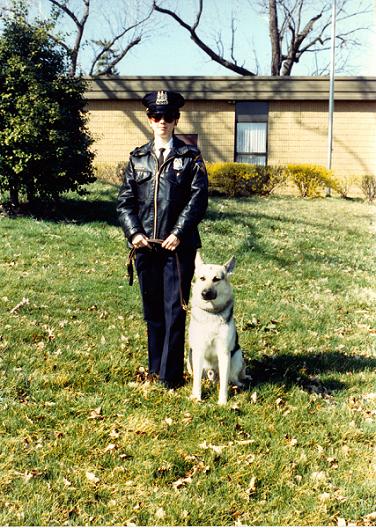
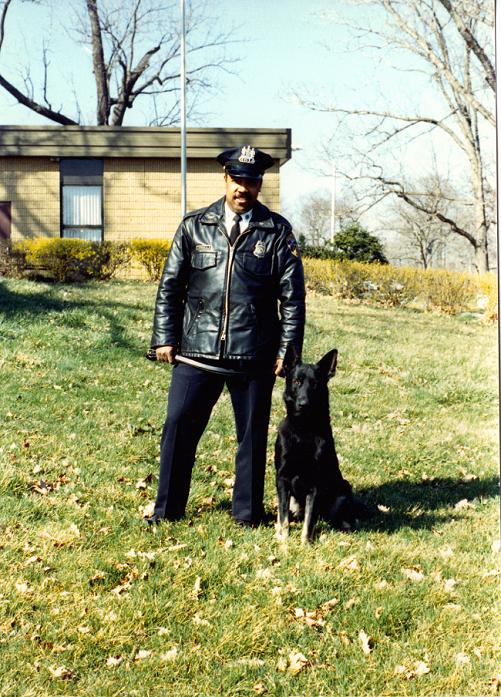
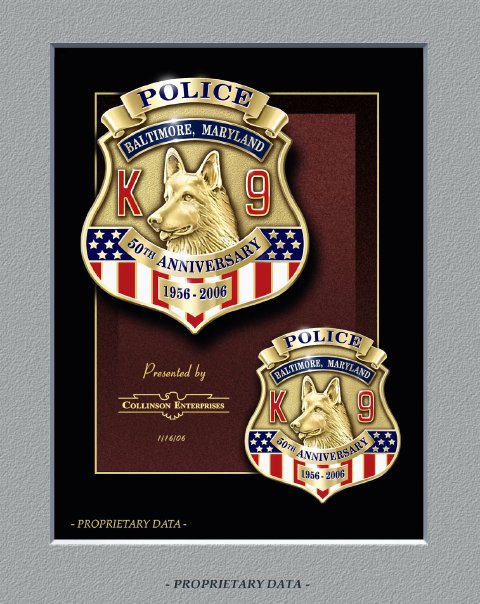
1956-2006 50 years of service to the City of Baltimore.
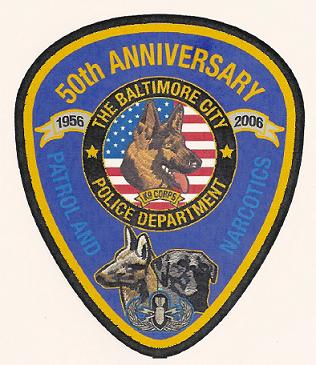
1956-2006 50 years of service to the City of Baltimore.
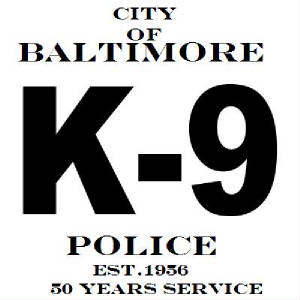
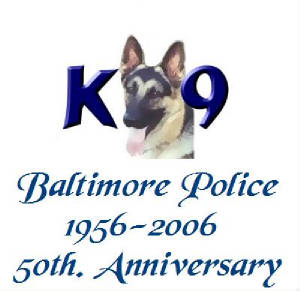
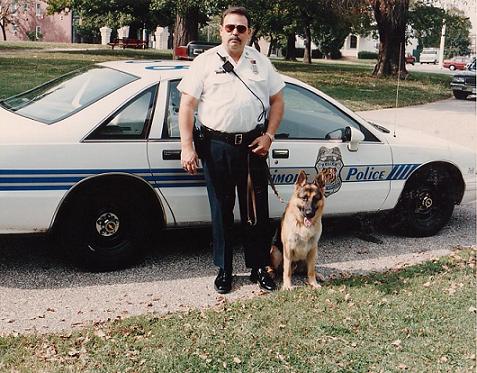
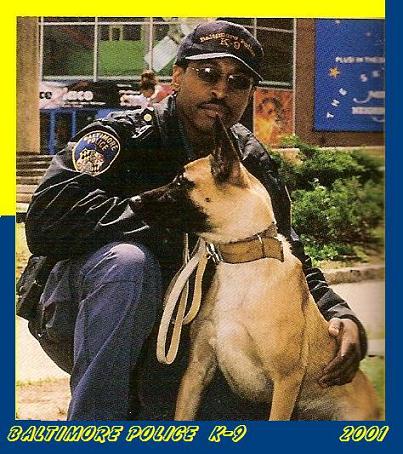
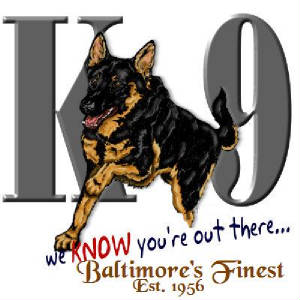
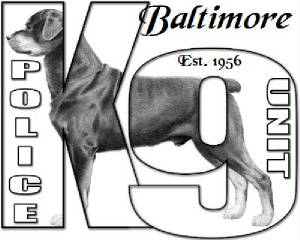
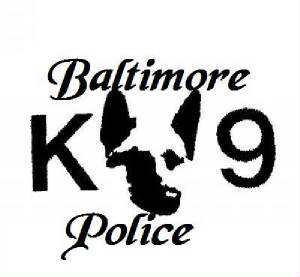
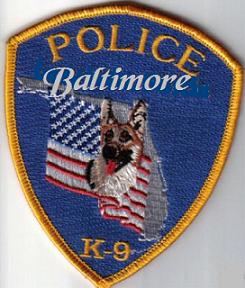
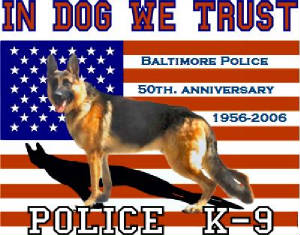
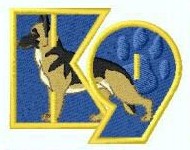

![]()

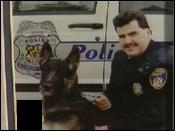
![]()
Baltimore's Oldest Police K9 Dies
21 December 21, 2006

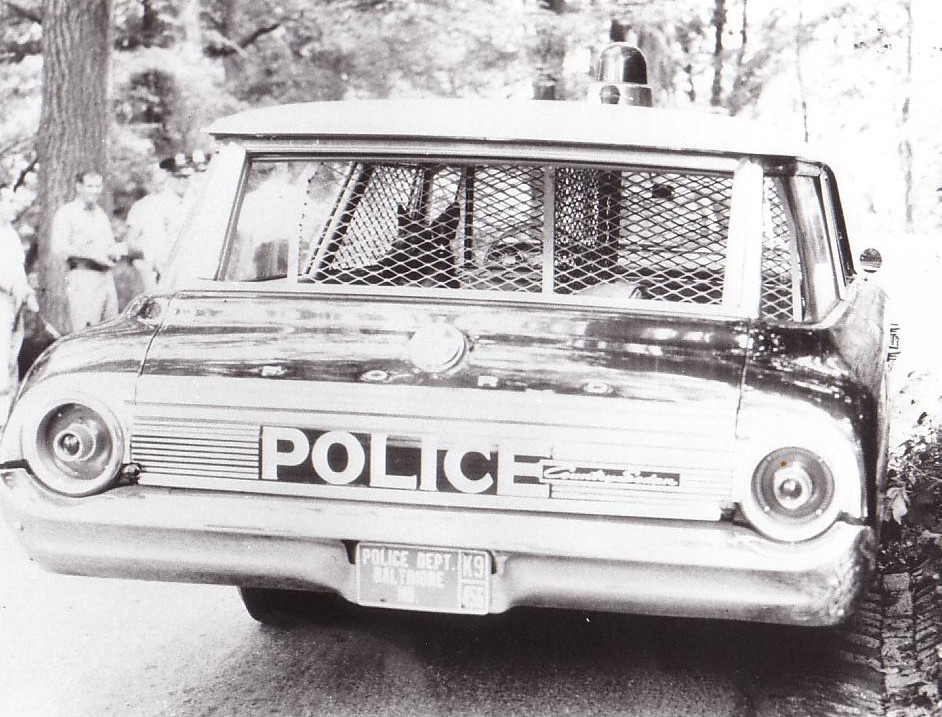
There is sad news from the Baltimore Police Department, as the oldest veteran of its renowned k-9 unit has died. “Reno” was 14, and served 11 years as officer Jerry Turpin's partner, before failing hips, caused him to be put down. With tears in his eyes, Turpin, a 26-year veteran of the force, says "I've lost my best friend. Nobody will ever know what goes on between an officer and his dog." Reno and Jerry hit the streets in 1996 and were inseparable until Reno was injured in the line of duty. In 2005 Reno fell through a window while in pursuit of a suspect which lead to his retirement as a result of the injuries. Reno's sister “Imka” has become Jerry's new partner. There are 28 canines on the city police force which, celebrated its 50th anniversary last March.
![]()
K-9 Corps The Baltimore Police Department, famous for its superior K-9 unit, was somewhat taken back by this recent incident: Returning home from work, a woman was shocked to find her house ransacked and burglarized. She telephoned the police at once and reported the crime. The police dispatcher broadcast the call on the channels and a K-9 unit patrolling nearby was the first to respond. As the K-9 officer approached the house with his dog on a leash, the woman ran out on the porch, shuddered at the sight of the cop and his dog, then sat down on the steps put her face in her hands and moaned, "I come home to find all my possessions stolen. I call the police for help, and what do they do?" "They send me a BLIND policeman!"
![]()
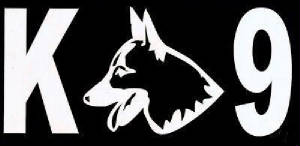
A Police Dogs Prayer
Oh almighty God, whose great power and eternal wisdom embraces the universe, watch over my handler while I sleep. Protect my handler from harm while I am unable to do so. I pray, help keep our streets and homes safe while my handler and I rest. I ask for your loving care because my handler's duty is dangerous. Grant my handler your unending strength and courage in our daily assignments. Dear God, protect my brave handler, grant your almighty protection, unite my handler safely with the family after the tour of duty has ended. I ask nothing for myself. Amen.
Guardians Of The Night
Trust in me my friend for I am your comrade. I will protect you with my last breath When all others have left you And the loneliness of the night closes in, I will be at your side. Together we will conquer all obstacles, And search out those who might wish harm to others. All I ask of you is compassion, The caring touch of your hands. It is for you that I will unselfishly give my life And spend my nights un rested. Although our days together May be marked by the passing of the seasons Know that each day at your side is my reward. My days are measured by The coming and going of your footsteps. I anticipate them at every opening of the door. You are the voice of caring when I am ill. The voice of authority when I've done wrong. Do not chastise me unduly For I am your right arm, The sword at your side. I attempt to do only what you bid of me. I seek only to please you and remain in your favor. Together you and I shall experience A bond only others like us will understand When outsiders see us together Their envy will be measured by their disdain. I will quietly listen to you And pass no judgment, Nor will your spoken words be repeated I will remain ever silent, Ever vigilant, ever loyal. And when our time together is done And you move on in the world Remember me with kind thoughts and tales, For a time we were unbeatable, Nothing passed among us undetected. If we should meet again on another street I will gladly take up your fight, I am a Police Working Dog and together We are guardians of the night.
Life of A Police Dog
We're both partners and buddies in blue. We did school demos and never did wrong, Over the years, my love did grow strong. How I loved to work, stand up and bark, In the back of our car, from light until dark. We went call to call, having fun all the way, Until the call came on that one fateful day. A man with a gun, the dispatcher did say, I jumped from my car when it pointed your way. Before leaving home, I was told by your wife, I knew at that moment, I'd give you my life. The bullet struck hard, steady and true, The bullet struck me, it did not strike you. When you go home, tell your wife I did good, Strong, tall and proud on the ground that I stood. I'm dead and gone now, this much is so true, But I've done my job well in protecting you.
A Working Dog's Oath
They handled themselves with beauty & grace and who could ever forget that beautiful face Whether at work; or at home; whatever the test they always worked hard; and did their best They were real champions; at work or at play but their lives were cut short; suddenly one day While working on the job with their partner one day they put themselves out on a limb; out into harms way They gave the ultimate sacrifice; any dog can give they gave up their life; so someone could live The best of their breed; as his partner and anyone would say many hearts are now broken; that he had to prove it this way Now as the trees are blowing in the gentle breeze the sun is shining; thru the leaves on the trees The meadows are green; and the grass grows tall off in the distance they can see a waterfall As they look over the falls; down through the creek the water flows gently; as a rabbit sneaks a peek Far up above; in the deep blue sky they see the birds soar high; as they fly by They see animals playing; at the bridge by a waterfall chasing each other; and just having a ball They play all day; from morning to night there's no more rain; just warm sunlight Off in the distance; they hear trumpets blow then all the animals look up; and notice a bright glow The harps would play and the angels would sing as they know they've come home; they've earned their wings We remember that they died; in the line of duty and are now with the Lord; sharing in heaven's beauty Off to the meadows now; where they can play and roam free with an occasional rest stop; under a tall oak tree No more bad guys to chase; or bullets to take just a run through the meadow; down to the lake A quick splash in the water; then back to the shore then it's off to the forest; to go play some more These special dogs are back home; up in heaven above they're cradled in God's arm's; and covered with His love We'll light a candle for all of them; in the dark of night in loving memory of all; these very special knights.


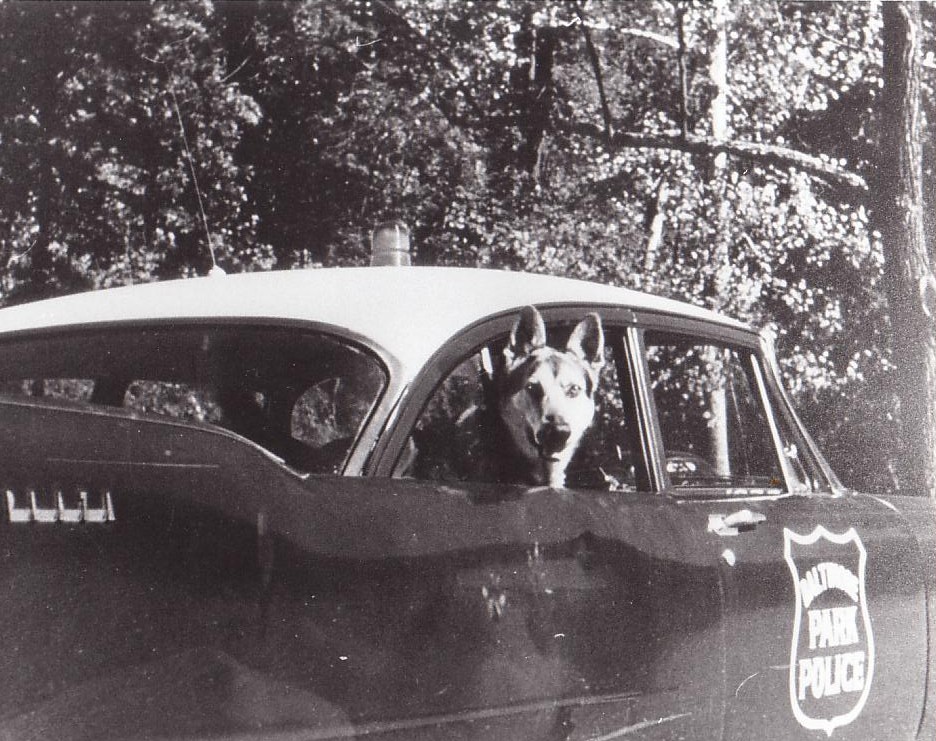
![]()
Baltimore's Oldest Police K9 Dies
21 December 2006
There is sad news from the Baltimore Police Department, as the oldest veteran of its renowned k-9 unit has died. “Reno” was 14, and served 11 years as officer Jerry Turpin's partner, before failing hips, caused him to be put down. With tears in his eyes, Turpin, a 26-year veteran of the force, says "I've lost my best friend. Nobody will ever know what goes on between an officer and his dog." Reno and Jerry hit the streets in 1996 and were inseparable until Reno was injured in the line of duty. In 2005 Reno fell through a window while in pursuit of a suspect which lead to his retirement as a result of the injuries. Reno's sister “Imka” has become Jerry's new partner. There are 28 canines on the city police force which, celebrated its 50th anniversary last March.
![]()
K-9 Corps The Baltimore Police Department, famous for its superior K-9 unit, was somewhat taken back by this recent incident: Returning home from work, a woman was shocked to find her house ransacked and burglarized. She telephoned the police at once and reported the crime. The police dispatcher broadcast the call on the channels and a K-9 unit patrolling nearby was the first to respond. As the K-9 officer approached the house with his dog on a leash, the woman ran out on the porch, shuddered at the sight of the cop and his dog, then sat down on the steps put her face in her hands and moaned, "I come home to find all my possessions stolen. I call the police for help, and what do they do?" "They send me a BLIND policeman!"
![]()
A Police Dogs Prayer
Oh almighty God, whose great power and eternal wisdom embraces the universe, watch over my handler while I sleep. Protect my handler from harm while I am unable to do so. I pray, help keep our streets and homes safe while my handler and I rest. I ask for your loving care because my handler's duty is dangerous. Grant my handler your unending strength and courage in our daily assignments. Dear God, protect my brave handler, grant your almighty protection, unite my handler safely with the family after the tour of duty has ended. I ask nothing for myself. Amen.
Guardians Of The Night
Trust in me my friend for I am your comrade. I will protect you with my last breath When all others have left you And the loneliness of the night closes in, I will be at your side. Together we will conquer all obstacles, And search out those who might wish harm to others. All I ask of you is compassion, The caring touch of your hands. It is for you that I will unselfishly give my life And spend my nights un rested. Although our days together May be marked by the passing of the seasons Know that each day at your side is my reward. My days are measured by The coming and going of your footsteps. I anticipate them at every opening of the door. You are the voice of caring when I am ill. The voice of authority when I've done wrong. Do not chastise me unduly For I am your right arm, The sword at your side. I attempt to do only what you bid of me. I seek only to please you and remain in your favor. Together you and I shall experience A bond only others like us will understand When outsiders see us together Their envy will be measured by their disdain. I will quietly listen to you And pass no judgment, Nor will your spoken words be repeated I will remain ever silent, Ever vigilant, ever loyal. And when our time together is done And you move on in the world Remember me with kind thoughts and tales, For a time we were unbeatable, Nothing passed among us undetected. If we should meet again on another street I will gladly take up your fight, I am a Police Working Dog and together We are guardians of the night.
Life Of A Police Dog
We're both partners and buddies in blue. We did school demos and never did wrong, Over the years, my love did grow strong. How I loved to work, stand up and bark, In the back of our car, from light until dark. We went call to call, having fun all the way, Until the call came on that one fateful day. A man with a gun, the dispatcher did say, I jumped from my car when it pointed your way. Before leaving home, I was told by your wife, I knew at that moment, I'd give you my life. The bullet struck hard, steady and true, The bullet struck me, it did not strike you. When you go home, tell your wife I did good, Strong, tall and proud on the ground that I stood. I'm dead and gone now, this much is so true, But I've done my job well in protecting you.
A Working Dog's Oath
They handled themselves with beauty & grace and who could ever forget that beautiful face Whether at work; or at home; whatever the test they always worked hard; and did their best They were real champions; at work or at play but their lives were cut short; suddenly one day While working on the job with their partner one day they put themselves out on a limb; out into harms way They gave the ultimate sacrifice; any dog can give they gave up their life; so someone could live The best of their breed; as his partner and anyone would say many hearts are now broken; that he had to prove it this way Now as the trees are blowing in the gentle breeze the sun is shining; thru the leaves on the trees The meadows are green; and the grass grows tall off in the distance they can see a waterfall As they look over the falls; down through the creek the water flows gently; as a rabbit sneaks a peek Far up above; in the deep blue sky they see the birds soar high; as they fly by They see animals playing; at the bridge by a waterfall chasing each other; and just having a ball They play all day; from morning to night there's no more rain; just warm sunlight Off in the distance; they hear trumpets blow then all the animals look up; and notice a bright glow The harps would play and the angels would sing as they know they've come home; they've earned their wings We remember that they died; in the line of duty and are now with the Lord; sharing in heaven's beauty Off to the meadows now; where they can play and roam free with an occasional rest stop; under a tall oak tree No more bad guys to chase; or bullets to take just a run through the meadow; down to the lake A quick splash in the water; then back to the shore then it's off to the forest; to go play some more These special dogs are back home; up in heaven above they're cradled in God's arm's; and covered with His love We'll light a candle for all of them; in the dark of night in loving memory of all; these very special knights.
![]()
POLICE INFORMATION
If you have copies of: your Baltimore Police Department Class Photo, Pictures of our Officers, Vehicles, Equipment, Newspaper Articles relating to our department and or officers, Old Departmental Newsletters, Lookouts, Wanted Posters, and or Brochures. Information on Deceased Officers and anything that may help Preserve the History and Proud Traditions of this agency. Please contact Retired Detective Kenny Driscoll.

NOTICE
How to Dispose of Old Police Items
Please contact Det. Ret. Kenny Driscoll if you have any pictures of you or your family members and wish them remembered here on this tribute site to Honor the fine men and women who have served with Honor and Distinction at the Baltimore Police Department. Anyone with information, photographs, memorabilia, or other "Baltimore City Police" items can contact Ret. Det. Kenny Driscoll at
Copyright © 2002 Baltimore City Police History - Ret Det Kenny Driscoll


